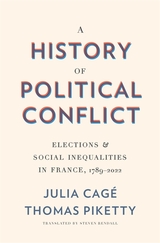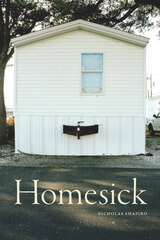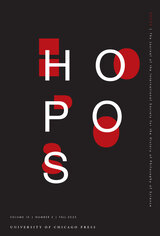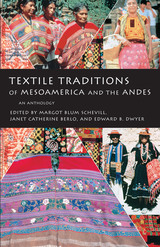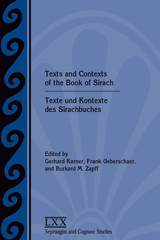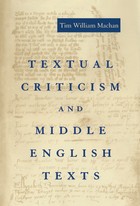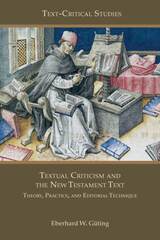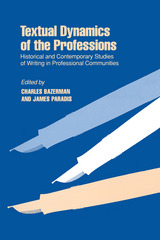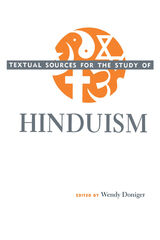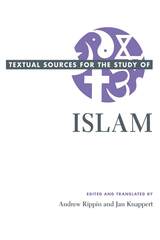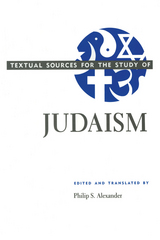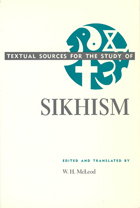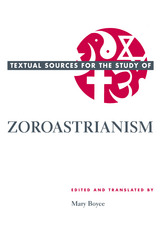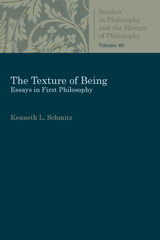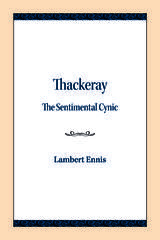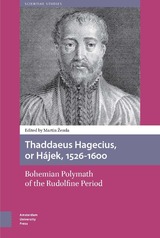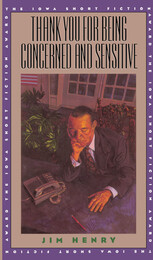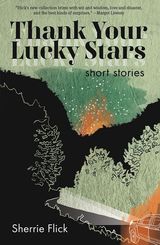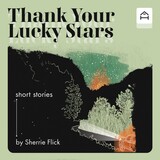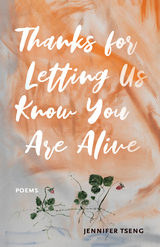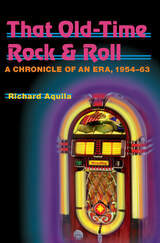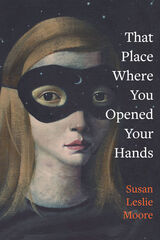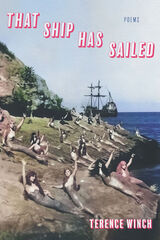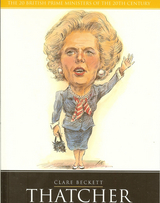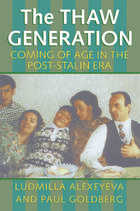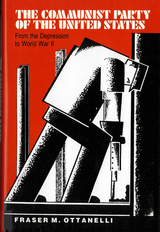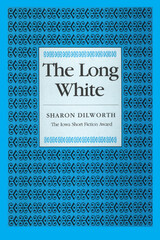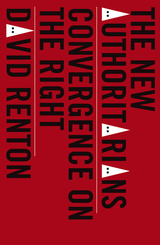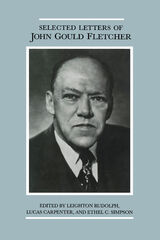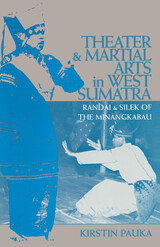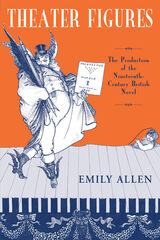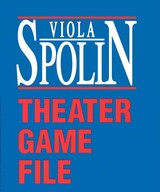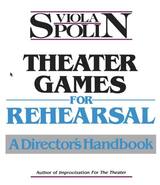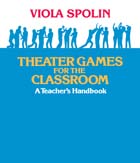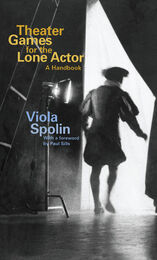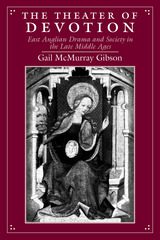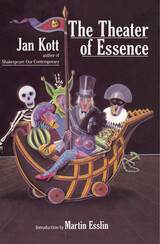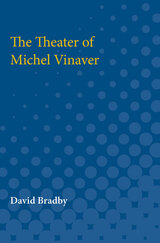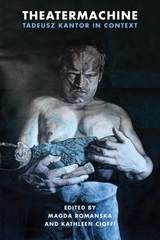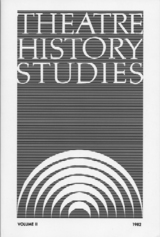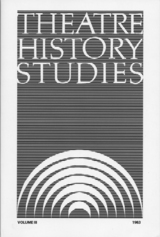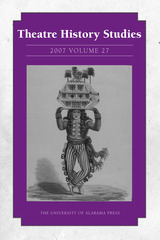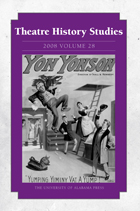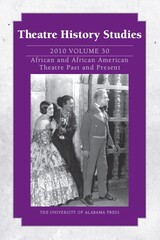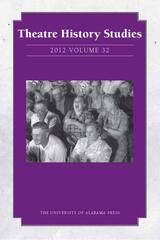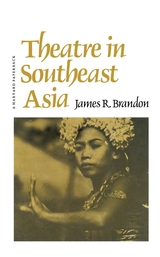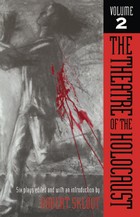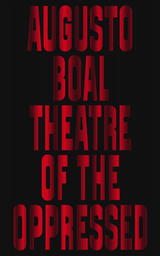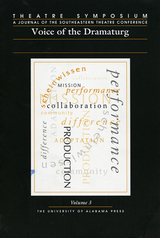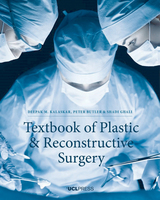 Textbook of Plastic and Reconstructive Surgery
Edited by Deepak K. Kalaskar, Peter E. Butler, and Shadi Ghali
University College London, 2016 Written by experts from London’s renowned Royal Free Hospital, Textbook of Plastic and Reconstructive Surgery offers a comprehensive overview of the vast topic of reconstructive plastic surgery and its various subspecialties for introductory plastic surgery and surgical science courses. The book comprises five sections covering the fundamental principles of plastic surgery, cancer, burns and trauma, paediatric plastic surgery and aesthetic surgery, and covers the breadth of knowledge that students need to further their career in this exciting field. Additional coverage of areas in which reconstructive surgery techniques are called upon includes abdominal wall reconstruction, ear reconstruction and genital reconstruction. A chapter on aesthetic surgery includes facial aesthetic surgery and blepharoplasty, aesthetic breast surgery, body contouring and the evolution of hair transplantation. The broad scope of this volume and attention to often neglected specialisms such as military plastic surgery make this a unique contribution to the field. Heavily illustrated throughout, Textbook of Plastic and Reconstructive Surgery is essential reading for anyone interested in furthering their knowledge of this exciting field. This book was produced as part of JISC's Institution as e-Textbook Publisher project. Find out more at https://www.jisc.ac.uk/rd/projects/institution-as-e-textbook-publisher
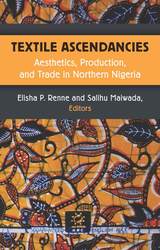 Textile Ascendancies: Aesthetics, Production, and Trade in Northern Nigeria
Elisha P. Renne and Salihu Maiwada, Editors
University of Michigan Press, 2020 Until this century, Northern Nigeria was a major center of textile production and trade. Textile Ascendancies: Aesthetics, Production, and Trade in Northern Nigeria examines this dramatic change in textile aesthetics, technologies, and social values in order to explain the extraordinary shift in textile demand, production, and trade. Textile Ascendancies provides information for the study of the demise of textile manufacturing outside Nigeria. The book also suggests the conundrum considered by George Orwell concerning the benefits and disadvantages of “mechanical progress,” and digital progress, for human existence. While textile mill workers in northern Nigeria were proud to participate in the mechanization of weaving, the “tendency for the mechanization of the world” represented by more efficient looms and printing equipment in China has contributed to the closing of Nigerian mills and unemployment. Textile Ascendancies will appeal toanthropologists for its analyses of social identity as well as how the ethnic identity of consumers influences continued handwoven textile production. The consideration of aesthetics and fashionable dress will appeal to specialists in textiles and clothing. It will be useful to economic historians for the comparative analysis of textile manufacturing decline in the 21st century. It will also be of interest to those thinking about global futures, about digitalization, and how new ways of making cloth and clothing may provide both employment and environmentally sound production practices.
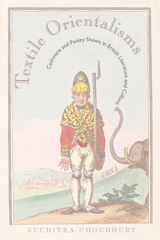 Textile Orientalisms: Cashmere and Paisley Shawls in British Literature and Culture
Suchitra Choudhury
Ohio University Press, 2023 The first major study of Cashmere and Paisley shawls in nineteenth-century British literature, this book shows how they came to represent both high fashion and the British Empire. During the late eighteenth century, Cashmere shawls from the Indian subcontinent began arriving in Britain. At first, these luxury goods were tokens of wealth and prestige. Subsequently, affordable copies known as “Paisley” shawls were mass-produced in British factories, most notably in the Scottish town of the same name. Textile Orientalisms is the first full-length study of these shawls in British literature of the extended nineteenth century. Attentive to the juxtaposition of objects and their descriptions, the book analyzes the British obsession with Indian shawls through a convergence of postcolonial, literary, and cultural theories. Surveying a wide range of materials—plays, poems, satires, novels, advertisements, and archival sources—Suchitra Choudhury argues that while Cashmere and Paisley shawls were popular accoutrements in Romantic and Victorian Britain, their significance was not limited to fashion. Instead, as visible symbols of British expansion, for many imaginative writers they emerged as metaphorical sites reflecting the pleasures and anxieties of the empire. Attentive to new theorizations of history, fashion, colonialism, and gender, the book offers innovative readings of works by Sir Walter Scott, Wilkie Collins, William Thackeray, Frederick Niven, and Elizabeth Inchbald. In determining a key status for shawls in nineteenth-century literature, Textile Orientalisms reformulates the place of fashion and textiles in imperial studies. The book’s distinction rests primarily on three accounts. First, in presenting an original and extended discussion of Cashmere and Paisley shawls, Choudhury offers a new way of interpreting the British Empire. Second, by tracing how shawls represented the social and imperial experience, she argues for an associative link between popular consumption and the domestic experience of colonialism on the one hand and a broader evocation of texts and textiles on the other. Finally, discussions about global objects during the Victorian period tend to overlook that imperial Britain not only imported goods but also produced their copies and imitations on an industrial scale. By identifying the corporeal tropes of authenticity and imitation that lay at the heart of nineteenth-century imaginative production, Choudhury’s work points to a new direction in critical studies.
Textile Traditions of Mesoamerica and the Andes: An Anthology
Edited by Margot Blum Schevill, Janet Catherine Berlo, and Edward B. Dwyer
University of Texas Press, 1996 In this volume, anthropologists, art historians, fiber artists, and technologists come together to explore the meanings, uses, and fabrication of textiles in Mexico, Guatemala, Ecuador, Peru, and Bolivia from Precolumbian times to the present. Originally published in 1991 by Garland Publishing, the book grew out of a 1987 symposium held in conjunction with the exhibit "Costume as Communication: Ethnographic Costumes and Textiles from Middle America and the Central Andes of South America" at the Haffenreffer Museum of Anthropology, Brown University.
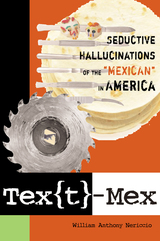 Tex[t]-Mex: Seductive Hallucinations of the "Mexican" in America
By William Anthony Nericcio
University of Texas Press, 2006 A rogues' gallery of Mexican bandits, bombshells, lotharios, and thieves saturates American popular culture. Remember Speedy Gonzalez? "Mexican Spitfire" Lupe Vélez? The Frito Bandito? Familiar and reassuring—at least to Anglos—these Mexican stereotypes are not a people but a text, a carefully woven, articulated, and consumer-ready commodity. In this original, provocative, and highly entertaining book, William Anthony Nericcio deconstructs Tex[t]-Mexicans in films, television, advertising, comic books, toys, literature, and even critical theory, revealing them to be less flesh-and-blood than "seductive hallucinations," less reality than consumer products, a kind of "digital crack." Nericcio engages in close readings of rogue/icons Rita Hayworth, Speedy Gonzalez, Lupe Vélez, and Frida Kahlo, as well as Orson Welles' film Touch of Evil and the comic artistry of Gilbert Hernandez. He playfully yet devastatingly discloses how American cultural creators have invented and used these and other Tex[t]-Mexicans since the Mexican Revolution of 1910, thereby exposing the stereotypes, agendas, phobias, and intellectual deceits that drive American popular culture. This sophisticated, innovative history of celebrity Latina/o mannequins in the American marketplace takes a quantum leap toward a constructive and deconstructive next-generation figuration/adoration of Latinos in America.
 Text/Politics in Island Southeast Asia: Essays in Interpretation
D.M. Roskies
Ohio University Press, 1993 How does the language of poetry conspire with the language of power? This question is at the heart of this volume which deals with Indonesia and the Philippines in the early modern and post-1945 periods. These two nations have been shaped by the forces of nationalism, revolution, and metropolitan hegemony. Whether written in Malay, Tagalog, English, or Dutch the writings coming from them carry the contradictions of their time and place in the milieu of race and class. The contributors examine the literature and politics of Indonesia and Philippines from the point of view of contemporary thinking. Their examinations include the responses of indigenous writers to censorship and to their marginalization and cooption by colonial and neocolonial states. They investigate the rhetoric of spectacle in the Philippines of Ferdinand Marcos, the function of pasyon in Tagalog religious narrative, the writings of Pramoedya Ananta Toer in Indonesia, and the memoirs of a Javanese aristocrat. This book will be of interest to colonial historians and to students and scholars of non-Western and comparative literature.
 Texts and Contexts from the History of Feminism and Women’s Rights: East Central Europe, Second Half of the Twentieth Century
Zsofia Lorand
Central European University Press, 2024 A compendium of one hundred sources, preceded by a short author’s bio and an introduction, this volume offers an English language selection of the most representative texts on feminism and women’s rights from East Central Europe between the end of the Second World War and the early 1990s. While communist era is the primary focus, the interwar years and the post-1989 transition period also receive attention. All texts are new translations from the original. The book is organised around themes instead of countries; the similarities and differences between nations are nevertheless pointed out. The editors consider women not only in their local context, but also in conjunction with other systems of thought—including shared agendas with socialism, liberalism, nationalism, and even eugenics. The choice of texts seeks to demonstrate how feminism as political thought was shaped and organised in the region. They vary in type and format from political treatises, philosophy to literary works, even films and the visual arts, with the necessary inclusion of the personal and the private. Women’s political rights, right to education, their role in nation-building, women, and war (and especially women and peace) are part of the anthology, alongside the gendered division of labour, violence against women, the body, and reproduction.
Texts and Contexts of the Book of Sirach / Texte und Kontexte des Sirachbuches
Gerhard Karner
SBL Press, 2017 Now available from SBL Press Thirteen essays, some in German and others in English, tackle the complicated history of textual transmission of Sirach. This book presents the proceedings of an international conference held in 2014 in Eichstaett, Germany on the text of Ben Sira within its historical contexts.Contributors include James K. Aitken, Pierre-Maurice Bogaert, Franz Böhmisch, Anthony J. Forte SJ, Jan Joosten, Otto Kaiser, Siegfried Kreuzer, Jean-Sébastien Rey, Werner Urbanz, Knut Usener, Oda Wischmeyer, Markus Witte, Benjamin G. Wright, and Burkard M. Zapff.
Features:
- A sociocultural and theological history of Sirach
- Philological and textual problems of the Hebrew, Greek, Syriac, and Latin versions
- Translation strategies based on Greek, Syriac, and Latin text traditions and related hermeneutical questions
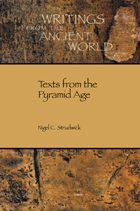 Texts from the Pyramid Age
Nigel C. Strudwick
SBL Press, 2005 Ancient Egypt is well known for its towering monuments and magnificent statuary, but other aspects of its civilization are less well known, especially its written texts. Now Texts from the Pyramid Age provides ready access to new translations of a representative selection of texts ranging from the historically significant to the repetitive formulae of the tomb inscriptions from Old Kingdom Egypt (ca. 2700-2170 B.C.). These royal and private inscriptions, coming from both the secular and religious milieus and from all kinds of physical contexts, not only shed light on the administration, foreign expeditions, and funerary beliefs of the period but also bring to life the Egyptians themselves, revealing how they saw the world and how they wanted the world to see them. Strudwick's helpful introduction to the history and literature of this seminal period provides important background for reading and understanding these historical texts.
 The Texts of Keats’s Poems
Jack Stillinger
Harvard University Press, 1974 Jack Stillinger's concern is with the words of Keats's texts: “I wish,” he says, “to get rid of the wrong ones and to suggest how to go about constructing texts with a greater proportion of the right ones.” He finds that in the two best modern editions of Keats, one third of the texts have one or more wrong words. Modern editors have sometimes based their texts on inferior holograph, transcript, or printed versions; sometimes combined readings from separate versions; sometimes retained words added by copyists and early editors (who frequently made “improvements” when they thought the poems needed them); and sometimes, of course, introduced independent errors of their own.
The heart of this book is a systematic account of the textual history of each of the 150 poems that can reasonably be assigned to Keats. In each history Stillinger dates the work, as closely as it can be dated; gives the details of first publication; specifies the existing variant readings and their sources; and suggests what might be the basis for a standard text.
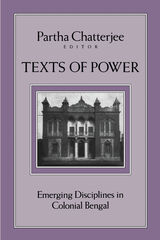 Texts Of Power: Emerging Disciplines in Colonial Bengal
Partha Chatterjee
University of Minnesota Press, 1995 The case of Bengal illustrates the interaction of colonialism and modernity. Bengal was the first “modern” province in India-the first, that is, to undergo a forced encounter with Western modernity. Beginning with this premise, the writers in Texts of Power consider what the case of Bengal says about the workings of Western modernity in a colonial setting. A truly interdisciplinary effort, this collection probes questions of pedagogy, nationalism, and gender. Among the subjects explored are colonialist and nationalist surveillance of Bengali literature; the disposition of the nation’s art; the politics of child-rearing; the mapping of Calcutta; and the disciplining of historical memory. By applying the theoretical insights of recent historical and cultural studies to the specific circumstances of Bengal, the authors develop a new approach to Indian intellectual and cultural history. Their work makes a significant contribution to our understanding of contemporary intellectual modernity.Contributors: Pradip Kumar Bose, Keya Dasgupta, Tapati Guha-Thakurta, all at the Centre for Studies in Social Sciences, Calcutta; Tapti Roy, Maharani Kashiswari College, Calcutta; Ranabir Samaddar, Maulana Azad Institute of Asian Studies.
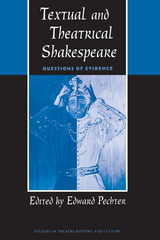 Textual and Theatrical Shakespeare: Questions of Evidence
Edward Pechter
University of Iowa Press, 1996 Shakespeare commentary and performance today present us with a multiplicity of interpretations constructed and reconstructed from such diverse origins that the underlying evidence has become hidden by layers of reconceptualized meanings. What can or should count as evidence for the claims made by scholars and performers, and how should this evidence by organized? In Textual and Theatrical Shakespeare ten essayists answer these stimulating questions by exploring the possibilities for and the constraints upon useful communication among critics who come to Shakespeare from so many different directions.
Bridging the stage-versus-page gap between actors, critics, and scholars, the contributors in this carefully crafted yet energizing book reflect upon the many kinds of evidence available to us from Shakespeare's various incarnations as historical subject and as “our contemporary” as well as from his amphibious occupation of both stage and study. The constraints become arbitrary as each essayist clarifies the sources of this evidence; the seemingly rigid boundaries of scholarly and creative disciplines are crossed and redrawn.
From “How Good Does Evidence Have to Be?” to “Invisible Bullets, Violet Beards: Reading Actors Reading,” the essays in Textual and Theatrical Shakespeare illuminate the long and complex development of our diverse engagements with Shakespeare. Textual and literary scholars, performance critics, social historians, cultural theorists, actors, and theatre historians will appreciate and benefit from this generous spirit of cross-cultural communication.
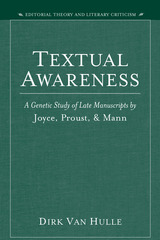 Textual Awareness: A Genetic Study of Late Manuscripts by Joyce, Proust, and Mann
Dirk Van Hulle
University of Michigan Press, 2004 Aware of the act of writing as a temporal process, many modernist authors preserved numerous manuscripts of their works, which themselves thematized time. Textual Awareness analyzes the writing processes in James Joyce's Finnegans Wake, Marcel Proust's À la recherche du temps perdu, and Thomas Mann's Doktor Faustus and relates these to Anglo-American, French, and German theories of text. By relating theory to practice, this comparative study reveals the links between literary and textual criticism.
A key issue in both textual criticism and the so-called crisis of the novel is the tension between the finished and the unfinished. After a theoretical examination of the relationship between genetic and textual criticism, Dirk Van Hulle uses the three case studies to show how?at each stage in the writing process?the text still had the potential of becoming something entirely different; how and why these geneses proceeded the way they did; how Joyce, Proust, and Mann allowed contingencies to shape their work; how these authors recycled the words of their critics in order to inoculate their works against them; how they shaped an intertextual dimension through the processing of source texts and reading notes; and how text continually generated more text.
Van Hulle's exploration of process sheds new light on the remarkable fact that so many modernist authors protected their manuscripts, implying both the authors' urge to grasp everything and their awareness of the dangers of their encyclopedic projects. Textual Awareness offers new insights into the artificiality of the artifact?the novel?that are relevant to the study of literary modernism in general and the study of James Joyce, Marcel Proust, and Thomas Mann in particular. Dirk Van Hulle is Assistant Professor of English and German Literature, University of Antwerp.
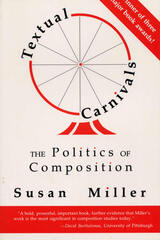 Textual Carnivals: The Politics of Composition
Susan Miller
Southern Illinois University Press, 1993 This is the first book-length study of the status of composition in English studies and the uneasy relationship between composition and literature. Composition studies and institutional histories of English studies have long needed this kind of clarification of the historical and political contexts of composition teaching, research, and administration. Susan Miller argues that composition constitutes a major national industry, citing the four million freshman-level students enrolled in such courses each year, the $40 million annual expenditure for textbooks, and the more than $50 million in teacher salaries. But this concrete magnitude is not expressed in political power within departments. Miller calls on her associates in composition to engage in a persistent critique of the social practices and political agenda of the discipline that have been responsible for its institutional marginalization. Drawing on her own long experience as a composition administrator, teacher, and scholar, as well as on a national survey of composition professionals, Miller argues that composition teachers inadvertently continue to foster the negative myth about composition’s place in the English studies hierarchy by assuming an assigned, self-sacrificial cultural identity. Composition has been regarded as subcollegiate, practical, a "how-to," and has been denied intellectual rigor in order to preserve literature’s presentations of quasi-religious textual ideals. Winner of three major book awards: The Modern Language Association’s Mina P. Shaughnessy Prize The Conference on College Composition and Communication’s Outstanding Book Award The Teachers of Advanced Composition’s W. Ross Winterowd Award
 Textual Confrontations: Comparative Readings in Latin American Literature
Alfred J. Mac Adam
University of Chicago Press, 1987 In this masterful experiment in truly comparative literary criticism, Alfred J. Mac Adam establishes Latin America's place in the Western literary tradition. By juxtaposing Latin American and Anglo-American texts, he shows how Latin American literature has gone beyond the context of Hispanic letters to borrow from, exploit, and finally extend the Western tradition.
Mac Adam describes the changes that have taken place in Latin American literature since the time of Modernismo (roughly 1880-1920), when Spanish American writers tried to update their literary language by imitating foreign, mostly French, literature. Since then, as he demonstrates, Latin American writing has achieved a pioneering status by means of a different kind of imitation—parody—whereby it gives back to the former centers of Western culture their own writing, now distorted and reshaped into something new.
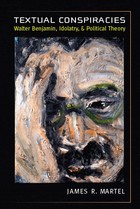 Textual Conspiracies: Walter Benjamin, Idolatry, and Political Theory
James R. Martel
University of Michigan Press, 2012 “This is a sophisticated and fascinating argument written in a very enjoyably entertaining style. It is hard for me to see how readers initially interested in these texts will not be ‘swept off their feet’ by the core assertions of this author, and the devastatingly comprehensive way in which he demonstrates those arguments.”
—Brent Steele, University of Kansas In Textual Conspiracies, James R. Martel applies the literary, theological, and philosophical insights of Walter Benjamin to the question of politics and the predicament of the contemporary left. Through the lens of Benjamin’s theories, as influenced by Kafka, of the fetishization of political symbols and signs, Martel looks at the ways in which various political and literary texts “speak” to each other across the gulf of time and space, thereby creating a “textual conspiracy” that destabilizes grand narratives of power and authority and makes the narratives of alternative political communities more apparent. However, in keeping with Benjamin’s insistence that even he is complicit with the fetishism that he battles, Martel decentralizes Benjamin’s position as the key theorist for this conspiracy and contextualizes Benjamin in what he calls a “constellation” of pairs of thinkers and writers throughout history, including Alexis de Tocqueville and Edgar Allen Poe, Hannah Arendt and Federico García Lorca, and Frantz Fanon and Assia Djebar.
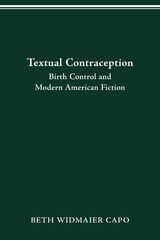 Textual Contraception: Birth Control and Modern American Fiction
Beth Widmaier Capo
Ohio State University Press, 2007 Between the 1910s and 1940s, American women fought for and won the right to legal birth control. This battle was fought in the courts, in the media, and in the pages of American literature. Textual Contraception: Birth Control and Modern American Fiction examines the relationship between aesthetic production and political activism in the birth control movement. It concludes that, by dramatically bringing to life the rhetorical issues, fiction played a significant role in shaping public consciousness. Concurrently, the potential for female control inherent in contraception influenced literary technique and reception, supporting new narrative possibilities for female characters beyond marriage and motherhood.
Merging cultural analysis and literary scholarship, this compelling work moves from a consideration of how cultural forces shaped literary production and political activism to a close examination of how fictional representations of contraception influenced the terms of public discourse on marriage, motherhood, economics, and eugenics.
By analyzing popular fiction such as Mother by Kathleen Norris, radical periodicals such as The Masses and Birth Control Review, and literature by authors from Theodore Dreiser to William Faulkner, and Nella Larsen to Mary McCarthy, Beth Widmaier Capo reveals the rich cross-influence of contraceptive and literary history.
Textual Criticism and the New Testament Text: Theory, Practice, and Editorial Technique
Eberhard W. Güting
SBL Press, 2020 The fruit of more than three decades of research
This collection of fourteen essays by Eberhard W. Güting covers important aspects of editorial science with a particular focus on New Testament textual criticism. Essays cover textual emendation, text-critical procedures, literary criticism, history of scholarship, advantages and disadvantages of online manuscripts, and text-critical studies of words and phrases. The addition of a substantial introduction to text criticism makes this a valuable resource for students and teachers.
Features
- Essays concerned with establishing the original text of New Testament writings
- Nine essays published in English for the first tim
- Two previously unpublished essays
Textual Dynamics: Historical & Contemporary Studies Of
Charles Bazerman
University of Wisconsin Press, 1991 Textual Dynamics of the Professions is a collection of fifteen essays examining the real effects of text on professional practices—in academic, scientific, and business settings. Charles Bazerman and James Paradis describe textual dynamics as an interaction in which professional texts and discourses are constructed by, and in turn construct, social practices. In the burgeoning field of discourse theory, this anthology stands apart in its treatment of a wide range of professional texts, including case studies, student papers, medieval letters, and product instructions, and in the inclusion of authors from a variety of disciplines.
Invaluable to the new pedagogical field of “writing across the curriculum,” Textual Dynamics of the Professions is also a significant intervention into the studies of rhetoric, writing theory, and the sociology of knowledge.
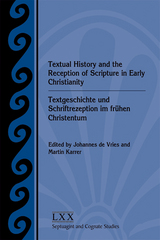 Textual History and the Reception of Scripture in Early Christianity
Johannes de Vries
SBL Press, 2013 The essays in this volume summarize an international research project on early Christian citations from Israel’s scriptures. These quotations are not only theologically significant but are also part of the textual history of the Septuagint and adjacent textual traditions of the Greek and Hebrew Old Testament. The essays discuss relevant manuscripts (Bible codices, papyri, etc.) up to the fifth century, signs and marginal notes (e.g., the diplé) that were used in the ancient scriptoria, and the specifics of the reception history in early Christianity from Matthew to 1 Peter and from the apostolic fathers to Theophilos of Antioch. The contributors are Felix Albrecht, Ronald H. van der Bergh, Heinz-Josef Fabry, Kerstin Heider, Martin Karrer, Christin Klein, Arie van der Kooij, Siegfried Kreuzer, Horacio E. Lona, Martin Meiser, Maarten J. J. Menken, Matthias Millard, Darius Müller, Ferdinand R. Prostmeier, Alexander Stokowski, Martin Vahrenhorst, Christiane Veldboer, and Johannes de Vries.
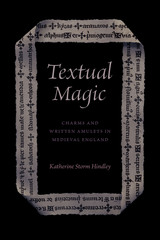 Textual Magic: Charms and Written Amulets in Medieval England
Katherine Storm Hindley
University of Chicago Press, 2023 An expansive consideration of charms as a deeply integrated aspect of the English Middle Ages.
Katherine Storm Hindley explores words at their most powerful: words that people expected would physically change the world. Medieval Europeans often resorted to the use of spoken or written charms to ensure health or fend off danger. Hindley draws on an unprecedented archive of more than a thousand such charms from medieval England—more than twice the number gathered, transcribed, and edited in previous studies and including many texts still unknown to specialists on this topic. Focusing on charms from 1100 to 1350 CE as well as previously unstudied texts in Latin, French, and English, Hindley addresses important questions of how people thought about language, belief, and power. She describes seven hundred years of dynamic, shifting cultural landscapes, where multiple languages, alphabets, and modes of transmission gained and lost their protective and healing power. Where previous scholarship has bemoaned a lack of continuity in the English charms, Hindley finds surprising links between languages and eras, all without losing sight of the extraordinary variety of the medieval charm tradition: a continuous, deeply rooted part of the English Middle Ages.
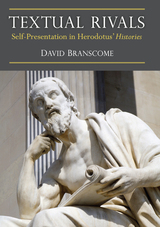 Textual Rivals: Self-Presentation in Herodotus’ Histories
David Branscome
University of Michigan Press, 2013 Textual Rivals studies some of the most debated issues in Herodotean scholarship. One such is Herodotus’ self-presentation: the conspicuousness of his authorial persona is one of the most remarkable features of his Histories. So frequently does he interject first-person comments into the narrative that Herodotus at times almost becomes a character within his own text. Important issues are tied to Herodotus’ self-presentation. First is the narrator’s relationship to truth: to what extent does he expect readers to trust his narrative? While judgments regarding Herodotus’ overall veracity have often been damning, scholars have begun to concentrate on how Herodotus presents his truthfulness. Second is the precise genre Herodotus means to create with his work. Excluding the anachronistic term historian, exactly what would Herodotus have called himself, as author? Third is the presence of “self-referential” characters, whose actions often mirror Herodotus’ as narrator/researcher, in the Histories. David Branscome’s investigative text points to the rival inquirers in Herodotus’ Histories as a key to unraveling these interpretive problems. The rival inquirers are self-referential characters Herodotus uses to further his authorial self-presentation. Through the contrast Herodotus draws between his own exacting standards as an inquirer and the often questionable standards of those rivals, Herodotus underlines just how truthful readers should find his own work. Textual Rivals speaks to those interested in Greek history and historiography, narratology, and ethnography. Those in the growing ranks of Herodotus fans will find much to invite and intrigue.
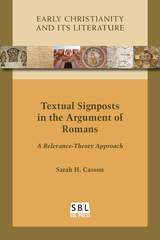 Textual Signposts in the Argument of Romans: A Relevance-Theory Approach
Sarah H. Casson
SBL Press, 2019 A fresh look at the development of Paul’s argument in Romans
The Greek word gar occurs 144 times in Romans and 1,041 times in the entire New Testament. However, many instances of this connective defy easy definition, and the English translation for is often inadequate, obscuring the clue that gar gives to the direction of the communicator’s thought. In this ground-breaking work, Sarah H. Casson argues that gar offers vital guidance to the coherence of Romans. The book applies the cognitive approach of relevance theory to show how garfunctions as an indispensable guide for tracing the significant points of Paul’s argument, helping resolve questions about the coherence of sections, as well as smaller-scale exegetical problems. The work engages with key debates regarding the purpose of Romans and challenges some recent influential interpretations.
Features:
- An exegetically useful understanding of the connective gar
- A new method for determining Paul’s audience and reason for writing
- A challenge to recent key debates and influential interpretations of the purpose of Romans
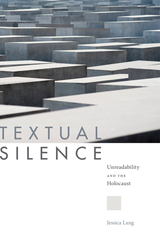 Textual Silence: Unreadability and the Holocaust
Lang, Jessica
Rutgers University Press, 2017 There are thousands of books that represent the Holocaust, but can, and should, the act of reading these works convey the events of genocide to those who did not experience it? In Textual Silence, literary scholar Jessica Lang asserts that language itself is a barrier between the author and the reader in Holocaust texts—and that this barrier is not a lack of substance, but a defining characteristic of the genre.
Holocaust texts, which encompass works as diverse as memoirs, novels, poems, and diaries, are traditionally characterized by silences the authors place throughout the text, both deliberately and unconsciously. While a reader may have the desire and will to comprehend the Holocaust, the presence of “textual silence” is a force that removes the experience of genocide from the reader’s analysis and imaginative recourse. Lang defines silences as omissions that take many forms, including the use of italics and quotation marks, ellipses and blank pages in poetry, and the presence of unreliable narrators in fiction. While this limits the reader’s ability to read in any conventional sense, these silences are not flaws. They are instead a critical presence that forces readers to acknowledge how words and meaning can diverge in the face of events as unimaginable as those of the Holocaust.
Textual Sources for the Study of Hinduism
Edited by Wendy Doniger O'Flaherty
University of Chicago Press, 1990 "A wider range than usual of Sanskrit texts: not only interesting Vedic, epic, and mythological texts but also a good sampling of ritual and ethical texts. . . . There are also extracts from texts usually neglected, such as medical treatises, works on practical politics, and guides to love and marriage. . . . Readings from the vernacular Hindi, Bengali, and Tamil traditions [serve to] enrich the collection and demonstrate how Hinduism flourished not just in Sanskrit but also in its many mother tongues."—Francis X. Clooney, Journal of Asian Studies
Textual Sources for the Study of Islam
Edited by Andrew Rippin and Jan Knappert
University of Chicago Press, 1990 "[This collection] is distinguished by its wide range and the care which has clearly gone into the selection of texts for inclusion. . . . Attention has understandably been focused on what might be called the religious aspects of Islam, such as scripture, theology, sects, law, ritual and mysticism, but within those limits the texts chosen are marked by substantially of content, by geographical, chronological and social diversity, and by an intelligent use of less well known authors. . . . An excellent starting point for a systematic and analytical examination of Islam."—G. R. Hawting, Bulletin of the School of Oriental and African Studies
Textual Sources for the Study of Judaism
Edited and Translated by Philip S. Alexander
University of Chicago Press, 1990 "Alexander assembles material from Scripture and tradition, through religious law and ethical literature to a section on Society and the Jews, and prefaces the whole with an admirable introduction."—Jonathan Sacks, Jewish Chronicle
"The texts . . . which are drawn from over two thousand years of history, are usefully divided, annotated and glossed. They enable students to explore the tradition in a new way [and] give a marvellous insight into the richness and liveliness of the Jewish religion and culture: we are given wit and pathos in addition to popular story and religious law."—Janet Trotter, Resource
Textual Sources for the Study of Sikhism
Edited by W.H. McLeod
University of Chicago Press, 1990 "McLeod is a renowned scholar of Sikhism. . . . [This book] confirms my view that there is nothing about the Sikhs or their religion that McLeod does not know and there is no one who can put it across with as much clarity and brevity as he can. In his latest work he has compressed in under 150 pages the principal sources of the Sikh religion, the Khalsa tradition and the beliefs of breakaway sects like the Nirankaris and Namdharis. . . . As often happens, an outsider has sharper insight into the workings of a community than insiders whose visions are perforce restricted."—Khushwant Singh, Hindustan Times
Textual Sources for the Study of Zoroastrianism
Edited by Mary Boyce
University of Chicago Press, 1990 "Boyce is a, perhaps the, world authority on Zoroastrianism. . . . Prefaced by a 27-page introduction, this anthology contains selections which offer a complete picture of Zoroastrian belief, worship and practice. There are historical texts from the sixth century B.C. onwards, and extracts from modern Zoroastrian writings representing traditionalism, occultism and reformist opinion. Anyone wishing to know more about this 'least well known of the world religions' should sample these selections."—The Methodist Church
"Wide-ranging. . . . An indispensable one-volume collection of primary materials."—William R. Darrow, Religious Studies Review
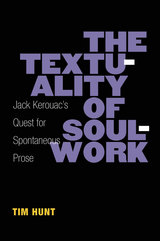 The Textuality of Soulwork: Jack Kerouac's Quest for Spontaneous Prose
Tim Hunt
University of Michigan Press, 2014 Tim Hunt’s The Textuality of Soulwork: Jack Kerouac’s Quest for Spontaneous Prose examines Kerouac’s work from a new critical perspective with a focus on the author’s unique methods of creating and working with text. Additionally, The Textuality of Soulwork delineates Kerouac’s development of “Spontaneous Prose” to differentiate the preliminary experiment of On the Road from the more radical experiment of Visions of Cody, and to demonstrate Kerouac’s transition from working within the textual paradigm of modern print to the textual paradigm of secondary orality. From these perspectives, Tim Hunt crafts a new critical approach to Beat poetics and textual theory, marking an important contribution to the current revival of Kerouac and Beat studies underway at universities in the U.S. and abroad, as reflected by a growing number of conferences, courses, and a renewal in scholarship.
The Texture of Being: Essays in First Philosophy
Kenneth L. Schmitz
Catholic University of America Press, 2007 Diverse in topics yet unified in purpose, this volume brings together Schmitz's penetrating and rich insight into being, produced over many years, to offer readers a magisterial study from one of the great Christian philosophers of our time.
 The Texture of Change: Dress, Self-Fashioning, and History in Western Africa, 1700–1850
Jody Benjamin
Ohio University Press, 2024 The Texture of Change examines historical change across a broad region of western Africa—from Saint Louis, Senegal, to Freetown, Sierra Leone—through the development of textile commerce, consumption, and dress. Indigo-dyed and printed cotton, wool, linen, and silk cloths constituted major trade items that linked African producers and consumers to exchange networks that were both regional and global. While much of the historiography of commerce in Africa in the eighteenth century has focused on the Atlantic slave trade and its impact, this study follows the global cloth trade to account for the broad extent and multiple modes of western Africa’s engagement with Europe, Asia, and the Americas.
Jody Benjamin analyzes a range of archival, visual, oral, and material sources drawn from three continents to illuminate entanglements between local textile industries and global commerce and between the politics of Islamic reform and encroaching European colonial power. The study highlights the roles of a diverse range of historical actors mentioned only glancingly in core-periphery or Atlantic-centered framings: women indigo dyers, maroon cotton farmers, petty traveling merchants, caravan guides, and African Diaspora settlers. It argues that their combined choices within a set of ecological, political, and economic constraints structured networks connecting the Atlantic and Indian Ocean perimeters.
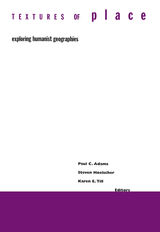 Textures Of Place: Exploring Humanist Geographies
Paul Adams
University of Minnesota Press, 2001 Essays that point to the emergence of a critical humanist geography. Geography/ Cultural Studies Essays that point to the emergence of a critical humanist geography.A fresh and far-ranging interpretation of the concept of place, this volume begins with a fundamental tension of our day: as communications technologies help create a truly global economy, the very political-economic processes that would seem to homogenize place actually increase the importance of individual localities, which are exposed to global flows of investment, population, goods, and pollution. Place, no less today than in the past, is fundamental to how the world works.The contributors to this volume-distinguished scholars from geography, art history, philosophy, anthropology, and American and English literature-investigate the ways in which place is embedded in everyday experience, its crucial role in the formation of group and individual identity, and its ability to reflect and reinforce power relations. Their essays draw from a wide array of methodologies and perspectives-including feminism, ethnography, poststructuralism, ecocriticism, and landscape iconography-to examine themes as diverse as morality and imagination, attention and absence, personal and group identity, social structure, home, nature, and cosmos. Contributors: Anne Buttimer, U College Dublin; Edward S. Casey, SUNY Stony Brook; Denis Cosgrove, UCLA; Tim Cresswell, U of Wales, Aberystwyth; Michael Curry, UCLA; Dydia DeLyser, Louisiana State U; James S. Duncan, U of Cambridge; Nancy G. Duncan, U of Cambridge; J. Nicholas Entrikin, UCLA; William Howarth, Princeton U; John Paul Jones III, U of Kentucky; David Ley, U of British Columbia; David Lowenthal, U College London; Karal Ann Marling, U of Minnesota; Patrick McGreevy, Clarion U; Kenneth R. Olwig, U of Trondheim, Norway; Marijane Osborn, UC Davis; Gillian R. Overing, Wake Forest U; Edward Relph, U of Toronto; Miles Richardson, Louisiana State U; Robert D. Sack, U of Wisconsin-Madison; Jonathan M. Smith, Texas A&M U; Yi-Fu Tuan, U of Wisconsin-Madison; April R. Veness, U of Delaware; and Wilbur Zelinsky, Pennsylvania State U.ISBN 0-8166-3756-3 Cloth £45.00 $64.95xxISBN 0-8166-3757-1 Paper £18.00 $25.95x576 Pages 34 black-and-white photos, 1 table 7 x 10 FebruaryTranslation Inquiries: University of Minnesota Press
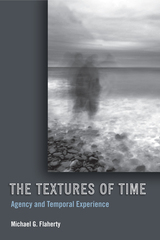 The Textures of Time: Agency and Temporal Experience
Authored by Michael G. Flaherty
Temple University Press, 2010 What do we mean when we say, "I made the time pass more quickly," or, "I’m creating some ‘me’ time"? InThe Textures of Time, Michael Flaherty examines how we alter or customize our experience of time. His detailed analysis reveals different strategies we use to try to manipulate time, further describing and defining those strategies within six discrete time categories: Duration, Frequency, Sequence, Timing, Allocation, and Taking Time. Using in-depth interviews and analyzing responses through a sociological lens, Flaherty unearths folk theories and practices, which he calls "time work," that construct circumstances in order to provoke desired forms of temporal experience. As such, time is not justinflicted on us; rather, its various textures result from our intervention, and/or from our efforts to create different forms of temporal experience. These first-person accounts also highlight ongoing tensions between agency and determinism in social groups. Ultimately, in keeping with his central thesis, Flaherty's lucid prose make this book a quick read, and the strategies he describes reveal the profound and inventive ways we "manage the clock."
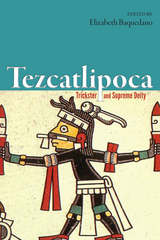 Tezcatlipoca: Trickster and Supreme Deity
Elizabeth Baquedano
University Press of Colorado, 2020 Tezcatlipoca: Trickster and Supreme Deity brings archaeological evidence into the body of scholarship on “the lord of the smoking mirror,” one of the most important Aztec deities. While iconographic and textual resources from sixteenth-century chroniclers and codices have contributed greatly to the understanding of Aztec religious beliefs and practices, contributors to this volume demonstrate the diverse ways material evidence expands on these traditional sources. The interlocking complexities of Tezcatlipoca’s nature, multiple roles, and metaphorical attributes illustrate the extent to which his influence penetrated Aztec belief and social action across all levels of late Postclassic central Mexican culture. Tezcatlipoca examines the results of archaeological investigations—objects like obsidian mirrors, gold, bells, public stone monuments, and even a mosaic skull—and reveals new insights into the supreme deity of the Aztec pantheon and his role in Aztec culture.
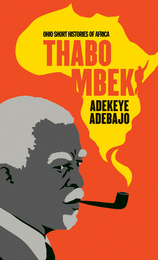 Thabo Mbeki
Adekeye Adebajo
Ohio University Press, 2017 Former South African president Thabo Mbeki is a complex figure. He was a committed young Marxist who, while in power, embraced conservative economic policies and protected white corporate interests; a rational and dispassionate thinker who was particularly sensitive to criticism and dissent; and a champion of African self-reliance who relied excessively on foreign capital. As a key liberation leader in exile, he was instrumental in the ANC’s antiapartheid struggle. Later, he helped build one of the world’s most respected constitutional democracies. As president, though, he was unable to overcome inherited socioeconomic challenges, and his disastrous AIDS policies will remain a major blotch on his legacy. Mbeki is the most important African political figure of his generation. He will be remembered as a foreign policy president for his peacemaking efforts and his role in building continental institutions, not least of which was the African Union. In this concise biography, ideally suited for the classroom, Adekeye Adebajo seeks to illuminate Mbeki’s contradictions and situate him in a pan-African pantheon.
Thackeray: The Sentimental Cynic
Lambert Ennis
Northwestern University Press, 1950 Thackeray: The Sentimental Cynic chronicles British novelist William Thackeray's ambivalent attitudes toward society and traces his conduct during the major crises of his life in terms of those attitudes. Lambert Ennis examines the emotional tensions in Thackeray’s life and the impact they had in his work. In so doing, he illustrates key themes in Victorian studies more broadly: the question of manners and taste and the relationship between sentimentality and authenticity, and the ways that sentimentality might shape morality.
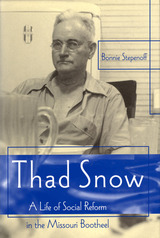 Thad Snow: A Life of Social Reform in the Missouri Bootheel
Bonnie Stepenoff
University of Missouri Press, 2003 Thad Snow (1881–1955) was an eccentric farmer and writer who was best known for his involvement in Missouri’s 1939 Sharecropper Protest—a mass highway demonstration in which approximately eleven hundred demonstrators marched to two federal highways to illustrate the plight of the cotton laborers. Snow struggled to make sense of the changing world, and his answers to questions regarding race, social justice, the environment, and international war placed him at odds with many. In Thad Snow, Bonnie Stepenoff explores the world of Snow, providing a full portrait of him. Snow settled in the Missouri Bootheel in 1910—“Swampeast Missouri,” as he called it—when it was still largely an undeveloped region of hardwood and cypress swamps. He cleared and drained a thousand acres and became a prominent landowner, highway booster, and promoter of economic development—though he later questioned the wisdom of developing wild land. In the early 1920s, “cotton fever” came to the region, and Snow started producing cotton in the rich southeast Missouri soil. Although he employed sharecroppers, he became a bitter critic of the system that exploited labor and fostered racism. In the 1930s, when a massive flood and the Great Depression heaped misery on the farmworkers, he rallied to their cause. Defying the conventions of his class, he invited the Southern Tenant Farmers’ Union (STFU) to organize workers on his land. He became a friend and colleague of Owen Whitfield, an African American minister, who led the Sharecroppers’ Roadside Strike of 1939. The successes of this great demonstration convinced Snow that mankind could fight injustice by peaceful means. While America mobilized for World War II, he denounced all war as evil, remaining a committed pacifist until his death in 1955. Shortly before he died, Snow published an autobiographical memoir, From Missouri, in which he affirmed his optimistic belief that people could peacefully change the world. This biography places Snow in the context of his place and time, revealing a unique individual who agonized over racial and economic oppression and environmental degradation. Snow lived, worked, and pondered the connections among these issues in a small rural corner of Missouri, but he thought in global terms. Well-crafted and highly readable, Thad Snow provides an astounding assessment of an agricultural entrepreneur transformed into a social critic and an activist.
Thaddaeus Hagecius, or Hájek, 1526-1600: Bohemian Polymath of the Rudolfine Period
Martin Zemla
Amsterdam University Press, 2025 Tadeas Hajek of Hajek (1526–1600), Latinized as Thaddaeus Hagecius ab Hagek/Hayek, was a key figure in early scientific debates not only in his native Bohemia. A versatile scholar and polymath, he was prolific in medicine, botany, mathematics and astronomy. Modern interpreters tended to point out his astronomical interpretations to emphasize his greatest achievements and his “modernity.” However, Hajek also drew extensively on traditional arts such as alchemy, astrology and metoposcopy. In this volume, the contributors study various aspects of Hayek’s thought to present a less tendentious intellectual portrait of him in the context of his times. Even from this more adequate perspective, he remains an important figure in the dialectical process of transmitting ideas whose influence extended far beyond the Czech lands.
 Thaddeus Mosley: African American Sculptor
David Lewis
University of Pittsburgh Press, 1997
Thaddeus “Thad” Mosley is a self-taught African American sculptor. Earning a living throughout his adult life as a postal worker in Pittsburgh, Pennsylvania, so that he could support his family by day and work as a sculptor by night, he has evolved an individual and powerful African American voice. He worked alone, patiently developing a sculptural language absolutely his own, yet traceable to his primary sources of inspiration, the vitality of African art and American jazz on the one hand, and on the other, two twentieth-century artists, the Romanian sculptor Constantin Brancusi and the Asian American sculptor Isamu Noguchi.
From the beginning Thad Mosley has been a carver. His materials have always been those “at hand,” logs from the trees of his native Western Pennsylvania, stones from the sites of demolished buildings in Pittsburgh, and metals from local scrapyards. Finding within each log or block of stone an essential vitality, his carvings invariably bear a syncopation of chisel marks evoking the rhythms and surging freedoms of jazz. Mosley’s perseverence and his pride in who he is offer an inspiring example of the unquenchable spirit of a true artists.
This short book introduces the life and work of this remarkable man. Davis Lewis, architect, writer, and painter, has been a friend of the artist for twenty-five years. His narrative is distilled from hours of taped interviews with Thad Mosley, as well as from a deep understanding of his art and influences. Lonnie Graham is a nationally known African-American photographer.
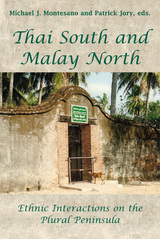 Thai South and Malay North: Ethnic Interactions on a Plural Peninsula
Edited by Michael J. Montesano and Patrick Jory
National University of Singapore Press, 2008 The portion of the Malay Peninsula where the Thai Buddhist civilization of Thailand gives way to the Malay Muslim civilization of Malaysia is characterized by multiple forms of pluralism. An appreciation of the long history and varied forms of that pluralism opens up fresh and important perspectives on the violent crisis currently affecting southern Thailand.
Thai South and Malay North brings together research by academic specialists working on this border zone who examine a broad range of issues relating to the turmoil afflicting the region. Drawing on a broad historical perspective, the authors explore religious observances and national identity, the relationship between electoral democracy and separatist violence, and interactions between northern Malaysia and southern Thailand.
Intellectually rigorous and theoretically sophisticated, Thai South and Malay North is the most comprehensive work to date on a part of Southeast Asia whose historical, linguistic, and political complexity has long defied scholarly synthesis—essential reading for anyone seeking to understand southern Thailand 's complex past and troubled present.
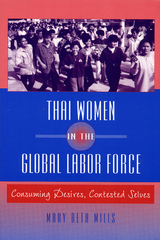 Thai Women in the Global Labor Force: Consuming Desires, Contested Selves
Mills, Mary Beth
Rutgers University Press, 1999 Most research on female labor migration in Thailand focuses on that country's infamous sex industry. Mary Beth Mills offers the first extended ethnographic analysis of rural women's movement into less visible occupations, paying particular attention to the hundreds of thousands of young women who fill the factories and sweatshops of the Bangkok metropolis. Mills follows the women as they travel from the village of Baan Naa Sakae to Bangkok, where they encounter new forms of consumption, new "modern" lifestyles, and a new sense of identity. She finds this rural-urban migration is more than a simple economic activity, but rather an elaborate process of cultural change.
Mills describes the environments from which these women left, as well as the urban landscape they now call home. Hence, she examines key aspects of rural Thai community life, such as local consumption practices, gender roles, and the familial tensions that are often the catalyst to labor migration. Then she focuses on the city and the underlying tensions of urban employment as migrants pursue newly imagined identities as modern women, while still upholding economic and moral responsibilities to rural kin.
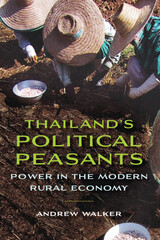 Thailand’s Political Peasants: Power in the Modern Rural Economy
Andrew Walker
University of Wisconsin Press, 2012 When a populist movement elected Thaksin Shinawatra as prime minister of Thailand in 2001, many of the country’s urban elite dismissed the outcome as just another symptom of rural corruption, a traditional patronage system dominated by local strongmen pressuring their neighbors through political bullying and vote-buying. In Thailand’s Political Peasants, however, Andrew Walker argues that the emergence of an entirely new socioeconomic dynamic has dramatically changed the relations of Thai peasants with the state, making them a political force to be reckoned with. Whereas their ancestors focused on subsistence, this generation of middle-income peasants seeks productive relationships with sources of state power, produces cash crops, and derives additional income through non-agricultural work. In the increasingly decentralized, disaggregated country, rural villagers and farmers have themselves become entrepreneurs and agents of the state at the local level, while the state has changed from an extractor of taxes to a supplier of subsidies and a patron of development projects.
Thailand’s Political Peasants provides an original, provocative analysis that encourages an ethnographic rethinking of rural politics in rapidly developing countries. Drawing on six years of fieldwork in Ban Tiam, a rural village in northern Thailand, Walker shows how analyses of peasant politics that focus primarily on rebellion, resistance, and evasion are becoming less useful for understanding emergent forms of political society.
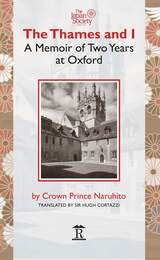 The Thames and I: A Memoir by Prince Naruhito of Two Years at Oxford
Naruhito
Amsterdam University Press, 2019 Prior to becoming Crown Prince of Japan in 1989, following the death of his grandfather Emperor Showa, Prince Naruhito studied at Merton College, Oxford, from June 1983 to October 1985. His research topic was the River Thames as a commercial highway in the eighteenth century. This marked the first time that anyone in direct succession to the throne had ever studied outside Japan. In 1992, he published a record of his time at Oxford under the title Thames no tomo ni . The memoir, which includes a colour plate section incorporating photographs taken by the Prince, explores his daily life, studies and recreational experiences, including discovering beer and being banned from entering a disco because he was wearing jeans. The Thames and I is a remarkable record, not least because of its candour, but equally because it reveals the Crown Prince as an individual, including his personal charm and sense of humour. It will be of special interest to those wishing to know more about the future emperor of Japan.
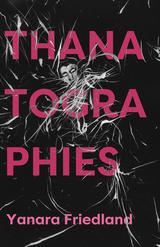 Thanatographies
Yanara Friedland
University of Alabama Press, 2026 A haunting, poetic excavation of memory, the nocturnal imagination, and a search for new forms of language to act upon legacies of violence and erasure. Thanatographies is a genre-defying meditation on disappearance, memory, and the porous boundaries between the living and the dead. In poetic prose, Yanara Friedland weaves together dreamscapes, historical fragments, personal recollections, and philosophical inquiry to explore the afterlives of loss and survival. Moving through rooms, cities, forests, and archives, the text becomes a living document of insomnia, exile, and the spectral presence of women across time, including artists, revolutionaries, caretakers, and ghosts. Structured in four sections titled Room, Night, Medusas, and Burials, the book traverses inner and outer landscapes, from Berlin’s haunted streets to the intimate terrain of the body. Friedland’s voice is both lyrical and incisive, drawing on figures such as Unica Zürn, Rosa Luxemburg, and Else Lasker-Schüler to illuminate the intersections of gender, violence, and historical erasure. The result is a deeply embodied poetics of wakefulness, where hidden life remembers and speaks. Thanatographies is written for readers of experimental literature, feminist theory, and contemporary poetics. It will appeal to those who are drawn to the work of Clarice Lispector, Bhanu Kapil, and Anne Carson. The book resonates with artists, scholars, and seekers who are compelled by the aesthetics of mourning, the politics of memory, and the radical potential of language to hold what is otherwise unspeakable.
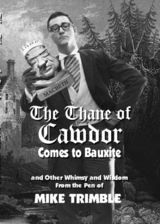 The Thane of Cawdor Comes to Bauxite: And Other Whimsy and Wisdom From the Pen of Mike Trimble
Ernie Dumas
Butler Center for Arkansas Studies, 2024 “Although of a relatively scarce breed,” the Arkansas Times observed in the obituary of the itinerant writer it had once employed, “Mike Trimble was Arkansas’s and perhaps the country’s greatest self-deprecating journalist.” Readers will find in this fifty-year inventory of Trimble’s wit and wisdom all the vindication they might seek for that quaint judgment—the rare humble author. Whether he was chronicling, in the 1980s, rising political worthies like the far-into-the-future governors Asa Hutchinson and Mike Beebe, or, more often, the ordinary and feckless people that he encountered every day, befriended, and spent most of his career writing about, Trimble usually found a way, subtly or artlessly, to bring up his own failings, such as identifying the wrong person as the dead woman in an obituary he had written in his earliest days for his first employer, the Texarkana Gazette. Like the yokels in the vaudeville duos Laurel and Hardy, Abbott and Costello, Rowan and Martin, and Fey and Poehler, Trimble’s confessed bumblings were purposeful and studied instruments of his humor. Arkansas produced more than its quota of weirdos, fabulists, con men, oleaginous politicians, charlatans, creeps, visionaries, and fantastical creatures—from Albert Pike, Arvin the Wino, Dr. Brinkley the Great Depression’s goat-gland sex therapist, Editor Weston, and the salty riverboat queen Ray Dorthy all the way to Say McIntosh and Red the Irish Setter. Mike Trimble, the South’s best and funniest storyteller, put them all down on paper for some of the best reading since Catch-22. Trimble turned humor into art and history into vaudeville.
Thank You for Being Concerned and Sensitive
Jim Henry
University of Iowa Press, 1997 Jim Henry's stories defy convention. There are no easy answers, no quick fixes. Although the plots vary—from a corpse returning to visit his family weeks after his burial, to the musings of a congressman grappling with the weight of history, to a wealthy family's elaborate plot to cheer their mysteriously wounded mother—all express a sense of the extraordinary in the ordinary, the absurd in the everyday. Henry's characters are for the most part misfits, outsiders looking in on a world whose seemingly natural order is turned upside down. In a throw-away culture obsessed with sex and drugs, money and God, they struggle to connect with what is real while trying to convince themselves that anything is. And yet in the midst of their existential searching there remains always Henry's quirky sense of humor. As one character says, “Anything is possible,” and in this collection anything and everything happens.
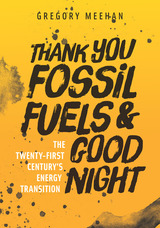 Thank You Fossil Fuels and Good Night: The 21st Century's Energy Transition
Gregory Meehan
University of Utah Press, 2017 Everything is subject to a lifecycle. In the field of energy, the obvious question is, “Where are we in the lifecycle of fossil fuels?” Competitive technology for sourcing renewable energy, marketplace readiness, and pressures from climate change all signal that the fossil fuel era is coming to an end. This book explains the alternatives and suggests when and how change will occur. Employing a global perspective and detailed analysis, it provides recommendations on policies and strategies to make a smooth and wholesale transition to renewables before the continued use of fossil fuels becomes economically and socially disruptive.
Gregory Meehan’s overview eschews politics in favor of comprehensive coverage and logical explanation. He addresses economic, environmental, and security concerns and does not shy away from illuminating limitations and problems with various energy sources. Meehan’s dogged pursuit of the current state of knowledge and energy practices around the world shows that different answers are proving viable for different social and environmental contexts. This is the most wide-ranging and thorough introduction to the world’s energy issues and choices to date. Lecture and exercise guides available upon request.
Click here to hear the Friends of the Marriott Library event with Gregory Meehan. https://youtu.be/YqmNhEN09_c
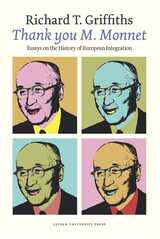 ‘Thank you M. Monnet’: Essays on the History of European Integration
Richard Griffiths
Amsterdam University Press, 2013 This book collects contributions by Richard T. Griffiths on the history of European integration, some published for the first time in English. The essays range in chronology from the early experiences with the Marshall Plan to the difficulties and opportunities for the EFTA countries afforded by association with the EEC in the 1970s and 80s. The book interprets European integration far wider than simply the current European Union and its forerunners. Thus, it devotes chapters to EFTA, the OECD, and to issues as agriculture, cartels and monetary problems. The volume also contains the essay in the title which poses the question of what would have happened had there been no Schuman Plan back in 1950. This book should appeal to students of contemporary history, especially those interested in EU history, and to political scientists who will discover a rich palette of case studies upon which to test their theories. Its constructively critical slant on developments provides interesting perspectives to those general readers seeking a nuanced approach between the extremes of the current pro- or anti- in the debates on Europe.
Thank Your Lucky Stars
Sherrie Flick
Autumn House Press, 2018 Full of wit and humor, readers will find themselves immersed in big worlds contained in short narratives. From a woman who gets more than what she bargained for to a cowboy down on his luck, these complex stories serve up love and loss, longing and heartbreak, and cruelty and tenderness in poetic images and the most satisfying of moments.
Thank Your Lucky Stars
Sherrie Flick
Autumn House Press, 2021 Full of wit and humor, readers will find themselves immersed in big worlds contained in short narratives. From a woman who gets more than what she bargained for to a cowboy down on his luck, these complex stories serve up love and loss, longing and heartbreak, and cruelty and tenderness in poetic images and the most satisfying of moments.
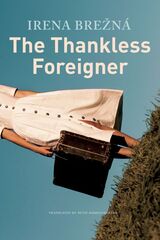 The Thankless Foreigner
Irena Brežná
Seagull Books, 2022 A novel that offers a timely and important viewpoint on the immigration experience about the need for resistance to blind assimilation in a host country.
In 1968, in search of a better world, a young person flees her country and ends up in Switzerland, the land of hard cheese. There she’s told not to talk nonsense, or not to “talk cheese,” as they say in the local dialect. Home is where you can grumble, but here you have to be grateful. Her new environs seem unwieldy, aloof, and she rebels against this host country that insists on her following its rules, that won’t let her be herself. But as an interpreter, she meets many others who have ended up here—petty criminals, depressives, hustlers, refugees, victims of exploitation, and others who have gone out of their way to assimilate, people who share a hope that they can make something new of their lives. Gradually she learns to experience the richness of exile and foreignness, to build bridges between cultures. A brilliantly written novel about the search for identity between assimilation and resistance, Irena Brežná’s The Thankless Foreigner is a significant addition to the important literature of immigrant experience.
Thanks for Letting Us Know You Are Alive: Poems
Jennifer Tseng
University of Massachusetts Press, 2024 Crafted with lines from her late father’s letters, Jennifer Tseng’s Thanks for Letting Us Know You Are Alive is a portrait of an immigrant, a rootless person whose unspoken loss—that of his native geography, family, traditions, language—underlies every word. Though her father’s first language was Mandarin, for more than twenty years he wrote these letters in English, so that she could understand them. Some are riddled with errors, some nearly unintelligible. Lines from his letters appear as titles and are scattered throughout the poems, blending voices of father and daughter. This collection enacts what it means to lose someone and commune with them simultaneously—the paradox of grief and all it gives us.
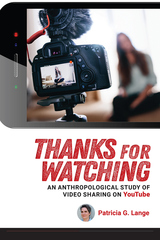 Thanks for Watching: An Anthropological Study of Video Sharing on YouTube
Patricia G. Lange
University Press of Colorado, 2019 YouTube hosts one billion visitors monthly and sees more than 400 hours of video uploaded every minute. In her award winning book, Thanks for Watching, Patricia G. Lange offers an anthropological perspective on this heavily mediated social environment by analyzing videos and the emotions that motivate sharing them. She demonstrates how core concepts from anthropology—participant-observation, reciprocity, and community—apply to sociality on YouTube. Lange's book reconceptualizes and updates these concepts for video-sharing cultures. Lange draws on 152 interviews with YouTube participants at gatherings throughout the United States, content analyses of more than 300 videos, observations of interactions on and off the site, and participant-observation. She documents how the introduction of monetization options impacted perceived opportunities for open sharing and creative exploration of personal and social messages. Lange’s book provides new insight into patterns of digital migration, YouTube’s influence on off-site interactions, and the emotional impact of losing control over images. The book also debunks traditional myths about online interaction, such as the supposed online/offline binary, the notion that anonymity always degrades public discourse, and the popular characterization of online participants as over-sharing narcissists. YouTubers' experiences illustrate fascinating hybrid forms of contemporary sociality that are neither purely mediated nor sufficient when conducted only in person. Combining intensive ethnography, analysis of video artifacts, and Lange’s personal vlogging experiences, the book explores how YouTubers are creating a posthuman collective characterized by interaction, support, and controversy. In analyzing the tensions between YouTubers' idealistic goals of sociality and the site's need for monetization, Thanks for Watching makes crucial contributions to cultural anthropology, digital ethnography, science and technology studies, new media studies, communication, interaction design, and posthumanism. For its perceptive analysis of video blogging for self-expression and sociality, Thanks for Watching received the Franklyn S. Haiman Award for Distinguished Scholarship in Freedom of Expression (2020), from the National Communication Association.
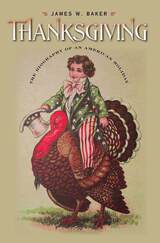 Thanksgiving: The Biography of an American Holiday
James W. Baker
University of New Hampshire Press, 2009 In this, the first in-depth study of the most American of holidays, James Baker sweeps away lingering myths and misconceptions to show how this celebration day was born and grew to be an essential part of our national spirit. Thanksgiving: The Biography of an American Holiday opens with an overview of the popular mythos of the holiday before discussing its possible religious and cultural precedents. This classic Yankee holiday is examined in historical and contemporary detail that embraces everything from proclamations, sermons, and local and regional traditions to family reunions, turkey dinners, and recipes. Thanksgiving’s evolving face is illustrated with charming and often revealing period prints that chart our changing attitudes: the influence of Victorian sentiment in Thanksgiving’s development, Progressive utilitarianism, intellectual “debunking,” patriotic wartime reclamation, and 1960s-era protest. Thanksgiving remains controversial up to the present day, as Mayflower descendants, Native Americans, and commercial exploiters compete for the American public’s opinion of the holiday’s contemporary significance and its future status. This is an intelligent and illuminating introduction to a beloved holiday and a fascinating cultural history of America and Americana.
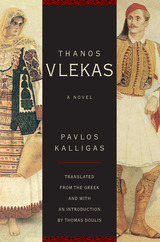 Thanos Vlekas: A Novel
Pavlos Kalligas, Translated from the Greek by Thomas Doulis
Northwestern University Press, 2001 Published in 1855 and considered Greece's first realistic social novel, Thanos Vlekas is a witty and ambitious portrayal of the problems facing the newly established Greek state after its War of Independence. The story of two opposing brothers, it addresses the brigandage, corruption, and bureaucratic bumbling that plagued the newly established Greek state.
Thanos is a young farmer struggling to improve himself despite the derision of his mother, who considers him incapable of bearing arms for his country. She prefers instead her more "heroic" son, the brave and ambitious brigand Tassos, whose courage and resistance to authority embodying the virtues that helped Greece drive out the Turks. While Thanos works his land, his ruthless brother uses the political machinery and wealth gained from robbery and murder to replace the old Ottoman landowners and subjugate the villagers.
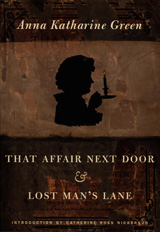 That Affair Next Door and Lost Man's Lane
Anna Katharine Green
Duke University Press, 2003 Anna Katharine Green was the most famous and prolific writer of detective fiction in the United States prior to Dashiell Hammett. Her first novel, The Leavenworth Case, was the bestseller of 1878. Green is credited with a number of “firsts” within the mystery genre, including the gentleman murdered as he makes out his will and the icicle as murder weapon. She created the first female detectives in American fiction. Her amateur spinster sleuth, Amelia Butterworth, became the prototype for numerous women detectives to follow, including Agatha Christie’s Miss Marple. Nosy, opinionated, and tenacious, Amelia Butterworth engages in a sustained rivalry with Ebenezer Gryce, a police detective. In the interaction between these characters, Green developed two more conventions adopted by future generations of mystery writers: the investigation as battle between the sexes and between the professional and the unexpectedly sharp, observant amateur. This volume presents two of Green’s Amelia Butterworth tales: That Affair Next Door (1897) and Lost Man’s Lane (1898).
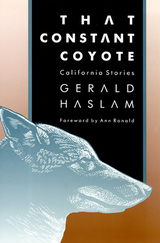 That Constant Coyote: California Stories
Gerald W. Haslam
University of Nevada Press, 1990 Haslam’s stories are of the quintessential California of working people who struggle to make a living. He is their spokesperson—no matter what their color or language—because he, too, has chopped cotton under the searing sun, has toiled on drilling rigs in fog thick as oatmeal, has lived in a house where Spanish and English mingled. His writing marks a boundary between the Golden State's stereotypes and the real people who persevere in seeking the California dream. That Constant Coyote contains twenty-five stories in all, nineteen selections previously published and six new pieces. The stories included in this anthology tell us what life is like in the regions of California and the West where drudgery characterizes each day, where menudo para desayuno or biscuits and gravy replace champagne brunch. Delve into these pages and you will quickly find a set of fascinating characters who inhabit "the other California"—a place Haslam knows well and so deftly describes. Foreword by Ann Ronald. Western Literature Series.
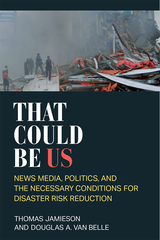 That Could Be Us: News Media, Politics, and the Necessary Conditions for Disaster Risk Reduction
Thomas Jamieson and Douglas A. Van Belle
University of Michigan Press, 2022 The evidence presented in this book suggests that when the necessary conditions for disaster risk reduction (DRR) are in place, it is possible for elected officials to pursue DRR policies in their rational self-interest. As such, when the media makes it possible through lesson-drawing coverage of distant disasters, DRR policies become much more likely in observing communities because elected officials can seize the opportunity to both make political gains and protect their constituents. Authors Thomas Jamieson and Douglas A. Van Belle provide reasons for optimism about the prospect of DRR in at-risk communities around the world— observing communities are able to learn from the experiences of stricken areas and pursue policies that ultimately save lives and reduce economic damage from disasters. In That Could Be Us, Jamieson and Van Belle find that the news media delivers information to observing communities in a form that enables learning from other disasters. Experimental evidence shows that people react to this information in a way that would punish leaders who do not back DRR efforts. Case studies, interviews, experiments, and illustrative examples suggest that leaders and political entrepreneurs heed this public demand, react to news media coverage, and act accordingly. Taken as a whole, this suggests that the policy and research implications derived from this book’s theoretical model are worthy of further exploration, particularly in terms of how they might resolve the puzzle presented by the variations in DRR policy uptake around the world that do not seem to be driven by developmental differences across communities.
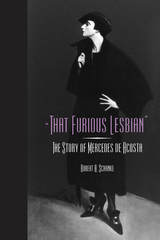 That Furious Lesbian: The Story of Mercedes de Acosta
Robert A. Schanke
Southern Illinois University Press, 2004 In this first book-length biography of Mercedes de Acosta, theatre historian Robert A. Schanke adroitly mines lost archival materials and mixes in his own interviews with de Acosta’s intimates to correct established myths and at last construct an accurate, detailed, and vibrant portrait of the flamboyantly uninhibited early-twentieth-century author, poet, and playwright. Born to wealthy Spanish immigrants, Mercedes de Acosta (1893–1968) lived in opulence and traveled in the same social circles as the Astors and Vanderbilts. Introduced to the New York theater scene at an early age, her dual loves of performance and of women informed every aspect of her life thereafter. Alice B. Toklas’s observation, “Say what you will about Mercedes, she’s had the most important women in the twentieth century,” was well justified, as her romantic conquests included such internationally renowned beauties as Greta Garbo, Marlene Dietrich, Isadora Duncan, and Eva Le Gallienne as well as Alla Nazimova, Tamara Karsavina, Pola Negri, and Ona Munson. More than a record of her personal life and infamous romances, this account offers the first analysis of the complete oeuvre of de Acosta’s literary works, including three volumes of poetry, two novels, two film scripts, and a dozen plays. Although only two of her plays were ever published during her lifetime, four of them were produced, featuring such stage luminaries as John Gielgud, Ralph Richardson, and Eva Le Gallienne. Critics praised her first volume of poetry, Moods, in 1919 and predicted her rise to literary fame, but the love of other women that fueled her writing also limited her opportunities to fulfill this destiny. Failing to achieve any lasting fame, she died in relative poverty at the age of seventy-five. De Acosta lived her desires publicly with verve and vigor at a time when few others would dare, and for that, she paid the price of marginalized obscurity. Until now. With “That Furious Lesbian” Schanke at last establishes Mercedes de Acosta’s rightful place as a pioneer—and indeed a champion—in the early struggle for lesbian rights in this country. Robert A. Schanke has edited a companion to this biography, Women in Turmoil: Six Plays by Mercedes de Acosta,also available from Southern Illinois University Press.
 That Futebol Feeling: Sport and Play in Brazil's Heartland
David Faflik
Temple University Press, 2025 Futebol, or soccer for Americans, is the planet’s spectator sport of choice. In the Brazilian state of Minas Gerais, nestled in the country’s southeastern heartland, futebol generates powerful, lifelong emotions.
That Futebol Feeling captures the region’s enthrallment with “the beautiful game,” and shows us how and why play is central to the human condition. David Faflik profiles members of the most celebrated local team, Clube Atlético Mineiro (CAM), as well as its passionate, never-say-die fans, to show how futebol and fandom shape their everyday lives and perspectives. He discovers bonds of work and play, as well as pride, identity, and community. Additionally, Faflik’s analysis of Brazil’s futebol culture reflects sports fandom worldwide.
CAM stands as a symbol for a way of life in Minas Gerais, the birthplace of Pelé. Faflik interrogates what playing the game means to those who dedicate their lives to the sport. He writes, “The feelings that football inspires are the best of me.” That Futebol Feeling shares that special feeling with the rest of us.
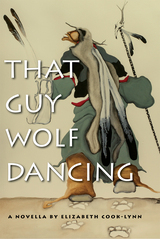 That Guy Wolf Dancing
Elizabeth Cook-Lynn
Michigan State University Press, 2014 From one of the writers of the twentieth-century Native American Literary Renaissance comes a remarkable tale about how to acknowledge the past and take a chance on the future. Rooted in tribal-world consciousness, That Guy Wolf Dancing is the story of a young tribal wolf-man becoming a part of his not-sonatural world of non-tribal people. Twenty-something Philip Big Pipe disappears from an unsettled life he can hardly tolerate and ends up in an off-reservation town. When he leaves, he doesn’t tell anyone where he is going or what his plans, if he has any, might be. Having never taken himself too seriously, he now faces a world that feels very foreign to him. As he struggles to adapt to the modern universe, Philip, ever a “wolf dancer,” must improvise, this time to a sound others provide for him. Like the wolf, Philip sometimes feels hunted, outrun, verging on extinction. Only by moving rhythmically in a dissident, dangerous, and iconic world can Philip Big Pipe let go of the past and craft a new future.
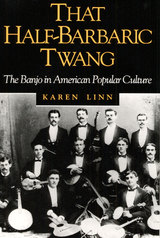 That Half-Barbaric Twang: The Banjo in American Popular Culture
Karen Linn
University of Illinois Press, 1991 Long a symbol of American culture, the banjo actually originated in Africa before European-Americans adopted it. Karen Linn shows how the banjo--despite design innovations and several modernizing agendas--has failed to escape its image as a "half-barbaric" instrument symbolic of antimodernism and sentimentalism. Caught in the morass of American racial attitudes and often used to express ambivalence toward modern industrial society, the banjo stood in opposition to the "official" values of rationalism, modernism, and belief in the beneficence of material progress. Linn uses popular literature, visual arts, advertisements, film, performance practices, instrument construction and decoration, and song lyrics to illustrate how notions about the banjo have changed. Linn also traces the instrument from its African origins through the 1980s, alternating between themes of urban modernization and rural nostalgia. She examines the banjo fad of bourgeois Northerners during the late nineteenth century; the African-American banjo tradition and the commercially popular cultural image of the southern black banjo player; the banjo's use in ragtime and early jazz; and the image of the white Southerner and mountaineer as banjo player.
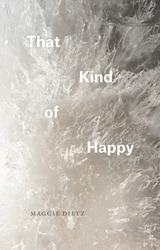 That Kind of Happy
Maggie Dietz
University of Chicago Press, 2016 October Aubade
If I slept too long, forgive me.
A north wind quickened the window frames
so the room pitched like a moving train
and the pillow’s whiff of hickory
and shaving soap conjured your body
beside me. So I slept in the berth
as the train chuffed on, unburdened
by waking’s cold water, ignorant
of pain, estrangement, hunger and
the crucial fuel the boiler burned
to keep the minutes’ pistons churning
while I slept. Forgive me.
That Kind of Happy, the long-awaited second collection by award-winning poet Maggie Dietz, explores the sharp, profound tension between a disquieted inner life and quotidian experience. Central to the book are poems that take up two major life events: becoming a mother and losing a father within a short stretch of time. Here, at the intersection of joy and grief, of persistence and attrition, Dietz wrestles with the questions posed by such conflicting experiences, revealing a mind suspicious of quick fixes and dissatisfied with easy answers. The result is a book as anguished as it is distinguished.
 That Neutral Island: A Cultural History of Ireland During the Second World War
Clair Wills
Harvard University Press, 2007 When the world descended into war in 1939, few European countries remained neutral; but of those that did, none provoked more controversy than Ireland.
Despite Winston Churchill's best efforts to the contrary, the Irish premier Eamon de Valera stuck determinedly to Ireland's right to remain outside a conflict in which it had no enemies. Accusations of betrayal and hypocrisy poisoned the media; legends of Nazi spies roaming the country depicted Ireland as a haven for Hitler's friends. Where previous histories of Ireland in the war years have focused on high politics, That Neutral Island mines deeper layers of experience. Sean O'Faolain, Kate O'Brien, Elizabeth Bowen, Flann O'Brien and Louis MacNeice are a handful of writers whose stories, letters, and diaries illuminate this small country as it suffered rationing, censorship, the threat of invasion, and a strange detachment from the war.
Clair Wills brings to life the atmosphere of a country forced largely to do without modern technology. She describes the work of those who recovered the bodies of British sailors and airmen from the sea. She unearths the motivations of thousands who left to join the British forces. And she shows how ordinary people struggled to make sense of the Nazi threat through the lens of antagonism to Britain, the former colonial power. She acutely targets the sleight-of-hand that hovers around the Irish definition of "neutrality."
That Old-Time Rock & Roll: A Chronicle of an Era, 1954-63
Richard Aquila
University of Illinois Press, 1989 Elvis Presley and Bill Haley. Sam Cooke and the Shirelles. The Crows and the Chords. American Bandstand and Motown. From its first rumblings in the outland alphabet soup of R&B and C&W, rock & roll music promised to change the world--and did it. Combining social history with a treasure trove of trivia, Richard Aquila unleashes the excitement of rock's first decade and shows how the music reflected American life from the mid-1950s through the dawn of Beatlemania. His year-by-year timelines and a photo essay place the music in historical perspective by linking artists and their hits to the news stories, movies, TV shows, fads, and lifestyles. In addition, he provides a concise biographical dictionary of the performers who made the charts between 1954 and 1963, along with the label and chart position of each of their hit songs.
That Place Where You Opened Your Hands
Susan Leslie Moore
University of Massachusetts Press, 2020 Celebrating the tension between what we imagine and what we know the world to be, Susan Leslie Moore's debut collection moves between certainty and doubt, dead seriousness and determined playfulness. Exploring identity and the exterior and interior selves we create through the natural world, language, and relationships, the poems of That Place Where You Opened Your Hands bring the ordinary rhythms of life and motherhood into coexistence with wilder truths. As Moore writes, "If I can't be singular / in purpose, let me be quietly adrift," but these are not quiet poems.
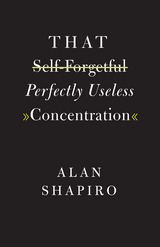 That Self-Forgetful Perfectly Useless Concentration
Alan Shapiro
University of Chicago Press, 2016 More than a gathering of essays, That Self-Forgetful Perfectly Useless Concentration is part memoir, part literary criticism, and an artful fusion of the two. It is an intimate portrait of a life in poetry that only Alan Shapiro could have written.
In this book, Shapiro brings his characteristic warmth, humor, and many years as both poet and teacher to bear on questions surrounding two preoccupations: the role of conventions—of literary and social norms—in how we fashion our identities on and off the page, and how suffering both requires and resists self-expression. He sketches affectionate portraits of his early teachers, revisits the deaths of his brother and sister, and examines poems that have helped him navigate troubled times. Integrating storytelling and literary analysis so seamlessly that art and life become extensions of each other, Shapiro embodies in his lively prose the very qualities he celebrates in the poems he loves.
Brimming with wit and insight, this is a book for poets, students and scholars of poetry, teachers of literature, and everyone who cares about the literary arts and how they illuminate our personal and public lives.
That Ship Has Sailed: Poems
Terence Winch
University of Pittsburgh Press, 2023 That Ship Has Sailed synthesizes the serious and comic to address sex, love, loss, death, belief, the afterlife, and the past. The poems are honest and direct without sacrificing “the uncertainties, mysteries, and doubts” that Keats singles out in his notion of “negative capability,” alluded to in the title poem. Amplified by the poet’s work as a traditional Irish musician and composer, language is the adhesive that brings the work together across the avant-garde to traditional forms and meters.
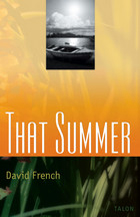 That Summer
David French
Talon Books, 2000 It’s Memorial Day, 1990, and Margaret Ryan has returned from Vermont to the Ontario cottage country where, thirty-two years before, she had vacationed with her disintegrating family at a lakeside resort. For herself and her sister Daisy, it was a time of awakening, a time of discovery.
Both of the girls fall in love with two of the local boys. Daisy, on the lookout for action, cruising the dances at the resort, can’t deal with what she initiates, and falls victim to her own confusion and naivete;. Not even the neighbour, the eccentric, bourbon-drinking, cigar-smoking Mrs. Crump, who knows all the fairy-tale spells to capture the heart of a lover, can save Daisy from drowning in her own misadventure.
At the same time, Margaret, bookish and withdrawn, inhabiting a universe defined by poets and novelists, is seduced in spite of herself.
As Margaret, the narrator, watches Maggie, her younger self, relive the innocence and beauty of that summer, the play moves inexorably back to the heartbreak of a headlong surrender to experience, both won and lost in a single day.
Cinematic in its feel and pacing, recalling the 1950s genre of Dirty Dancing and My American Cousin, That Summer is a meditation on what endures of fleeting moments over time.
Cast of 5 women and 2 men.
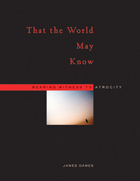 That the World May Know: Bearing Witness to Atrocity
James Dawes
Harvard University Press, 2007 Listen to a short interview with James DawesHost: Chris Gondek | Producer: Heron & Crane
After the worst thing in the world happens, then what? What is left to the survivors, the witnesses, those who tried to help? What can we do to prevent more atrocities from happening in the future, and to stop the ones that are happening right now? That the World May Know tells the powerful and moving story of the successes and failures of the modern human rights movement. Drawing on firsthand accounts from fieldworkers around the world, the book gives a painfully clear picture of the human cost of confronting inhumanity in our day.
There is no dearth of such stories to tell, and James Dawes begins with those that emerged from the Rwandan genocide. Who, he asks, has the right to speak for the survivors and the dead, and how far does that right go? How are these stories used, and what does this tell us about our collective moral future? His inquiry takes us to a range of crises met by a broad array of human rights and humanitarian organizations. Here we see from inside the terrible stresses of human rights work, along with its curious seductions, and the myriad paradoxes and quandaries it presents.
With pathos, compassion, and a rare literary grace, this book interweaves personal stories, intellectual and political questions, art and aesthetics, and actual "news" to give us a compelling picture of humanity at its conflicted best, face-to-face with humanity at its worst.
That They Be One: The Social Teaching of the Papal Encyclicals 1740-1989
Michael J. Schuck
Georgetown University Press, 1991 A comprehensive historical study of the complete content and overall coherence of two and a half centuries of papal instructions that have variously aroused worldwide interest, scorn, fury, reaction, and consent. It provides the kind of analysis that concerned Roman Catholics, public officials, social ethicists, theologians, and students need. It is a textually inclusive and topically broad-gauged review of Catholic social teaching in its historical development, with a forthright assessment of its regrettable contradictions as well as of its valuable consistencies.
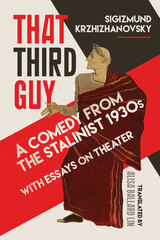 That Third Guy: A Comedy from the Stalinist 1930s with Essays on Theater
Sigizmund Krzhizhanovsky, Translated and edited by Alisa Ballard Lin, Foreword by Caryl Emerson
University of Wisconsin Press, 2018 This collection of theater writings by the Russian modernist Sigizmund Krzhizhanovsky brings his powerful, wildly imaginative vision of theater to an English-language audience for the first time. The centerpiece is his play That Third Guy (1937), a farce written at the onset of the Stalinist Terror and never performed. Its plot builds on Alexander Pushkin's poem "Cleopatra," while parodying the themes of Eros and empire in the Cleopatra tales of two writers Krzhizhanovsky adored: Shakespeare and George Bernard Shaw. In a chilling echo of the Soviet 1930s, Rome here is a police state, and the Third Guy (a very bad poet) finds himself in its dragnet. As he scrambles to escape his fate, the end of the Roman Republic thunders on offstage.
The volume also features selections from Krzhizhanovsky's compelling and idiosyncratic essays on Shakespeare, Pushkin, Shaw, and the philosophy of theater. Professionally, he worked with director Alexander Tairov at the Moscow Kamerny Theater, and his original philosophy of the stage bears comparison with the great theater theorists of the twentieth century. In these writings, he reflects on the space and time of the theater, the resonance of language onstage, the experience of the actor, and the relationship between the theater and the everyday. Commentary by Alisa Ballard Lin and Caryl Emerson contextualizes Krzhizhanovsky's writings.
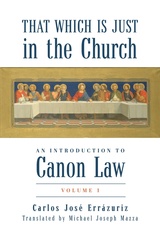 That Which Is Just in the Church: An Introduction to Canon Law: Volume 1
Carlos José Errázuriz
St. Augustine's Press, 2021 Consonant with its commitment to publish seminal works in the field of canon law, St. Augustine's Press is pleased to make available the first volume in a series that will undoubtedly endure as a masterpiece of scholarship. Carlos José Errázuriz, Professor of Canon Law at the Pontifical University of the Holy Cross (Rome) has provided a comprehensive and insightful treatment of rights, justice, and law in the Catholic Church, beginning with the most basic questions regarding the essence of these realities. His responses exhibit the perspective of that which is just in the Church, which consists of ecclesial juridical goods: the Word of God, the sacraments, the freedom of the children of God, and sacred potestas. This work vindicates the institution of law, but also addresses the "spontaneity" of just freedom proper to what has been instituted by Christ.
Errázuriz presents more than the current Code of Canon Law. He instills a realistic perspective of right and law in the Church, and in so doing fills a massive gap in English scholarship. No introduction to canon law available in English rivals Errázuriz's description of justice in the Church and its relationship with communion and sacramentality.
Volume I is comprised of the first three chapters of the original, Corso fondamentale sul diritto nella Chiesa (in two volumes, Giuffrè: Milan, 2009 and 2017): "Rights, Justice and Law in the Church," "Canon Law in History," and "The Configuration of Rights and Law in the Church."
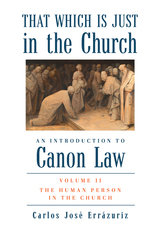 That Which Is Just in the Church: Volume 2: The Human Person in the Church
Carlos José Errázuriz
St. Augustine's Press, 2023 Volume one of Prof. Carlos J. Errázuriz's monumental treatment of canon law establishes that law in the Catholic Church is properly understood as that which is just. In the second volume, he moves to the foremost protagonist in this arena––namely, the human person. The human person is the primary holder of rights and obligations in the Church, destined for the salvation merited by Christ. The salvific goods constituted by the Word of God and the sacraments are fundamental aspects of juridical relationships and life in the Church.
Being subject to law, Errázuriz observes, does not undermine the freedom and dignity of the person. Rather, ecclesial law intends to confront the human person with his true supernatural inheritance, while preserving him in the mystery of communion within which the Church herself exists. Indeed, the human person has both natural and supernatural dignity, and likewise responsibilities that bear upon the seen and unseen realms of communion.
Prof. Errázuriz examines the practical applications of personhood and law, as well as the perspectives of the human subject that derive from his ontological status. This is further drawn across various states of life that occur within the Church and the differing juridical relations encountered. Also considered is the nature of association in the Church, and Errázuriz breaks down the concepts and particular realities pertaining to this natural tendency and the legal discipline.
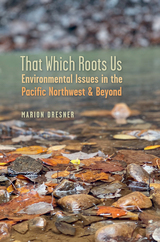 That Which Roots Us: Environmental Issues in the Pacific Northwest & Beyond
Marion Dresner
University of Nevada Press, 2023 A work of natural and environmental history.
That Which Roots Us is a work of natural and environmental history that explores the origins of and resolutions to some of the United States’ environmental problems. Marion Dresner discusses the roots of Euro-American environmental exploitative action, starting with the environmental consequences of having treated Pacific Northwest forests as commodities. She shares her experiences visiting sites where animal-centered ice age culture changed to human-centered culture thousands of years ago with the advent of farming. The book explores the origins of the romantic philosophical movement, which arose out of the debilitating conditions of the industrial era. Those romantic attitudes toward nature inspired the twentieth-century preservation movement and America’s progressively modern conservation attitudes. The book is centered around environmental issues in the Pacific Northwest, contrasting utilitarian views of nature with Native American practices of respect and reciprocity. The elements that make That Which Roots Us a truly unique and important contribution to environmental literature are the author’s personal recollections and interactions with the landscape. Ultimately, Dresner offers hope for a new stewardship of the land and a focus on science literacy and direct experience in the natural world as the most grounded way of knowing the planet.
Thatcher
Clare Beckett
Haus Publishing, 2006 Britain's first woman prime minister, friend of Ronald Reagan and the longest serving head of government in the 20th century (1979-90), but also the only one to be removed from office in peacetime by pressure from within her own party
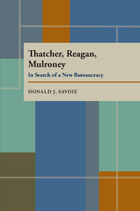 Thatcher, Reagan, and Mulroney: In Search of a New Bureaucracy
Donald J. Savoie
University of Pittsburgh Press, 1994
Savoie considers the war of reform waged by the leaders of these major industrial countries. Reagan declared that he had come to Washington to “drain the swamp” of bureaucracy, and set up the Grace Commission to investigate the operation of the U.S. government. Thatcher and Mulroney were equally committed to reform and initiated wide-ranging changes. By the end of the 1990s, the changes were dramatic. Many governments operations had been privatized in all three countries, and new management techniques had been introduced. In Great Britain, one observer judged that the changes were historically as important as the collapse of Keynesian economics.
Is government now better in these countries, and was political leadership right in focusing on management of the bureaucracy as the villain? Savoie suggests that the reforms overlooked problems now urgently requiring attention and, at the same time, attempted to address non-existent problems. He combines theory and research based on sixty-two interviews, nearly all with members of the executive branch of the governments of Britain, Canada and the United States.
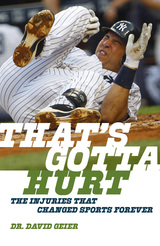 That’s Gotta Hurt: The Injuries That Changed Sports Forever
Dr. David Geier
University Press of New England, 2017 In That’s Gotta Hurt, the orthopaedist David Geier shows how sports medicine has had a greater impact on the sports we watch and play than any technique or concept in coaching or training. Injuries among professional and college athletes have forced orthopaedic surgeons and other healthcare providers to develop new surgeries, treatments, rehabilitation techniques, and prevention strategies. In response to these injuries, sports themselves have radically changed their rules, mandated new equipment, and adopted new procedures to protect their players. Parents now openly question the safety of these sports for their children and look for ways to prevent the injuries they see among the pros. The influence that sports medicine has had in effecting those changes and improving both the performance and the health of the athletes has been remarkable. Through the stories of a dozen athletes whose injuries and recovery advanced the field (including Joan Benoit, Michael Jordan, Brandi Chastain, and Tommy John), Dr. Geier explains how sports medicine makes sports safer for the pros, amateurs, student-athletes, and weekend warriors alike. That’s Gotta Hurt is a fascinating and important book for all athletes, coaches, and sports fans.
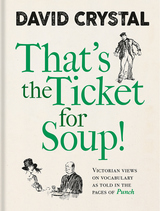 That’s the Ticket for Soup!: Victorian Views on Vocabulary as Told in the Pages of Punch
David Crystal
Bodleian Library Publishing, 2020 The vocabulary of the past is always intriguing, especially when it is no longer used in modern English. Many of the words and phrases that were popular in Victorian England may sound foreign today, but looking to original sources and texts can yield fascinating insight, especially when we see how vocabulary was pilloried by the satirists of the day.
In That’s the Ticket for Soup!, the renowned language expert David Crystal returns to the pages of Punch magazine, England’s widely read satirical publication. Crystal has pored through the pages of Punch between its first issue in 1841 and the death of Queen Victoria in 1901 and extracted the articles and cartoons that poked fun at the jargon of the day. Here we have Victorian high and low society, with its fashionable and unfashionable slang, its class awareness on display in the vocabulary of steam engines, motor cars, and other products of the Industrial Revolution. Then, as now, people had strong feelings about the flood of new words entering English. Swearing, new street names, and the many borrowings from French provoked continual irritation and mockery, as did the Americanisms increasingly encountered in the British press. In addition to these entertaining examples, Crystal includes commentary on the context of the times and informative glossaries. This original and amusing collection reveals how many present-day feelings about words can be traced to the satire of a century ago.
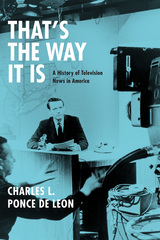 That's the Way It Is: A History of Television News in America
Charles L. Ponce de Leon
University of Chicago Press, 2015 When critics decry the current state of our public discourse, one reliably easy target is television news. It’s too dumbed-down, they say; it’s no longer news but entertainment, celebrity-obsessed and vapid.
The critics may be right. But, as Charles L. Ponce de Leon explains in That’s the Way It Is, TV news has always walked a fine line between hard news and fluff. The familiar story of decline fails to acknowledge real changes in the media and Americans’ news-consuming habits, while also harking back to a golden age that, on closer examination, is revealed to be not so golden after all. Ponce de Leon traces the entire history of televised news, from the household names of the late 1940s and early ’50s, like Eric Sevareid, Edward R. Murrow, and Walter Cronkite, through the rise of cable, the political power of Fox News, and the satirical punch of Colbert and Stewart. He shows us an industry forever in transition, where newsmagazines and celebrity profiles vie with political news and serious investigations. The need for ratings success—and the lighter, human interest stories that can help bring it—Ponce de Leon makes clear, has always sat uneasily alongside a real desire to report hard news.
Highlighting the contradictions and paradoxes at the heart of TV news, and telling a story rich in familiar figures and fascinating anecdotes, That’s the Way It Is will be the definitive account of how television has showed us our history as it happens.
The Thaw Generation: Coming of Age in the Post-Stalin Era
Ludmilla Alexeyeva
University of Pittsburgh Press, 1993 The Thaw Generation offers an insider's look at the Soviet dissident movement--the intellectuals who, during the Khrushchev and Brezhnev eras, dared to challenge an oppressive system and demand the rights guaranteed by the Soviet constitution. Fired from their jobs, hunted by the KGB, “tried,” and imprisoned, Alexeyeva and other activists including Andrei Sakharov, Yuri Orlov, Yuli Daniel, and Andrei Sinyavsky, through their dedication and their personal and professional sacrifices, focused international attention on the issue of human rights in the USSR.
The The Complete Works of Robert Browning, Volume IV
Browning, Robert
Ohio University Press, 1973 In seventeen volumes, copublished with Baylor University, this acclaimed series features annotated texts of all of Robert Browning’s known writing. The series encompasses autobiography as well as influences bearing on Browning’s life and career and aspects of Victorian thought and culture.
The The Long White
Sharon Dilworth
University of Iowa Press, 1988 In the sparsely settled hills of Michigan's Upper Peninsula, winter's toughness is matched only by the animosity and affection of its inhabitants for each other and for the land that unnerves them. In The Long White, Sharon Dilworth evokes a place dominated by two great lakes whose power and ferocity influence the lives of every inhabitant. The particularities of place and character come together with the clarity and exactitude of a fresh snowfall that both veils and illuminates a landscape.
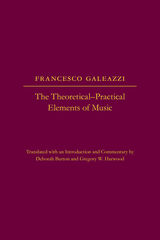 The The Theoretical-Practical Elements of Music, Parts III and IV
Francesco Galeazzi Translated with an Introductin and Commentary by Deborah Burton and Gregory W. Harwood
University of Illinois Press, 2012 A virtuoso violinist, conductor, composer, and a professor of mathematics and botany, Francesco Galeazzi (1758–1819) firmly believed that musical education should be clear, demonstrable, and practical. In 1791 and 1796, he published the two volumes of his Elementi teorico-practici di musica, a treatise that demonstrated both his thorough grounding in the work of earlier theorists and his own approach to musical study. The first volume gave precise instructions on the violin and how to play it; the second demonstrated his command of other instruments and genres and provided comprehensive introductions to music theory, music history, and music aesthetics. The treatise also addresses the nature of compositional process and eighteenth-century concerns about natural and acquired talent and creativity.
This volume offers an unprecedented English translation of the second volume of Elementi teorico-practici di musica, with annotations and commentary. The translation is introduced with a study of Galeazzi's life and milieu, the genesis and sources for the Elementi, and its reception through the present day.
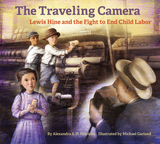 The The Traveling Camera: Lewis Hine and the Fight to End Child Labor
Alexandra S. D. Hinrichs
J. Paul Getty Trust, The, 2021 This poetic and beautiful picture book chronicles the travels of Lewis Hine, who used his camera to document child labor in the early twentieth century.
Stunning visuals and poetic text combine to tell the inspiring story of Lewis Hine (1874–1940), a teacher and photographer who employed his art as a tool for social reform. Working for the National Child Labor Committee, Hine traveled the United States, taking pictures of children as young as five toiling under dangerous conditions in cotton mills, seafood canneries, farms, and coal mines. He often wore disguises to sneak into factories, impersonating a machinery inspector or traveling salesman. He said, “If I could tell this story in words, I wouldn’t need to lug a camera.” His poignant pictures attracted national attention and were instrumental in the passage of child labor laws. The Traveling Camera contains extensive back matter, including a time line, original photos, and a bibliography.
Ages six to nine.
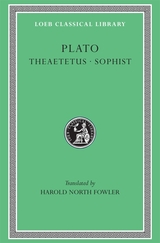 Theaetetus. Sophist
Plato
Harvard University Press An epistemological diptych.
Plato, the great philosopher of Athens, was born in 427 BC. In early manhood an admirer of Socrates, he later founded the famous school of philosophy in the grove Academus. Much else recorded of his life is uncertain; that he left Athens for a time after Socrates’ execution is probable; that later he went to Cyrene, Egypt, and Sicily is possible; that he was wealthy is likely; that he was critical of “advanced” democracy is obvious. He lived to be 80 years old. Linguistic tests including those of computer science still try to establish the order of his extant philosophical dialogues, written in splendid prose and revealing Socrates’ mind fused with Plato’s thought.
In Laches, Charmides, and Lysis, Socrates and others discuss separate ethical conceptions. Protagoras, Ion, and Meno discuss whether righteousness can be taught. In Gorgias, Socrates is estranged from his city’s thought, and his fate is impending. The Apology (not a dialogue), Crito, Euthyphro, and the unforgettable Phaedo relate the trial and death of Socrates and propound the immortality of the soul. In the famous Symposium and Phaedrus, written when Socrates was still alive, we find the origin and meaning of love. Cratylus discusses the nature of language. The great masterpiece in ten books, the Republic, concerns righteousness (and involves education, equality of the sexes, the structure of society, and abolition of slavery). Of the six so-called dialectical dialogues Euthydemus deals with philosophy; metaphysical Parmenides is about general concepts and absolute being; Theaetetus reasons about the theory of knowledge. Of its sequels, Sophist deals with not-being; Politicus with good and bad statesmanship and governments; Philebus with what is good. The Timaeus seeks the origin of the visible universe out of abstract geometrical elements. The unfinished Critias treats of lost Atlantis. Unfinished also is Plato’s last work, Laws, a critical discussion of principles of law which Plato thought the Greeks might accept.
The Loeb Classical Library edition of Plato is in twelve volumes.
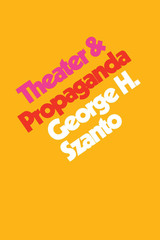 Theater & Propaganda
By George H. Szanto
University of Texas Press, 1978 This original and insightful study explores the points at which theater and propaganda meet. Defining propaganda as a form of "activated ideology," George H. Szanto discusses the distortion of information that occurs in dramatic literature in its stage, film, and television forms. Szanto analyzes the nature of "integration propaganda," which is designed to render the audience passive and to encourage the acceptance of the status quo, as opposed to "agitation propaganda," which aims to inspire the audience to action. In Szanto's view, most popular western theater is saturated, though usually not intentionally, with integration propaganda. The overall purpose of Theater and Propaganda is twofold: to analyze the nature of integration propaganda so that it becomes visible to western readers as a tool of the dominant class in society, and to examine the manner by which unself-conscious propagandistic methods have saturated dramatic presentation. In discussing the importance of propaganda within and between technological states, the author examines the seminal work of Jacques Ellul. In this chapter he analyzes the function of integration propaganda in a relatively stable society. The following chapter defines and analyzes three theaters (in the sense of performance) of propaganda: the theater of agitation propaganda, of integration propaganda, and of dialectical propaganda. In this section he uses examples from a variety of plays, movies, and television commercials. In succeeding chapters Szanto discusses the role of integration propaganda in the medieval Wakefield mystery plays and the plays of Samuel Beckett. The appendix, "Contradiction and Demystification," provides a general model that suggests ways of breaking down and overcoming the propagandistic intentions of an artwork and discusses theater's possible role in this breakdown.
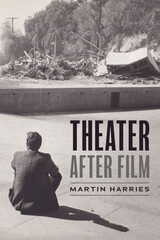 Theater after Film
Martin Harries
University of Chicago Press, 2025 A study of the impact of film and mass culture on drama after World War II.
In Theater after Film, Martin Harries argues that after 1945, as cinema became omnipresent in popular culture, theater had to respond to cinema’s hegemony. Theater couldn’t break that hegemony, but it could provide a zone of contestation. Theater made film’s domination of the cultural field visible through hyperbole, refusal, and other strategies, thereby unsettling its power. Postwar theatrical experiment, Harries shows, often channeled and represented film’s mass cultural force, while knowing that it could never possess that force. Throughout the book, Harries brings critical theory into contact with theories of performance. Although Theater after Film treats the theatrical work of many figures, its central focus falls on Tennessee Williams, Samuel Beckett, and Adrienne Kennedy. Discussions of these dramatists consider their ways of addressing spectators, the politics of race between film and theater, and the place of the theatrical apparatus. Readings of these central figures in twentieth-century theater exemplify the book’s historical engagement with the media surround that drama confronted. This confrontation, Harries shows, was central to the development of some of the most continually compelling postwar drama.
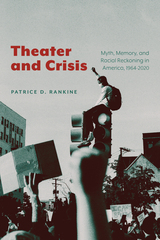 Theater and Crisis: Myth, Memory, and Racial Reckoning in America, 1964-2020
Patrice D. Rankine
Lever Press, 2024 Racial reckoning was a recurrent theme throughout the summer of 2020, a response to George Floyd’s murder and the unprecedented impact of COVID on marginalized groups. Theater and Crisis proposes a literary and theatrical study of how Floyd's killing could possibly happen in the aftermath of the Civil Rights era, and in the supposedly post-racial era following the election of Barack Obama. In the days and months following Floyd's death, there were nightly protests in streets across the United States and broader world. At the same time, theater performances were forced to shift online to video conferencing platforms and to find new ways to engage audiences. In each case, groups made shared meaning through storytelling and narrative, a liberatory process of myth-making and reverence that author Patrice D. Rankine calls “epiphanic encoding.”
Rather than approaching the problem of racial reckoning through history, where periodization and progress are dominant narratives, Theater and Crisis argues that myth and memory allow for better theorization about recurring events from the past, their haunting, and what these apparent ghosts ask of us. Building on the study of myth as active, processual storytelling, Rankine acknowledges that it grounds and orients groups toward significant events. Theater and Crisis aligns narratives about Emmett Till, Trayvon Martin, and George Floyd, among others, with ancient, mythic figures such as Christ, Dionysus, Oedipus, and Moses. As living and verbal visitations, these stories performed on stage encode the past through their epiphanies in the present, urging audiences toward shared meaning.
Rankine traces the cyclical hauntings of race through the refiguring of mythic stories across the past 75 years in the plays of James Baldwin, Ntozake Shange, Antoinette Nwandu, and many more, and in response to flashpoints in US racial history, such as the 1955 lynching of Emmett Till, the upheavals of the 1960s and 1970s, the wars on drugs and crime, and the continued violence against and disenfranchisement of Black people into the twenty-first century. Theater and Crisis explores the appearance of myth on the American stage and showcases the ongoing response by the theatrical establishment to transform the stage into a space for racial reckoning. This timely book is essential reading for scholars of theater studies, classics, and American studies.
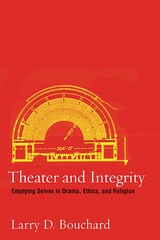 Theater and Integrity: Emptying Selves in Drama, Ethics, and Religion
Larry D Bouchard
Northwestern University Press, 2011 Four decades ago Tom F. Driver brought theater into discussion with religion and modern theology. It has been a rich ongoing dialogue, but one that now demands a bold new engagement. In Theater and Integrity, Larry D. Bouchard argues that while the “antitheatrical prejudice” regards theater as epitomizing the absence of integrity, theater’s ways of being realized in ensembles, texts, and performances allow us to reenvision integrity’s emergence and ephemeral presence. This book follows such questions across theatrical, philosophical, and theological studies of moral, personal, bodily, and kenotic patterns of integrity.
It locates ambiguities in our discourse about integrity, and it delves into conceptions of identity, morality, selfhood, and otherness. Its explorations ask if integrity is less a quality we might possess than a contingent gift that may appear, disappear, and perhaps reappear. Not only does he chart anew the ethical and religious dimensions of integrity, but he also reads closely across the history of theater, from Greek and Shakespearean drama to the likes of Seamus Heaney, T. S. Eliot, Caryl Churchill, Wole Soyinka, Tony Kushner, and Suzan-Lori Parks. His is an approach of juxtaposition and reflection, starting from the perennial observation that theater both criticizes and acknowledges dimensions of drama and theatricality in life.
Theater and Martial Arts in West Sumatra: Randai and Silek of the Minangkabau
Kirstin Pauka
Ohio University Press, 1998 Randai, the popular folk theater tradition of the Minangkabau ethnic group in West Sumatra, has evolved to include influences of martial arts, storytelling, and folk songs. Theater and Martial Arts in West Sumatra describes the origin, development, and cultural background of randai and highlights two recent developments: the emergence of female performers and modern staging techniques. This book also explores the indigenous martial arts form silek, a vital part of randai today. The strong presence of silek is illustrated in the martial focus of the stories that are told through randai, in its movement repertoire, and even in its costumes and musical accompaniment. As Kirstin Pauka shows, randai, firmly rooted in silek and Minangkabau tradition, is an intriguing mirror of the Minangkabau culture.
 Theater and Social Change, Volume 31
Alisa Solomon, ed.
Duke University Press From the Federal Theater Projects of the Great Depression to the disruptive performances of the 1960s and 1970s, theater has played an important role in American radicalism. This special issue of <a href=”http://www.dukeupress.edu/theater> Theater reports on socially conscious, politically active theaters in the United States. Despite the evaporation of Cold War passions and the rise of conservatism in the 1980s and 1990s, such theater work remains a persistent and evolving presence on the political landscape. Since the first inauguration of George W. Bush, new opportunities have arisen for political performance and for significant new challenges to these artists. Theater and Social Change not only tracks the historical evolution of political theater but also explores the current state and future prospects of different modes, including agit-prop, demonstrations, solo performance, Augusto Boal’s Theater of the Oppressed, and community-based production. With such notable contributors as Anna Deavere Smith, Jonathan Kalb, Holly Hughes, and Tony Kushner, the issue offers a diverse assemblage of personal statements, conversations, photographs, interviews, and performance text. Contributors include: Reverend Billy, Jan Cohen-Cruz, Arlene Goldbard, Sharon Green, Lani Guinier, Holly Hughes, Jonathan Kalb, Tony Kushner, Judith Malina, Robbie McCauley, John O'Neal, Claudia Orenstein, Bill Rauch, Julie Salverson, Anna Deavere Smith, Alisa Solomon, Roberta Uno
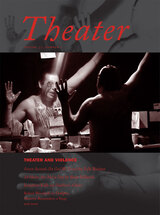 Theater and Violence, Volume 35
Tom Sellar, ed.
Duke University Press As violence escalates around the world, its victims and perpetrators struggle to develop comprehensible narratives to present truthful accounts of history and experience. This special issue of Theater—a collection of theater artists’ responses to contemporary events—examines the human psyche and its capacity for violence and explores theater’s possibilities for political dissent. In Theater and Violence, through interviews, play excerpts, and full-length plays—including the first American publication of two major German playwrights and directors—theater artists offer their own narratives for humankind’s violent psychologies. One full-length play, Falk Richter’s Seven Seconds (In God We Trust), probes the mind of an American pilot moments before he releases a bomb on a city below. Another, René Pollesch’s 24 Hours Are Not a Day, humorously explores the ironies and pathologies of globalization after September 11. The issue also includes a commentary on the National Endowment for the Arts’ Shakespeare presentations for the U.S. military; interviews with Russian theater artists on the first anniversary of the Chechen rebels’ siege of a Moscow theater; and Jonathan Kalb’s powerful adaptation of Heiner Müller’s Mauser, set in Tikrit. Contributors. Josh Fox, Gitta Honegger, Jonathan Kalb, Anna Kohler, James Leverett, Mark Lord, Marlene Norst, René Pollesch, Falk Richter, Yana Ross, Scott Saul, Tom Sellar, Catherine Sheehy, Robert Woodruff
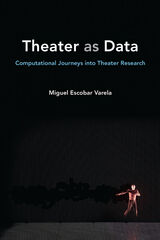 Theater as Data: Computational Journeys into Theater Research
Miguel Escobar Varela
University of Michigan Press, 2021 In Theater as Data, Miguel Escobar Varela explores the use of computational methods and digital data in theater research. He considers the implications of these new approaches, and explains the roles that statistics and visualizations play. Reflecting on recent debates in the humanities, the author suggests that there are two ways of using data, both of which have a place in theater research. Data-driven methods are closer to the pursuit of verifiable results common in the sciences; and data-assisted methods are closer to the interpretive traditions of the humanities. The book surveys four major areas within theater scholarship: texts (not only playscripts but also theater reviews and program booklets); relationships (both the links between fictional characters and the collaborative networks of artists and producers); motion (the movement of performers and objects on stage); and locations (the coordinates of performance events, venues, and touring circuits). Theater as Data examines important contributions to theater studies from similar computational research, including in classical French drama, collaboration networks in Australian theater, contemporary Portuguese choreography, and global productions of Ibsen. This overview is complemented by short descriptions of the author’s own work in the computational analysis of theater practices in Singapore and Indonesia. The author ends by considering the future of computational theater research, underlining the importance of open data and digital sustainability practices, and encouraging readers to consider the benefits of learning to code. A web companion offers illustrative data, programming tutorials, and videos.
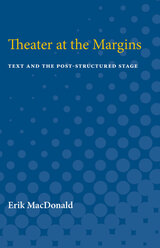 Theater at the Margins: Text and the Post-Structured Stage
Erik MacDonald
University of Michigan Press, 1993 Theater at the Margins: Text and the Post-Structured Stage investigates recent German and American texts in relation to contemporary critical theory. Focusing on the work of writers Kathy Acker, Frank Chin, Caryl Churchill, Rainer Werner Fassbinder, Richard Foreman, Elaine Jackson, Cherrie Moraga, and Wallace Shawn, the book explains how these nontraditionalists challenge the presumptions of traditional dramatic writing and contribute to a unique theatrical sensibility.The introduction to Theater at the Margins situates contemporary post-structuralist, ethnic, and feminist theory in relation to theater and the dramatic text, with specific reference to Derrida's concept of "the margin." Subsequent chapters apply this thinking to specific texts, including Pandering to the Masses; Garbage, The City and Death; The Chickencoop Chinaman; and Giving Up the Ghost. A concluding chapter summarizes these readings and suggests how they might be useful for theater practitioners.The theoretical issues covered are central to both contemporary critical discourse and theatrical practice. By investigating the notion of "margins," of the places in which the dramatic text begins to unravel its ontotheological heritage, Erik MacDonald shows how the possibility for staging philosophy's "Other" emerges. He makes clear, however, that staging this Other is not simply a concern of philosophy; instead, he raises the possibility of a heterogeneous theater that would accentuate the historical and political background of a particular group while at the same time making room for competing voices. Theater at the Margins argues that this heterogeneity of texts could create a theater that would be responsive and responsible to a world no longer defined by a particular center.
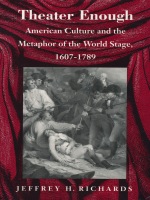 Theater Enough: American Culture and the Metaphor of the World Stage, 1607–1789
Jeffrey H. Richards
Duke University Press, 1991 The early settlers in America had a special relationship to the theater. Though largely without a theater of their own, they developed an ideology of theater that expressed their sense of history, as well as their version of life in the New World. Theater Enough provides an innovative analysis of early American culture by examining the rhetorical shaping of the experience of settlement in the new land through the metaphor of theater.
The rhetoric, or discourse, of early American theater emerged out of the figures of speech that permeated the colonists’ lives and literary productions. Jeffrey H. Richards examines a variety of texts—histories, diaries, letters, journals, poems, sermons, political tracts, trial transcripts, orations, and plays—and looks at the writings of such authors as John Winthrop and Mercy Otis Warren. Richards places the American usage of theatrum mundi—the world depicted as a stage—in the context of classical and Renaissance traditions, but shows how the trope functions in American rhetoric as a register for religious, political, and historical attitudes.
Theater Game File
Viola Spolin
Northwestern University Press, 1989 Violin Spolin was one of the greatest acting coaches in American theater. Improvisation for the Theater, her classic collection of games, acting exercises, and commentary, has been a best-seller for three decades. In the Theater Game File, Spolin creates a special selection of theater games, presented on separate cards in a convenient file box as self-contained classroom workshops. With the the Theater Game File, teachers and students alike, with no prior training or theater experience, can play theater games in the classroom with benefit to all.
Features include:
Over 200 color-coded cards
Suggestions for focusing, side-coaching, and evaluating games
Games for students of all ages and levels of experience
Handbook included
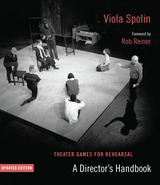 Theater Games for Rehearsal: A Director's Handbook, Updated Edition
Viola Spolin with a foreword by Rob Reiner
Northwestern University Press, 2010 An updated edition of a key reference text by “the high priestess of improvisational theater” A major force in the development of American theater, Viola Spolin devised pedagogical techniques that have influenced and inspired legions of actors, improvisers, and directors. Theater Games for Rehearsal: A Director's Handbook, first published in 1985, is a practical application of Spolin's famous method that guides directors and their companies step-by-step through all phases of the rehearsal period. In Theater Games for Rehearsal, Spolin shows in easy-to-follow detail how her techniques can be used for a variety of theater needs, from selecting performance material, casting, and building a harmonious company to warming up actors, creating stage space, and overcoming opening-night jitters. This new edition, edited by Carol Bleackley Sills, incorporates Spolin's wished-for updates: four important exercises have been added, and instructions presenting her improvisational approach have been clarified throughout. Sidecoaching instructions and game evaluations are boxed and highlighted for on-the-spot reading by the director during rehearsal. With these additions and improvements, Theater Games for Rehearsal: A Director's Handbook brings Spolin's ideas to a new generation with greater accessibility and excitement. Featuring a new foreword by renowned film director Rob Reiner, the updated edition is mandatory for any theater bookshelf.
Theater Games for the Classroom: A Teacher's Handbook
Viola Spolin
Northwestern University Press, 1986 The most comprehensive theater instruction guide for all types of students This best-selling book by Viola Spolin offers the most comprehensive theater instruction for all types of students, from small children to young adults. It includes over 130 theater games, plus exercises and instructional strategies. First developed by Spolin, the originator of modern improvisational theater techniques, these games have been tried and tested for over fifty years.
Theater Games for the Lone Actor: A Handbook
Viola Spolin
Northwestern University Press, 2001 Viola Spolin's Theater Games for the Lone Actor offers theater games and side coaching for the solo player. Available for the first time, this handbook presents more than forty exercises that allow actors to side coach themselves at home, in rehearsal, or in performance.
Spolin's improvisational techniques changed the nature and practice of modern theater. Her work has inspired actors, directors, teachers, and writers in theater, television, and film. Her techniques have also influenced the fields of education, mental health, social work, and psychology.
 Theater in Israel
Linda Ben-Zvi, Editor
University of Michigan Press, 1996 The first volume of its kind in English or Hebrew, Theater in Israel gathers original essays, interviews, and commentaries by leading international theater practitioners and critics. The book explores the rich history and diversity of Israel's theater and illustrates the ways in which this politically committed theater mirrors the historical and cultural forces that have shaped Israeli-Arab relations, the events in the Middle East, and the post-Holocaust Jewish experience.
The collection provides a thorough and engaging survey of the playwrights, directors, actors, and productions that comprise this dynamic theater, a theater whose evolution and ideology diverges from Anglo-American models. The book's early essays trace the development of Hebrew drama from its inception in Moscow in 1918 to the establishment of a national theater and the emergence of a national repertoire.
Succeeding essays explore the personalities and themes that have dominated the Israeli stage, featuring interviews with leading Israeli playwrights, actors, directors, and dramaturgs. The book also provides highlights from the first Palestinian and Israeli Arab Theater Symposium, focusing on the history, themes, and future of Arab theater.
The contributors include Karen Alkalay-Gut, Shosh Avigal, Linda Ben-Zvi, Erella Brown, Joseph Chaikin, Scott Cummings, Ben-Ami Feingold, Gad Kaynar, Shimon Lev- Ari, Shimon Levy, Gabriella Moscati-Steindler, Freddie Rokem, Eli Rozik, Gershon Shaked, Chaim Shoham, Michael Taub, Dan Urian, Shoshana Weitz, and Nurit Yaari.
"Impressive historical, critical, and theoretical depth . . . a sophisticated introduction to theater in Israel." --Anne Golomb Hoffman, Fordham University
Linda Ben-Zvi is Professor of English and Theater, Colorado State University, and Professor of Theater, Tel Aviv University.
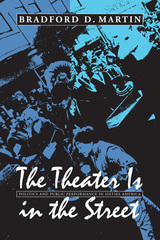 The Theater Is in the Street: Politics and Public Performance in 1960s America
Bradford D. Martin
University of Massachusetts Press, 2004 During the 1960s, the SNCC Freedom Singers, The Living Theatre, the Diggers, the Art Workers Coalition, and the Guerrilla Art Action Group fused art and politics by staging unexpected and uninvited performances in public spaces. Through their activism and the response it provoked, art, theater, and politics began to converge and assume a new visibility in everyday life. While their specific political visions varied, these groups shared the impulse to stage performances and actions publicly—"in the streets"—eschewing museums, theaters, and other conventional halls of culture. Bradford D. Martin offers detailed portraits of each of these groups and examines why they embraced public performance as a vehicle to express and advance their politics.
At a time when the New Left and the counterculture were on the rise, these artists reflected the decade's political and cultural radicalism and helped to define a new aesthetic. Civil rights activists mobilized singing in the struggle for desegregation, introducing a vibrant musical form into the public space. The Living Theatre culminated an arduous quest to mesh artistic and political goals, leading audiences from theaters into the streets to begin the "beautiful nonviolent anarchist revolution." The Diggers playfully engaged San Francisco's counterculture in politics with their carnivalesque public actions. The Art Workers Coalition and the Guerrilla Action Art Group sought to disrupt the conventional art world, mounting protests in and around New York City museums.
By questioning the values and assumptions that separated art from politics, these groups not only established public performance as a legitimate aesthetic but also provided a new creative vocabulary for future generations of artists. Their continued involvement with the women's liberation movement, rural communes, and political street theater into the 1970s and beyond challenges the popular myth that activists disengaged from politics after the 1960s.
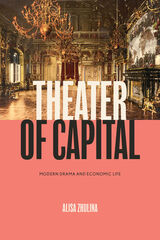 Theater of Capital: Modern Drama and Economic Life
Alisa Zhulina
Northwestern University Press, 2024 Reads canonical works of modern drama in relation to the economic ideas of their era
Emerging amid the turbulent rise of market finance and wider socioeconomic changes, modern drama enacted vital critiques of art and life under capitalism. Alisa Zhulina shows how fin-de-siècle playwrights such as Henrik Ibsen, August Strindberg, Anton Chekhov, George Bernard Shaw, and Gerhart Hauptmann interrogated the meaning of this newly coined economic concept. Acutely aware of their complicity in the system they sought to challenge, these playwrights staged economic questions as moral and political concerns, using their plays to explore the theories of Adam Smith, Karl Marx and Friedrich Engels, Max Weber, and others within the boundaries of bourgeois theater.
Theater of Capital: Modern Drama and Economic Life reveals the prescient and unsettling visions of life in a new financial and societal reality in now-canonical plays such as A Doll’s House, Miss Julie, and The Cherry Orchard, as well as in lesser-known and long-overlooked works. This wide-ranging study prompts us to reevaluate modern drama and its legacy for the urgent economic and political questions that haunt our present moment.
The Theater of Devotion: East Anglian Drama and Society in the Late Middle Ages
Gail McMurray Gibson
University of Chicago Press, 1989 In this interdisciplinary study of drama, arts, and spirituality, Gail Gibson provides a provocative reappraisal of fifteenth-century English theater through a detailed portrait of the flourishing cultures of Suffolk and Norfolk. By emphasizing the importance of the Incarnation of Christ as a model and justification for late medieval drama and art, Gibson challenges currently held views of the secularization of late medieval culture.
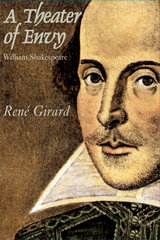 Theater Of Envy: William Shakespeare
Rene Girard
St. Augustine's Press, 2004 In this ground-breaking work, one of our foremost literary and cultural critics turns to the major figure in English literature, William Shakespeare, and proposes a dramatic new reading of nearly all his plays and poems. The key to A Theater of Envy is Girard’s novel reinterpretation of "mimesis." For Girard, people desire objects not for their intrinsic value, but because they are desired by someone else – we mime or imitate their desires. This envy – or "mimetic desire" – he sees as one of the foundations of the human condition.
Bringing such provocative and iconoclastic insights to bear on Shakespeare, Girard reveals the previously overlooked coherence of problem plays like Troilus and Cressida, and makes a convincing argument for elevating A Midsummer Night’s Dream from the status of a chaotic comedy to a masterpiece. The book abounds with novel and provocative interpretations: Shakespeare becomes "a prophet of modern advertising," and the threat of nuclear disaster is read in the light of Hamlet. Most intriguing of all, perhaps, is a brief, but brilliant aside in which an entirely new perspective is brought to the chapter on Joyce’s Ulysses in which Stephen Dedalus gives a lecture on Shakespeare. In Girard’s view only Joyce, perhaps the greatest of twentieth-century novelists, comes close to understanding the greatest of Renaissance playwrights.
Throughout this impressively sustained reading of Shakespeare, Girard’s prose is sophisticated, but contemporary, and accessible to the general reader.
Theater of Essence
Jan Kott
Northwestern University Press, 1986 The sixteen essays collected in The Theater of Essence define the point of view of one of the most influential theater critics of our time. Jan Kott's subjects extend from Tadeusz Borowski, Ibsen, Ionesco, and Gogol to Bunraku theater in Japan, Yiddish theater in New York, and Grotowski's theater in Poland.
The Theater of Michel Vinaver
David Bradby
University of Michigan Press, 1993 Michel Vinaver is considered the outstanding French dramatist of his generation. No other contemporary playwright commands such respect in his own country. Vinaver is the first playwright since the great days of Sartre and Beckett, Ionesco and Genet, to see his complete works published during his lifetime. Since 1955, Vinaver has published sixteen major plays, which have been praised by major critics from Camus to Barthes. Distinguished British scholar David Bradby systematically explores the vital components of Vinaver's achievement, examining his dramatic theory, criticism, and plays as well as the production and reception of his dramatic works. The Theater of Michel Vinaver provides the first English-language reference work for those who wish to study Vinaver's drama and the general development of the French theater over the past four decades.
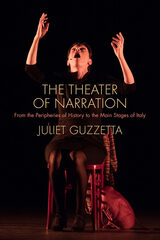 The Theater of Narration: From the Peripheries of History to the Main Stages of Italy
Juliet Guzzetta
Northwestern University Press, 2021 Honorable Mention, Aldo and Jeanne Scaglione Publication Award for a Manuscript in Italian Literary Studies
This book examines the theater of narration, an Italian performance genre and aesthetic that revisits historical events of national importance from local perspectives, drawing on the rich relationship between personal experiences and historical accounts. Incorporating original research from the private archives of leading narrators—artists who write and perform their work—Juliet Guzzetta argues that the practice teaches audiences how ordinary people aren’t simply witnesses to history but participants in its creation.
The theater of narration emerged in Italy during the labor and student protests, domestic terrorism, and social progress of the 1970s. Developing Dario Fo and Franca Rame’s style of political theater, influenced by Jerzy Grotowski and Bertolt Brecht, and following in the freewheeling actor‑author traditions of the commedia dell’arte, narrators created a new form of popular theater that grew in prominence in the 1990s and continues to gain recognition. Guzzetta traces the history of the theater of narration, contextualizing its origins—both political and intellectual—and centers the contributions of Teatro Settimo, a performance group overlooked in previous studies. She also examines the genre’s experiments in television and media.
The first full-length book in English on the subject, The Theater of Narration leverages close readings and a wealth of primary sources to examine the techniques used by narrators to remake history—a process that reveals the ways in which history itself is a theater of narration.
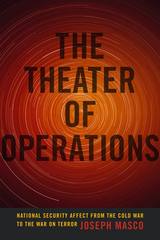 The Theater of Operations: National Security Affect from the Cold War to the War on Terror
Joseph Masco
Duke University Press, 2014 How did the most powerful nation on earth come to embrace terror as the organizing principle of its security policy? In The Theater of Operations, Joseph Masco locates the origins of the present-day U.S. counterterrorism apparatus in the Cold War's "balance of terror." He shows how, after the attacks of 9/11, the U.S. global War on Terror mobilized a wide range of affective, conceptual, and institutional resources established during the Cold War to enable a new planetary theater of operations. Tracing how specific aspects of emotional management, existential danger, state secrecy, and threat awareness have evolved as core aspects of the American social contract, Masco draws on archival, media, and ethnographic resources to offer a new portrait of American national security culture. Undemocratic and unrelenting, this counterterror state prioritizes speculative practices over facts, and ignores everyday forms of violence across climate, capital, and health in an unprecedented effort to anticipate and eliminate terror threats—real, imagined, and emergent.
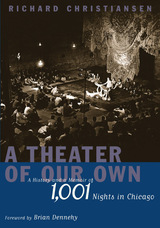 A Theater of Our Own: A History and a Memoir of 1,001 Nights in Chicago
Richard Christiansen, with a foreword by Brian Dennehy
Northwestern University Press, 2004 Winner of the Illinois State Historical Society Book Award for Superior Achievement
A Theater of Our Own is a fascinating, fast-paced, and fact-filled chronicle of Chicago's legendary theater scene by the long-time chief critic for the Chicago Tribune. Who produced the first stage adaptation of "The Wizard of Oz" in 1902-nearly forty years before the movie classic? What entertainment juggernaut began in a converted Chinese laundry on Wells Street in 1959? Where did Louis (Studs) Terkel make his stage debut? When did the original production of "Grease" open at Kingston Mines Theater? Richard Christiansen, former chief critic for the Chicago Tribune, answers these and many more questions about the rich role of the theater in Chicago, from its earliest days in 1837 to its present state as a diverse community of artists with international stature.
In A Theater of Our Own, he draws upon his exclusive interviews, insights, and memories gathered over a period of more than forty years of reviewing the arts. This history and memoir traces the evolution of the Chicago theater scene from small theaters to major institutions such as the Steppenwolf Theatre Company, the Goodman Theater, and The Second City. Along the way, Richard Christiansen relates his behind-the-scenes conversations with some of Chicago's most acclaimed writers, directors, and actors--David Mamet, Frank Galati, Mary Zimmerman, John Malkovich, Laurie Metcalf, Harold Ramis, Gary Sinise, and Joe Mantegna--all a part of Chicago's theater renaissance from the 1970s onward. To this day, Chicago remains a city known for its imaginative, innovative, and influential theaters and artists. A Theater of Our Own, a valuable contribution to the history of theater, is a book written for anyone who enjoys the theater and its people as well as the story of Chicago.
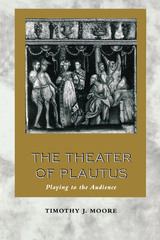 The Theater of Plautus: Playing to the Audience
By Timothy J. Moore
University of Texas Press, 1998 The relationship between actors and spectators has been of perennial interest to playwrights. The Roman playwright Plautus (ca. 200 BCE) was particularly adept at manipulating this relationship. Plautus allowed his actors to acknowledge freely the illusion in which they were taking part, to elicit laughter through humorous asides and monologues, and simultaneously to flatter and tease the spectators. These metatheatrical techniques are the focus of Timothy J. Moore's innovative study of the comedies of Plautus. The first part of the book examines Plautus' techniques in detail, while the second part explores how he used them in the plays Pseudolus, Amphitruo, Curculio, Truculentus, Casina, and Captivi. Moore shows that Plautus employed these dramatic devices not only to entertain his audience but also to satirize aspects of Roman society, such as shady business practices and extravagant spending on prostitutes, and to challenge his spectators' preconceptions about such issues as marriage and slavery. These findings forge new links between Roman comedy and the social and historical context of its performance.
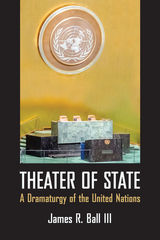 Theater of State: A Dramaturgy of the United Nations
James R. Ball III
Northwestern University Press, 2020 In this innovative study of performance in international relations, James R. Ball III asks why states and their representatives come to the United Nations to perform for a global audience and how those audiences may intervene in the spectacle of global politics. Theater of State looks at key spaces in which global politics play out: in debating forums of the UN, at the International Criminal Court in The Hague, and in peacekeeping operations in Africa and the Middle East, as well as in a variety of related media productions. Ball argues that culture and politics form a unified field organized by the theatricality of its actors and the engaged spectatorship of its audiences. He provides a theory of global political spectatorship: of how the world watches itself in institutions and beyond, and of what citizens and diplomats do by watching.
This study of the lived experience of spectacular politics on the world stage draws on theories of theater, performance, and politics to offer new ways of approaching issues of war, cosmopolitanism, international justice, governance, and activism. Situated at the nexus of two disciplines, performance studies and political science, this volume encourages conversations between the two so that each might offer lessons to the other.
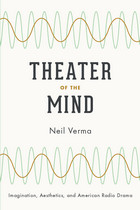 Theater of the Mind: Imagination, Aesthetics, and American Radio Drama
Neil Verma
University of Chicago Press, 2012 For generations, fans and critics have characterized classic American radio drama as a “theater of the mind.” This book unpacks that characterization by recasting the radio play as an aesthetic object within its unique historical context. In Theater of the Mind, Neil Verma applies an array of critical methods to more than six thousand recordings to produce a vivid new account of radio drama from the Depression to the Cold War. In this sweeping exploration of dramatic conventions, Verma investigates legendary dramas by the likes of Norman Corwin, Lucille Fletcher, and Wyllis Cooper on key programs ranging from The Columbia Workshop, The Mercury Theater on the Air, and Cavalcade of America to Lights Out!, Suspense, and Dragnet to reveal how these programs promoted and evolved a series of models of the imagination. With close readings of individual sound effects and charts of broad trends among formats, Verma not only gives us a new account of the most flourishing form of genre fiction in the mid-twentieth century but also presents a powerful case for the central place of the aesthetics of sound in the history of modern experience.
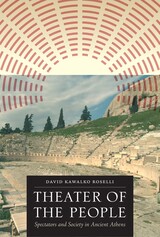 Theater of the People: Spectators and Society in Ancient Athens
By David Kawalko Roselli
University of Texas Press, 2011 Greek drama has been subject to ongoing textual and historical interpretation, but surprisingly little scholarship has examined the people who composed the theater audiences in Athens. Typically, scholars have presupposed an audience of Athenian male citizens viewing dramas created exclusively for themselves—a model that reduces theater to little more than a medium for propaganda. Women's theater attendance remains controversial, and little attention has been paid to the social class and ethnicity of the spectators. Whose theater was it? Producing the first book-length work on the subject, David Kawalko Roselli draws on archaeological and epigraphic evidence, economic and social history, performance studies, and ancient stories about the theater to offer a wide-ranging study that addresses the contested authority of audiences and their historical constitution. Space, money, the rise of the theater industry, and broader social forces emerge as key factors in this analysis. In repopulating audiences with foreigners, slaves, women, and the poor, this book challenges the basis of orthodox interpretations of Greek drama and places the politically and socially marginal at the heart of the theater. Featuring an analysis of the audiences of Aeschylus, Sophocles, Euripides, Aristophanes, and Menander, Theater of the People brings to life perhaps the most powerful influence on the most prominent dramatic poets of their day.
 Theater of War
Edited by Meredith Davenport
Intellect Books, 2015 For five years, Meredith Davenport has photographed and interviewed men who play live-action games based on contemporary conflicts, such as a recreation of the hunt for Osama Bin Laden that took place thousands of miles from the conflict zone on a campground in Northern Virginia. Her images speak about the way that trauma and conflict penetrate a culture sheltered from the horrors of war.
Bringing together a series of two dozen photographs with essays discussing and analyzing the influence of the media, particularly photographs and video, on the culture at large and how conflict is "discussed" in the visual realm, Theater of War is a unique look at the influence of contemporary conflict, and their omni-presence in the media on popular culture. Written by an experienced photojournalist who has covered a variety of human rights issues worldwide, this book is an essential addition to the library of anyone interested in the confluence of war and media.
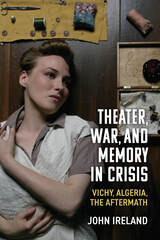 Theater, War, and Memory in Crisis: Vichy, Algeria, the Aftermath
John Ireland
University of Michigan Press, 2025 Theater, War, and Memory in Crisis explores how French and Algerian dramatists have engaged with two traumatic events that continue to haunt France: the German occupation and Vichy government from 1940 to 1944 and the Algerian War from 1954 to 1962. John Ireland’s investigation is guided by one central question: can theater take on issues of violence, war trauma, and conflicted memory in a fundamentally different way from archival forms of culture such as memoirs, narrative fiction, and film? Throughout the twentieth century, French cultural anthropologists, classicists, and social scientists repeatedly revisited links between archaic religious ritual, the practice of sacrifice, and Greek tragedy as attempts to understand, regulate, and mitigate the violence of human conflict and war. Ireland argues that contemporary French playwrights dealing with war trauma and contested memory were influenced by aspects of this research that foregrounded the core virtues of oral culture: presence and the present, the “here and now” that also regulate theatrical performance. That connection to the present encouraged dramatists and performance artists to make “live” historiographical contributions to reverberating, unresolved history but also revived perennial therapeutic values of oral culture that evolved in ancient Greece. Theater, War, and Memory in Crisis brings original readings of canonical authors like Jean-Paul Sartre, Jean Genet, Bernard-Marie Koltès, and Kateb Yacine into dialogue with non-canonical dramatists such as Armand Gatti, Liliane Atlan, and Noureddine Aba.
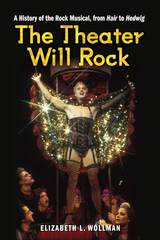 The Theater Will Rock: A History of the Rock Musical, from Hair to Hedwig
Elizabeth L. Wollman
University of Michigan Press, 2010 "A much-needed study of the impact of rock music on the musical theater and its resulting challenges, complexities, failures, and successes. Anyone interested in Broadway will learn a great deal from this book."
---William Everett, author of The Musical: A Research Guide to Musical Theatre "As Wollman weaves her historical narrative, she compellingly returns to . . . the conflict between the aesthetics and ideologies of rock music and the disciplined and commercial practices of the musical stage."
---Theatre Research International "This well-written account puts the highs and lows of producing staged rock musicals in New York City into perspective and is well worth reading for the depth of insight it provides."
---Studies in Musical Theatre The tumultuous decade of the 1960s in America gave birth to many new ideas and forms of expression, among them the rock musical. An unlikely offspring of the performing arts, the rock musical appeared when two highly distinctive and American art forms joined onstage in New York City. The Theater Will Rock explores the history of the rock musical, which has since evolved to become one of the most important cultural influences on American musical theater, and a major cultural export.
Despite the genre’s influence and fame, there are still some critics who claim that the term “rock musical” is an oxymoron. The relationship between rock and the musical theater has been stormy from the start, and even the comparatively recent success of Rent has done little to convince theater producers that rock musicals are anything but highly risky ventures. Elizabeth L. Wollman explores the reasons behind these problematic connections and looks at the socioeconomic forces that underlie aesthetic decisions. She weighs the influence on the rock musical by mass media, sound, and recording technology, and the economic pressures that have affected New York theater in general over the past three decades. Finally, Wollman offers a meditation on the state of the musical, its relation to rock, and, ultimately, its future.
Packed with candid commentary by members of New York's vibrant theater community, The Theater Will Rock traces the rock musical’s evolution over nearly fifty years, in popular productions such as Hair, The Who's Tommy, Jesus Christ Superstar, The Rocky Horror Picture Show, Little Shop of Horrors, Rent, and Mamma Mia!—and in notable flops such as The Capeman.
Elizabeth L. Wollman is Assistant Professor of Music at Baruch College of the City University of New York.
Theatermachine: Tadeusz Kantor in Context
Edited by Magda Romanska and Kathleen Cioffi
Northwestern University Press, 2019 Theatermachine: Tadeusz Kantor in Context is an in-depth, multidisciplinary compendium of essays that examine Kantor’s work through the prism of postmemory and trauma theory and in relation to Polish literature, Jewish culture, and Yiddish theater as well as the Japanese, German, French, Polish, and American avant-garde. Hans-Thies Lehmann’s theory of postdramatic theater and contemporary developments in critical theory—particularly Bill Brown’s thing theory, Bruno Latour’s actor network theory, and posthumanism—provide a previously unavailable vocabulary for discussion of Kantor’s theater.
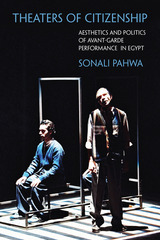 Theaters of Citizenship: Aesthetics and Politics of Avant-Garde Performance in Egypt
Sonali Pahwa
Northwestern University Press, 2020 Theaters of Citizenship investigates independent Egyptian performance practices from 2004 to 2014 to demonstrate how young dramatists staged new narratives of citizenship outside of state institutions, exploring rights claims and enacting generational identity. Using historiography, ethnography, and performance analysis, the book traces this avant-garde from the theater networks of the late Hosni Mubarak era to productions following the Egyptian revolution of 2011.
In 2004, independent cultural institutions were sites for more democratic forms of youth organization and cultural participation than were Egyptian state theaters. Sonali Pahwa looks at identity formation within this infrastructure for new cultural production: festivals, independent troupes, workshops, and manifesto movements. Bringing institutional changes in dialogue with new performance styles on stages and streets, Pahwa conceptualizes performance culture as a school of citizenship. Independent theater incubated hope in times of despair and pointed to different futures for the nation’s youth than those seen in television and newspapers. Young dramatists countered their generation’s marginalization in the neoliberal economy, media, and political institutions as they performed alternative visions for the nation. An important contribution to the fields of anthropology and performance studies, Pahwa’s analysis will also interest students of sociology and Egyptian history.
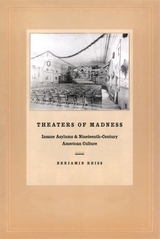 Theaters of Madness: Insane Asylums and Nineteenth-Century American Culture
Benjamin Reiss
University of Chicago Press, 2008 In the mid-1800s, a utopian movement to rehabilitate the insane resulted in a wave of publicly funded asylums—many of which became unexpected centers of cultural activity. Housed in magnificent structures with lush grounds, patients participated in theatrical programs, debating societies, literary journals, schools, and religious services. Theaters of Madness explores both the culture these rich offerings fomented and the asylum’s place in the fabric of nineteenth-century life, reanimating a time when the treatment of the insane was a central topic in debates over democracy, freedom, and modernity. Benjamin Reiss explores the creative lives of patients and the cultural demands of their doctors. Their frequently clashing views turned practically all of American culture—from blackface minstrel shows to the works of William Shakespeare—into a battlefield in the war on insanity. Reiss also shows how asylums touched the lives and shaped the writing of key figures, such as Emerson and Poe, who viewed the system alternately as the fulfillment of a democratic ideal and as a kind of medical enslavement. Without neglecting this troubling contradiction, Theaters of Madness prompts us to reflect on what our society can learn from a generation that urgently and creatively tried to solve the problem of mental illness.
 Theaters of Occupation: Hollywood and the Reeducation of Postwar Germany
Jennifer Fay
University of Minnesota Press, 2008 In the aftermath of total war and unconditional surrender, Germans found themselves receiving instruction from their American occupiers. It was not a conventional education. In their effort to transform German national identity and convert a Nazi past into a democratic future, the Americans deployed what they perceived as the most powerful and convincing weapon-movies. In a rigorous analysis of the American occupation of postwar Germany and the military’s use of “soft power,” Jennifer Fay considers how Hollywood films, including Ninotchka, Gaslight, and Stagecoach, influenced German culture and cinema. In this cinematic pedagogy, dark fantasies of American democracy and its history were unwittingly played out on-screen. Theaters of Occupation reveals how Germans responded to these education efforts and offers new insights about American exceptionalism and virtual democracy at the dawn of the cold war. Fay’s innovative approach examines the culture of occupation not only as a phase in U.S.–German relations but as a distinct space with its own discrete cultural practices. As the American occupation of Germany has become a paradigm for more recent military operations, Fay argues that we must question its efficacy as a mechanism of cultural and political change. Jennifer Fay is associate professor and codirector of film studies in the Department of English at Michigan State University.
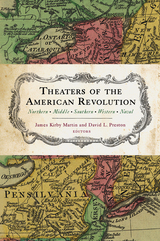 Theaters of the American Revolution: Northern, Middle, Southern, Western, Naval
James Kirby Martin
Westholme Publishing, 2023 Understanding the Course of the War for American independence through Geographical Regions
Identifying discrete geographical areas in order to better understand a conflict that moves across hundreds of thousands of square miles of land and water, such as the American Civil War and World War II, has been a valuable historical method. During this time of greater study of the war that made America, the authors of Theaters of the American Revolution take this approach for the first time. The result is a stimulating volume that will allow readers to see how the war flowed from region to region from 1775 to 1781, beginning in the Northern colonies and Canada, through the dark months in the Middle colonies, to a shift to the South and culmination at Yorktown. Simultaneously, the war raged up and down the western frontier, with the Patriots working to keep the British and their Indian allies from disrupting the main battle armies to the east. Equally important was the war at sea, where American privateers and a fledgling navy attempted to harass the British; but with the entrance of France to the conflict, the control of the sea took a much more balanced—and important— aspect. With specially commissioned maps and colorful descriptions of eighteenth century American terrain, settlements, and cities, as well as key battles, Theaters of the American Revolution provides an ideal introduction to understanding one of the most important wars in world history in its totality.
Contents
Introduction • James Kirby Martin and David L. Preston
The Northern Theater • James Kirby Martin
The Middle Theater • Edward G. Lengel and Mark Edward Lender
The Southern Theater • Jim Piecuch
The Western Theater • Mark Edward Lender
The Naval Theater • Charles Neimeyer
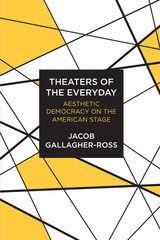 Theaters of the Everyday: Aesthetic Democracy on the American Stage
Jacob Gallagher-Ross
Northwestern University Press, 2018 Theaters of the Everyday: Aesthetic Democracy on the American Stage reveals a vital but little-recognized current in American theatrical history: the dramatic representation of the quotidian and mundane. Jacob Gallagher-Ross shows how twentieth-century American theater became a space for negotiating the demands of innovative form and democratic availability.
Offering both fresh reappraisals of canonical figures and movements and new examinations of theatrical innovators, Theaters of the Everyday reveals surprising affinities between artists often considered poles apart, such as John Cage and Lee Strasberg, and Thornton Wilder and the New York experimentalist Nature Theater of Oklahoma. Gallagher-Ross persuasively shows how these creators eschew conventional definitions of dramatic action and focus attention on smaller but no less profound dramas of perception, consciousness, and day-to-day life.
Gallagher-Ross traces some of the intellectual roots of the theater of the everyday to American transcendentalism, with its pragmatic process philosophy as well as its sense of ordinary experience as the wellspring of aesthetic awareness.
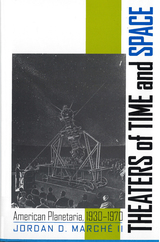 Theaters of Time and Space: American Planetaria, 1930-1970
Marche, Jordan
Rutgers University Press, 2005 Every year, millions of Americans visit planetariums and are captivated by their strikingly realistic portrayal of the night sky. Today, it is indeed difficult to imagine astronomy education without these magnificent celestial theaters. But projection planetariums, first developed in Germany, have been a part of American museum pedagogy only since the early twentieth century and were not widespread until the 1960s.
In this unique social history,former planetarium director and historian of science Jordan D. Marché II offers the first complete account of the community of individuals and institutions that, during the period between 1930 and 1970, made planetariums the popular teaching aids they are today. Marché addresses issues such as the role of gender and social developments within the planetarium community, institutional patronage, and the popularization of science. He reveals how, at different times, various groups, including financial donors, amateur scientists, and government officials, viewed the planetarium as an instrument through which they could shape public understanding and perceptions of astronomy and space science.
Offering an insightful, wide-ranging look into the origins of an institution that has fascinated millions, Theaters of Timeand Space brings new perspectives to how one educational community changed the cultural complexion of science, helped shape public attitudes toward the U.S. space program, and even contributed to policy decisions regarding allocations for future space research.
 Theaters of Translation: Cosmopolitan Vernaculars in Shakespeare's England
Andrew S. Keener
University of Alabama Press, 2025 Explores the profound influence of multilingual dictionaries, dialogues, and grammars on English Renaissance playwrights In Theaters of Translation, Andrew S. Keener offers a fascinating account of the ways that plays by Thomas Kyd, Mary Sidney Herbert, Ben Jonson, and their fellow English contemporaries were shaped by and part of a multilingual Europe where dictionaries, grammars, and language-learning materials circulated widely. He proposes a fresh, multilingual approach to English Renaissance drama that challenges the histories of early modern European languages as sites of national and linguistic cohesion. Covering the period between 1570 and 1640, when England’s drama and the English language itself were evolving, Keener uses the term “cosmopolitan vernaculars” to examine how nonclassical European languages modeled transnational forms of belonging for playgoers, readers, and authors in Renaissance England. Combining recent contributions to cosmopolitan theory and transnational studies of early modern literature and culture, Keener highlights both the ways in which cosmopolitanism manifests through Europe’s vernacular languages—in print and performance—and the ways languages themselves can exhibit cosmopolitanism for those who encounter them on the page or on the stage. Theaters of Translation opens up new transnational interpretations of English Renaissance plays and casts fresh light on historical anecdotes, such as Jonson inscribing a copy of Pietro Aretino’s scandalous Italian dialogues or Shakespeare’s First Folio being advertised for sale in Germany before its London publication. It offers much of interest to readers and scholars of Renaissance Europe, early modern drama, and the development of national European languages.
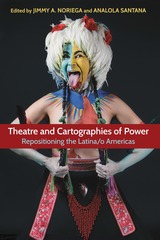 Theatre and Cartographies of Power: Repositioning the Latina/o Americas
Edited by Jimmy A. Noriega and Analola Santana
Southern Illinois University Press, 2018 From the colonial period to independence and into the twenty-first century, Latin American culture has been mapped as a subordinate “other” to Europe and the United States. This collection reconsiders geographical space and power and the ways in which theatrical and performance histories have been constructed throughout the Americas. Essays bridge political, racial, gender, class, and national divides that have traditionally restricted and distorted our understanding of Latin American theatre and performance. Contributors—scholars and artists from throughout the Americas, including well-known playwrights, directors, and performers—imagine how to reposition the Latina/o Americas in ways that offer agency to its multiple peoples, cultures, and histories. In addition, they explore the ways artists can create new maps and methods for their creative visions.
Building on hemispheric and transnational models, this book demonstrates the capacity of theatre studies to challenge the up-down/North-South approach that dominates scholarship in the United States and presents a strong case for a repositioning of the Latina/o Americas in theatrical histories and practices.
 Theatre and Consciousness: Explanatory Scope and Future Potential
Daniel Meyer-Dinkgräfe
Intellect Books, 1995 For the last ten to fifteen years, many disciplines of scholarship have been involved in the study of consciousness, often on an interdisciplinary basis. They include philosophy, neurosciences, psychology, physics and biology, and approaches focusing on human experience. The Centre for Consciousness Studies at the University of Arizona in Tucson spearheaded this development with its bi-annual conferences since 1994, and a wide range of associations, journals and book publications bear witness to its importance. Over the same number of years, scholarly interest in the relationship of consciousness to theatre has equally grown. The book discusses a range of questions relevant to understanding the phenomenon of theatre against a consciousness studies background. Those questions include:
• What inspires the dramatist to write a play? This question addresses the nature of the creative process.
• How do different plays reflect human consciousness?
• What kinds of new ideas did major directors or theatre makers, such as Artaud, Grotowski, Barba, and Brook introduce?
• Should actors be personally involved with the emotions they have to portray?
• Are puppets or marionettes superior to actors?
• How to account for the designer’s combination of creativity and practical skill? What part does mental imagination play in the design process? How do designers get their own spatial awareness across to their spectators?
• How does theatre affect the spectator? Why do spectators react as they do? How do distance and suspension of disbelief ‘work’?
An improved and expanded understanding of theatre, resulting from answering the questions above in the context of consciousness studies, should inspire new developments in theatre practice.
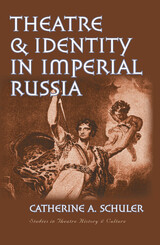 Theatre and Identity in Imperial Russia
Catherine A. Schuler
University of Iowa Press, 2009 What role did the theatre—both institutionally and literally—play in Russia’s modernization? How did the comparatively harmonious relationship that developed among the state, the nobility, and the theatre in the eighteenth century transform into ideological warfare between the state and the intelligentsia in the nineteenth? How were the identities of the Russian people and the Russian soul configured and altered by actors in St. Petersburg and Moscow? Using the dramatic events of nineteenth-century Russian history as a backdrop, Catherine Schuler answers these questions by revealing the intricate links among national modernization, identity, and theatre.
Schuler draws upon contemporary journals written and published by the educated nobility and the intelligentsia—who represented the intellectual, aesthetic, and cultural groups of the day—as well as upon the laws of the Russian empire and upon theatrical memoirs. With fascinating detail, she spotlights the ideologically charged binaries ascribed to prominent actors—authentic/performed, primitive/civilized, Russian/Western—that mirrored the volatility of national identity from the Napoleonic Wars through the reign of Alexander II.
If the path traveled by Russian artists and audiences from the turn of the nineteenth century to the era of the Great Reforms reveals anything about Russian culture and society, it may be that there is nothing more difficult than being Russian in Russia. By exploring the ways in which theatrical administrators, playwrights, and actors responded to three tsars, two wars, and a major revolt, this carefully crafted book demonstrates the battle for the hearts and minds of the Russian people.
Theatre and Performance in Small Nations
Edited by Steve Blandford
Intellect Books, 2013 Arguing that the cultures of small nations offer vital insights into the way people relate to national identity in a globalized world, Theatre and Performance in Small Nations features an array of case studies that examine the relationships between theater, performance, identity, and the nation. These contributions cover a wide range of national contexts, including small “stateless” nations such as Catalonia, Scotland, and Wales; First Nations such as indigenous Australia and the Latino United States; and geographically enormous nations whose relationships to powerful neighbors radically affect their sense of cultural autonomy
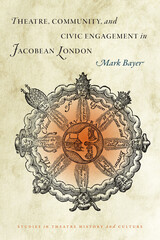 Theatre, Community, and Civic Engagement in Jacobean London
Mark Bayer
University of Iowa Press, 2011 Taking to heart Thomas Heywood’s claim that plays “persuade men to humanity and good life, instruct them in civility and good manners, showing them the fruits of honesty, and the end of villainy,” Mark Bayer’s captivating new study argues that the early modern London theatre was an important community institution whose influence extended far beyond its economic, religious, educational, and entertainment contributions. Bayer concentrates not on the theatres where Shakespeare’s plays were performed but on two important amphitheatres, the Fortune and the Red Bull, that offer a more nuanced picture of the Jacobean playgoing industry. By looking at these playhouses, the plays they staged, their audiences, and the communities they served, he explores the local dimensions of playgoing. Focusing primarily on plays and theatres from 1599 to 1625, Bayer suggests that playhouses became intimately engaged with those living and working in their surrounding neighborhoods. They contributed to local commerce and charitable endeavors, offered a convivial gathering place where current social and political issues were sifted, and helped to define and articulate the shared values of their audiences. Bayer uses the concept of social capital, inherent in the connections formed among individuals in various communities, to construct a sociology of the theatre from below—from the particular communities it served—rather than from the broader perspectives imposed from above by church and state. By transacting social capital, whether progressive or hostile, the large public amphitheatres created new and unique groups that, over the course of millions of visits to the playhouses in the Jacobean era, contributed to a broad range of social practices integral to the daily lives of playgoers. In lively and convincing prose that illuminates the significant reciprocal relationships between different playhouses and their playgoers, Bayer shows that theatres could inform and benefit London society and the communities geographically closest to them.
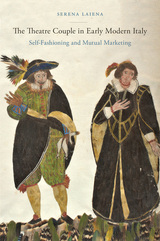 The Theatre Couple in Early Modern Italy: Self-Fashioning and Mutual Marketing
Serena Laiena
University of Delaware Press, 2024 Winner of the Luca Attanasio International Flaiano Award for Italian Studies
Who were the first celebrity couples? How was their success forged? Which forces influenced their self-fashioning and marketing strategies?
These questions are at the core of this study, which looks at the birth of a phenomenon, that of the couple in show business, with a focus on the promotional strategies devised by two professional performers: Giovan Battista Andreini (1576–1654) and Virginia Ramponi (1583–ca.1631). This book examines their artistic path – a deliberately crafted and mutually beneficial joint career – and links it to the historical, social, and cultural context of post-Tridentine Italy. Rooted in a broad research field, encompassing theatre history, Italian studies, celebrity studies, gender studies, and performance studies, The Theatre Couple in Early Modern Italy revises the conventional view of the Italian diva, investigates the deployment of Catholic devotion as a marketing tool, and argues for the importance of the couple system in the history of Commedia dell’Arte, a system that continues to shape celebrity today.
 Theatre Fandom: Engaged Audiences in the Twenty-first Century
Kirsty Sedgman
University of Iowa Press, 2025 By bringing together a range of discussions from leading international fan and performance studies scholars, Theatre Fandom tracks key case studies of theatre fans across different eras, performance forms, and cultures. The contributors emphasize the importance of considering theatrical elements such as pleasure, engagement, allure, enjoyment, and love. They illustrate how leveraging fan enthusiasm can foster greater and more meaningful participation in the cultural industries, potentially guiding us towards a thriving post-pandemic future for theatre.
Contributors: Tom Cantrell, Francesca Coppa, Ruth Foulis, Helen Freshwater, Emily Garside, Caroline Heim, Matt Hills, Natalie Ibu, Laura MacDonald, Dominique Morisseau, Rachael Nicholas, Louie Lang Norman, Owen G. Parry, Stephanie E. Pitts, Sarah M. Price, Beth Emily Richards, Kirsty Sedgman, Megan Vaughan, Ben Walmsley, Sarah K. Whitfield
Theatre for Children in Hospital: The Gift of Compassion
Persephone Sextou
Intellect Books, 2016 Recent decades have seen a new appreciation develop for applied theater and the role of arts-based activities in health care. This book looks specifically at the place of theater for children who are hospitalized, showing how powerfully it can enhance their social and mental well-being. Child-led performances, for example, can be used as a technique to distract young patients from hospitalization, prepare them for painful procedures, and teach them calming techniques to control their own pre- or post-operative stress. Persephone Sextou details the key theoretical contexts and practical features of theater for children, in the process offering motivation, guidance, and inspiration for practitioners who want to incorporate performance into their treatment regimen.
 Theatre for Lifelong Learning: A Handbook for Instructors, Older Adults, Communities, and Artists
Linda Lau and Rae Mansfield
Intellect Books, 2024 A step-by-step guide for anyone interested in teaching theater courses and creating theater with older adults.
Theatre for Lifelong Learning is a step-by-step guide for anyone interested in teaching theatre courses and creating theatre with older adults. This book provides instructors with syllabi, discussion questions, classroom management strategies, resource lists, and activities to teach courses from beginning to end. Special topics include playwriting, play development, storytelling, theatre appreciation, theatre criticism, theatre history, and theatre theory.
Older adult theatre courses support emotional well-being and the development of artistic communities and anyone can contribute to lifelong learning as an instructor. If you are new to theatre and theatre education, Theatre for Lifelong Learning offers tips throughout to assist you in creating accessible environments and making courses your own. If you have a background in performing arts, this book enriches your experience with interdisciplinary approaches to share your expertise. If you are an educator, it provides useful strategies to adapt your current skill set for the theatre classroom.
Regardless of your experience, you can help older adults connect, engage, and create. You may find yourself learning, exploring, and experimenting alongside your students. Teaching older adults theatre will contribute to your own enjoyment. In theatre, everyone gets to have fun!
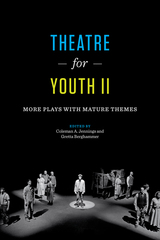 Theatre for Youth II: More Plays with Mature Themes
Edited Coleman A. Jennings and Gretta Berghammer
University of Texas Press, 2016 When Theatre for Youth: Twelve Plays with Mature Themes was published in 1986, it met a need for plays that could help young people deal with some of the more difficult realities of life. Responding to the sweeping changes in society over the succeeding thirty years, Coleman A. Jennings and Gretta Berghammer have assembled a new collection of plays that reflects not only on themes such as aging, death and dying, friendship, courage, conformity, maturation, sexuality, and struggles with moral judgment but also on gender identity, poverty, diversity, and discrimination. Theatre for Youth II: More Plays with Mature Themes presents twelve plays, nine of them new to this anthology, that offer a rich variety of original stories (The Tomato Plant Girl, The Arkansaw Bear, Super Cowgirl and Mighty Miracle), compelling adaptations (The Afternoon of the Elves, Broken Hearts, Courage!), historical drama (Mother Hicks, Johnny Tremain), diverse themes (La Ofrenda, The Transition of Doodle Pequeño), friendship (The Selfish Giant), and future societies (With Two Wings). As these plays explore some of the most challenging themes for today’s youth, including the difficulties of single parenthood, divorce, race relations, sexuality, and gender discrimination, they share messages fundamental to us all: open your imagination and dare to dream; embrace life; honor your personal passion, beliefs, and creativity; take a risk; and love with all your heart.
Theatre for Youth Third Space: Performance, Democracy, and Community Cultural Development
Stephani Etheridge Woodson
Intellect Books, 2015 Theatre for Youth Third Space is a practical yet philosophically grounded handbook for people working in theater and performance with children and youth in community or educational settings. Presenting asset development approaches, deliberative dialogue techniques, and frames for building strong community relationships, Stephani Etheridge Woodson shares multiple project models that are firmly grounded in the latest community cultural development practices. Guiding readers step by step through project planning, creating safe environments, and using evaluation protocols, Theatre for Youth Third Space will be an invaluable resource for both teaching and practice.
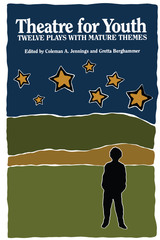 Theatre for Youth: Twelve Plays with Mature Themes
Edited by Coleman A. Jennings and Gretta Berghammer
University of Texas Press, 1986 Since the beginning of the theatre-for-youth movement in the United States, the majority of plays written for children have been fairy tales. By the 1960s, however, encouraged by changes in social attitudes toward children, playwrights began to respond to a growing tendency on the parts of both parents and teachers to have children face, rather than avoid, the more difficult truths of existence. Thus children's dramatic literature was opened to new subjects, themes and characters previously considered unsuitable for the young audience. Theatre for Youth seeks to identify and illustrate this trend by examining twelve plays that deal with mature themes: aging, death and dying, conformity, sexuality, divorce, moral culpability. The plays have been chosen not only for their mature content, but also for their professional integrity, the delicacy with which they handle their subject matter, and their respect for their intended audience. A foreword by Jed H. Davis, an introduction and summary paragraphs for each play by Jennings and Berghammer, and a lengthy annotated list of suggested plays for further reading or viewing make this volume extremely useful both for directors of children's theatre and for teachers.
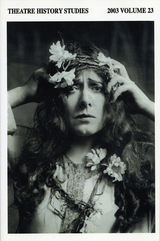 Theatre History Studies 2003, Vol. 23
Robert A. Schanke
University of Alabama Press, 2003 Theatre History Studies is a peer-reviewed journal of theatre history and scholarship published annually since 1981 by the Mid-American Theatre Conference (MATC), a regional body devoted to theatre scholarship and practice. The conference encompasses the states of Illinois, Iowa, Nebraska, Kansas, Missouri, Minnesota, North Dakota, South Dakota, Wisconsin, Indiana, Michigan, and Ohio. The purpose of the conference is to unite persons and organizations within the region with an interest in theatre and to promote the growth and development of all forms of theatre. THS is a member of the Council of Editors of Learned Journals and is included in the MLA Directory of Periodicals. THS is indexed in Humanities Index, Humanities Abstracts, Book Review Index, MLA International Bibliography, International Bibliography of Theatre, Arts & Humanities Citation Index, IBZ International Bibliography of Periodical Literature, and IBR International Bibliography of Book Reviews. Full texts of essays appear in the databases of both Humanities Abstracts Full Text as well as SIRS.
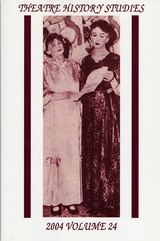 Theatre History Studies 2004, Vol. 24: Volu
Robert A. Schanke
University of Alabama Press, 2004 Theatre History Studies is a peer-reviewed journal of theatre history and scholarship published annually since 1981 by the Mid-American Theatre Conference (MATC), a regional body devoted to theatre scholarship and practice. The conference encompasses the states of Illinois, Iowa, Nebraska, Kansas, Missouri, Minnesota, North Dakota, South Dakota, Wisconsin, Indiana, Michigan, and Ohio. The purpose of the conference is to unite persons and organizations within the region with an interest in theatre and to promote the growth and development of all forms of theatre. THS is a member of the Council of Editors of Learned Journals and is included in the MLA Directory of Periodicals. THS is indexed in Humanities Index, Humanities Abstracts, Book Review Index, MLA International Bibliography, International Bibliography of Theatre, Arts & Humanities Citation Index, IBZ International Bibliography of Periodical Literature, and IBR International Bibliography of Book Reviews. Full texts of essays appear in the databases of both Humanities Abstracts Full Text as well as SIRS.
Theatre History Studies 2007, Vol. 27
Edited by Rhona Justice-Malloy
University of Alabama Press, 2007 A Copublication of the Mid-American Theatre Conference and The University of Alabama Press.
Theatre History Studies is a peer-reviewed journal of theatre history and scholarship published annually since 1981 by the Mid-American Theatre Conference (MATC), a regional body devoted to theatre scholarship and practice. The conference encompasses the states of Illinois, Iowa, Nebraska, Kansas, Missouri, Minnesota, North Dakota, South Dakota, Wisconsin, Indiana, Michigan, and Ohio. The purpose of the conference is to unite persons and organizations within the region with an interest in theatre and to promote the growth and development of all forms of theatre.
Rhona Justice-Malloy is Chair of the Department of Theatre Arts at the University of Mississippi.
Theatre History Studies 2008, Vol. 28
Edited by Rhona Justice-Malloy
University of Alabama Press, 2008 Theatre History Studies is a peer-reviewed journal of theatre history and scholarship published annually since 1981 by the Mid-American Theatre Conference (MATC), a regional body devoted to theatre scholarship and practice. The conference encompasses the states of Illinois, Iowa, Nebraska, Kansas, Missouri, Minnesota, North Dakota, South Dakota, Wisconsin, Indiana, Michigan, and Ohio. The purpose of the conference is to unite persons and organizations within the region with an interest in theatre and to promote the growth and development of all forms of theatre.
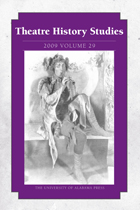 Theatre History Studies 2009, Vol. 29
Edited by Rhona Justice-Malloy, with contributions from Christin Essin, Carolyn D. Roark, Meredith Lowe, Valleri J. Hohman, Fonzie D. Geary II, Robert B. Shimko, Robert B. Theatre History Studies, Elizabeth Osborne, Paul Cornwell, Harry J. Elam Jr., etc.
University of Alabama Press, 2009 Reimagining the archive, one performance at a time. Theatre History Studies is a peer-reviewed journal dedicated to excellence in theatre historiography. Volume 29, edited by Rhona Justice-Malloy, includes essays that span a wide range of historical periods, geographic regions, and thematic concerns. Highlights include explorations of pain and torment in performance, the aesthetics of American modernity through Belasco and Jones, and the cultural politics of prohibition on stage. The volume also features visual and archival studies, including an interview with playwright Wendy Wasserstein and analyses of Shakespeare’s reception in Restoration theatre. With contributions from over thirty scholars, this edition offers a rich and multifaceted view of how theatre reflects, resists, and reshapes historical narratives.
Theatre History Studies 2010, Vol. 30
Edited by Rhona Justice-Malloy
University of Alabama Press, 2010 To mark the thirtieth anniversary of the Theatre History Studies journal, editor Rhona Justice-Malloy and the Mid-America Theatre Conference have collected a special-themed volume covering the past and present of African and African American theatre. Topics included range from modern theatrical trends and challenges in Zimbabwe and Kenya, and examining the history and long-range impact of Paul Robeson’s groundbreaking and troubled life and career, to gender issues in the work of Ghanaian playwright Efo Kodjo Mawugbe, and the ways that 19th-century American blackness was defined through Othello and Desdemona. This collection fills a vacancy in academic writing. Readers will enjoy it; academics can incorporate it into their curriculum; and students will find it helpful and illuminating.
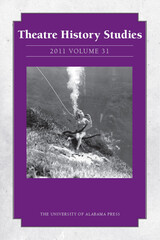 Theatre History Studies 2011, Vol. 31
Rhona Justice-Malloy
University of Alabama Press, 2011 "Theatre History Studies" is a peer-reviewed journal of theatre history and scholarship published annually since 1981 by the Mid-American Theatre Conference (MATC), a regional body devoted to theatre scholarship and practice. The conference encompasses the states of Illinois, Iowa, Nebraska, Kansas, Missouri, Minnesota, North Dakota, South Dakota, Wisconsin, Indiana, Michigan, and Ohio. The purpose of the conference is to unite persons and organizations within the region with an interest in theatre and to promote the growth and development of all forms of theatre. THS is a member of the Council of Editors of Learned Journals and is included in the MLA Directory of Periodicals. THS is indexed in Humanities Index, Humanities Abstracts, Book Review Index, MLA International Bibliography, International Bibliography of Theatre, Arts & Humanities Citation Index, IBZ International Bibliography of Periodical Literature, and IBR International Bibliography of Book Reviews. Full texts of essays appear in the databases of both Humanities Abstracts Full Text as well as SIRS From published reviews “This established annual is a major contribution to the scholarly analysis and historical documentation of international drama. Refereed, immaculately printed and illustrated . . . . The subject coverage ranges from the London season of 1883 to the influence of David Belasco on Eugene O’Neill.”—CHOICE “International in scope but with an emphasis on American, British, and Continental theater, this fine academic journal includes seven to nine scholarly articles dealing with everything from Filipino theater during the Japanese occupation to numerous articles on Shakespearean production to American children’s theater. . . . an excellent addition for academic, university, and large public libraries.”—Magazines for Libraries, 6th Edition
Theatre History Studies 2012, Vol. 32
Edited by Rhona Justice-Malloy
University of Alabama Press, 2012 Theatre History Studies, currently edited by Rhona Justice-Malloy, is a peer-reviewed journal of theatre history and scholarship published annually since 1981 by the Mid-American Theatre Conference (MATC), a regional body devoted to theatre scholarship and practice. The conference encompasses the states of Illinois, Iowa, Nebraska, Kansas, Missouri, Minnesota, North Dakota, South Dakota, Wisconsin, Indiana, Michigan, and Ohio. The purpose of the conference is to unite persons and organizations within the region with an interest in theatre and to promote the growth and development of all forms of theatre. Contributors
Penny Farfan / Victor Holtcamp / Lisa Jackson-Schebetta / Richard
L. Poole / Bill Rauch / Thomas Robson / Marlis Schweitzer / Virginia
Scott / Christine Woodworth
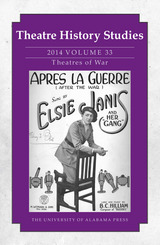 Theatre History Studies 2014, Vol. 33: Theatres of War
Elizabeth Reitz Mullenix
University of Alabama Press, 2014 Volume 33 of Theatre History Studies explores war. War is a paradox—horrifying and compelling, galvanizing and devastating, a phenomenon that separates and decimates while at the same time creating and strengthening national identity and community bonds. War is the stuff of great drama.
War and theatre is a subject of increasing popularity among scholars of theatre. The essays in this special edition of Theatre History Studies brings together a unique collection of work by thirteen innovative scholars whose work explores such topics as theatre performances during war times, theatre written and performed to resist war, and theatre that fosters and promotes war.
The contributors to this volume write poignantly about nationhood and about how war—through both propaganda and protest—defines a people. The contributors also delve into numerous fascinating themes that transcend time, peoples, nations, and particular conflicts: the foundations of nationalism and the concepts of occupied and occupier, nostalgia and utopia, and patriotism and revolution.
These essays survey a march of civil and international wars spanning three centuries. Arranged chronologically, they invite comparisons between themes and trace the development of the major themes of war. Ideas manifest in the theatre of one period recall ideologies and propaganda of the past, reflect those of the present, and anticipate wars to come.
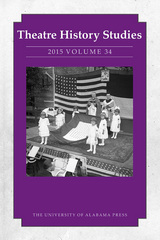 Theatre History Studies 2015, Vol. 34
Elizabeth Reitz Mullenix
University of Alabama Press, 2015 Volume 34 of Theatre History Studies revisits the foundations of theatre, explores the boundaries and definitions of theatre, and illuminates how writing about the history of theatre is itself a form of historiography.
The five essays are arranged chronologically, starting with Alan Sikes’s discussion of the Abydos Passion Play. Sikes challenges the long-held interpretation of that ritualized annual reenactment of the death, dismemberment, and return to life of Egyptian god-king Osiris as the world’s first recorded dramatic production. In analyzing the “Passion Play”—Sikes argues the term is not apt—he applies semiotic theory using "sign and referent" to revise general concepts of mimesis, and in so doing clarifies the fundamental answer to the question, “What is theatre?”
In a pair of essays, Andrew Gibb and Nicole Berkin both explore theatre during America’s antebellum period. Gibb examines minstrelsy in antebellum California, exploding narrow definitions of minstrelsy as a primarily Eastern phenomenon and one reflecting a stark interaction of two races. Following the story of Jewish African Caribbean immigrant William Alexander Leidesdorff, Gibb demonstrates that national forms are always affected by their local productions and audiences. Berkin’s essay focuses on the struggles over cultural power that took place between popular entertainers and theatre managers. She examines how both parties used touring strategically to engage with antebellum notions of deception and fraud.
The last two essays, by Megan Geigner and Heide Nees, present findings from performance studies which, by examining a wide array of dramatic and performative texts, expands the interdisciplinary foundations of theatre history studies. This fascinating collection is rounded out by an expanded selection of insightful reviews of recent literature in the area.
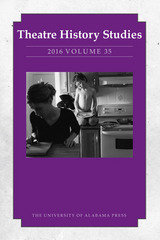 Theatre History Studies 2016, Vol. 35
Sara Freeman
University of Alabama Press, 2016 Essays in part one of Theatre History Studies, Vol. 35 address theatrical production in very specific historical contexts, among them German theatre “from the rubble of Berlin” and German nationalist mass spectacles. Essays in part two are devoted to the theme of “Rethinking the Maternal” in contemporary and historical theatre. Also included is the Robert A. Schanke Award-winning essay “Whispers from a Silent Past: Inspiration and Memory in Natasha Tretheway’s Native Guard,” a keynote essay by Irma Mayorga, and eighteen reviews of new book publications of note.
Theatre History Studies, published since 1981 by the Mid-American Theatre Conference (MATC) is a leading scholarly publication in the field of theatrical history and theory. The conference encompasses the states of Illinois, Iowa, Nebraska, Kansas, Missouri, Minnesota, North Dakota, South Dakota, Wisconsin, Indiana, Michigan, and Ohio. The purpose of the conference is to unite persons and organizations within the region with an interest in theatre and to promote the growth and development of all forms of theatre.
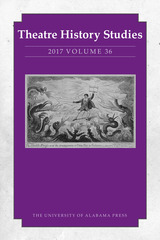 Theatre History Studies 2017, Vol. 36
Edited by Sara Freeman
University of Alabama Press, 2017 A peer-reviewed journal of theatre history and scholarship published annually since 1981 by the Mid-American Theatre Conference.
Theatre History Studies is devoted to research in all areas of theatre studies, with special interest in archival research, historical documentation, and historiography. Many issues feature a special section curated around a special theme or topic; for 2017 that special section focus on histories of new writing for the theatre.
Featured in THEATRE HISTORY STUDIES 2017, VOLUME 36 - “Resisting Arlecchino’s Mask: The Case of Marcello Moretti” by Gabrielle Houle
- “Making Space for Performance: Theatrical-Architectural Nationalism in Postindependence Ghana” by David Afriyie Donkor
- “Preparing Boys for War: J. M. Barrie’s Peter Pan Enlists in World War I’s ‘Great Adventure’” by Laura Ferdinand Feldmeyer
- “Not Just Rock ‘n’ Roll: Chicago Theatre, 1984–1990” by Julie Jackson
- “New Writing and Theatre History” by Sara Freeman
- “New Plays in New Tongues: Bilingualism and Immigration at the New Italian Theatre in France” by Matthew McMahan
- “The Waterloo Summer of the Prince of Wales’s Theatre: New Writing, Old Friends, and Early Realism in the Victorian Theatre” by Shannon Epplett
- “Chekhov’s Three Sisters: A Proto-Poststructuralist Experiment” by Sarah Wyman
- “Historicizing Shakesfear and Translating Shakespeare Anew” by Lezlie C. Cross
- “A New Noble Kinsmen: The Play On! Project and Making New Plays Out of Old” by Martine Kei Green-Rogers and Alex N. Vermillion
- “Making New Theatre Together: The First Writers’ Group at the Royal Court Theatre and Its Legacy Within the Young Writers’ Programme” by Nicholas Holden
- “New Writing in a Populist Context: A Play,a Pie, and a Pint” by Deana Nichols
- “American Playwriting and the Now New” by Todd London
- The Robert A. Schanke Award-Winning Essay: “Black Folk’s Theatre to Black Lives Matter: The Black Revolution on Campus” by La Donna L. Forsgren
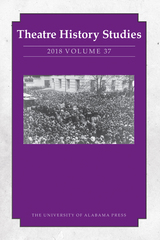 Theatre History Studies 2018, Vol. 37
Sara Freeman
University of Alabama Press, 2018 Theatre History Studies (THS) is a peer-reviewed journal of theatre history and scholarship published annually since 1981 by the Mid-America Theatre Conference
THEATRE HISTORY STUDIES, VOLUME 37
STEFAN AQUILINA
Meyerhold and The Revolution: A Reading through Henri Lefebvre’s Theories on “Everyday Life”
VIVIAN APPLER
“Shuffled Together under the Name of a Farce”: Finding Nature in Aphra Behn’s The Emperor of the Moon
KRISTI GOOD
Kate Soffel’s Life of Crime: A Gendered Journey from Warden’s Wife to Criminal Actress
PETER A. CAMPBELL
Staging Ajax’s Suicide: A Historiography
BRIAN E. G. COOK
Rousing Experiences: Theatre, Politics, and Change
MEGAN LEWIS
Until You See the Whites of Their Eyes: Brett Bailey’s Exhibit B and the Consequences of Staging the Colonial Gaze
PATRICIA GABORIK
Taking the Theatre to the People: Performance Sponsorship and Regulation in Mussolini’s Italy
ILINCA TODORUT AND ANTHONY SORGE
To Image and to Imagine: Walid Raad, Rabih Mouré, and the Arab Spring
SHULAMITH LEV-ALADGEM
Where Has the Political Theatre in Israel Gone? Rethinking the Concept of Political Theatre Today
CHRISTINE WOODWORTH
“Equal Rights By All Means!”: Beatrice Forbes-Robertson’s 1910 Suffrage Matinee and the Onstage Junction of the US And UK Franchise Movements
LURANA DONNELS O’MALLEY
“Why I Wrote the Phyllis Wheatley Pageant-Play”: Mary Church Terrell’s Bicentennial Activism
JULIET GUZZETTA
The Lasting Theatre of Dario Fo and Franca Rame
ASHLEY E. LUCAS
Chavez Ravine: Culture Clash and the Political Project of Rewriting History
NOE MONTEZ
The Heavy Lifting: Resisting the Obama Presidency’s Neoliberalist Conceptions of the American Dream in Kristoffer Diaz’s The Elaborate Entrance of Chad Deity
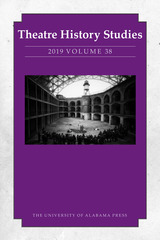 Theatre History Studies 2019, Vol. 38
Edited by Sara Freeman
University of Alabama Press, 2019 Theatre History Studies (THS) is a peer-reviewed journal of theatre history and scholarship published annually since 1981 by the Mid-America Theatre Conference
THEATRE HISTORY STUDIES, VOLUME 38
PART I: Studies in Theatre History
ELIZABETH COEN
Hanswurst’s Public: Defending the Comic in the Theatres of Eighteenth-Century Vienna
BRIDGET MCFARLAND
“This Affair of a Theatre”: The Boston Theatre Controversy and the Americanization of the Stage
RYAN TVEDT
From Moscow to Simferopol: How the Russian Cubo-Futurists Accessed the Provinces
DANIELLA VINITSKI MOONEY
So Long Ago I Can’t Remember: GAle GAtes et al. and the 1990s Immersive Theatre
Part II: The Site-Based Theatre Audience Experience: Dramaturgy and Ethics
—EDITED BY PENELOPE COLE AND RAND HARMON
PENELOPE COLE
Site-Based Theatre: The Beginning
PENELOPE COLE
Becoming the Mob: Mike Brookes and Mike Pearson’s Coriolan/us
SEAN BARTLEY
A Walk in the Park: David Levine’s Private Moment and Ethical Participation in Site-Based Performance
DAVID BISAHA
“I Want You to Feel Uncomfortable”: Adapting Participation in A 24-Decade History of Popular Music at San Francisco’s Curran Theatre
COLLEEN RUA
Navigating Neverland and Wonderland: Audience as Spect-Character
GUILLERMO AVILES-RODRIGUEZ, PENELOPE COLE, RAND HARMON, AND ERIN B. MEE
Ethics and Site-Based Theatre: A Curated Discussion
PART III: The Robert A. Schanke Award-Winning Essay from the 1038 Mid-America Theatre Conference
MICHELLE GRANSHAW
Inventing the Tramp: The Early Tramp Comic on the Variety Stage
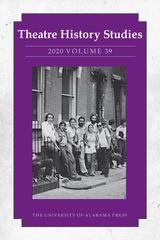 Theatre History Studies 2020, Vol. 39
Edited by Lisa Jackson-Schebetta
University of Alabama Press, 2020 Theatre History Studies (THS) is a peer-reviewed journal of theatre history and scholarship published annually since 1981 by the Mid-America Theatre Conference Reframing the past to illuminate the future of performance. Theatre History Studies is a peer-reviewed journal devoted to excellence in theatre historiography. Volume 38, edited by Lisa Jackson-Schebetta, features three distinct sections: foundational studies in theatre history, a special section on hemispheric historiographies, and award-winning essays from the Mid-America Theatre Conference. Contributors examine topics ranging from Shakespeare and racial antagonism to systemic dramaturgy, labor unions in regional theatre, and digital diasporic activism. The volume also includes visual histories and decolonial methodologies that challenge Eurocentric narratives and foreground Latinx, feminist, and socialist performance traditions. With 272 pages and 18 black-and-white figures, this edition is a rich resource for scholars seeking to expand the scope and methods of theatre history.
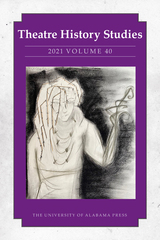 Theatre History Studies 2021, Vol 40
Edited by Lisa Jackson-Schebetta
University of Alabama Press, 2021 A peer-reviewed journal of theatre history and scholarship published annually since 1981 by the Mid-America Theatre Conference
Introduction
—LISA JACKSON-SCHEBETTA, WITH ODAI JOHNSON, CHRYSTYNA DAIL, AND JONATHAN SHANDELL
PART I
STUDIES IN THEATRE HISTORY
Un-Reading Voltaire: The Ghost in the Cupboard of the House of Reason
—ODAI JOHNSON
Caricatured, Marginalized,
and Erased: African American Artists and Philadelphia’s Negro Unit of the FTP, 1936–1939
—JONATHAN SHANDELL
Stop Your Sobbing: White Fragility, Slippery Empathy, and Historical Consciousness in Branden Jacobs-Jenkins’s Appropriate
—SCOTT PROUDFIT
Asia and Alwin Nikolais: Interdisciplinarity, Orientalist Tendencies, and Midcentury American Dance
—ANGELA K. AHLGREN
PART II
WITCH CHARACTERS AND WITCHY PERFORMANCE
Editor’s Introduction to the Special Section
Shifting Shapes: Witch Characters and Witchy Performances
—CHRYSTYNA DAIL
To Wright the Witch: The Case of Joanna Baillie’s Witchcraft
—JANE BARNETTE
Nothing Wicked This Way Comes: Shakespeare’s Subversion of Archetypal Witches in The Winter’s Tale
—JESSICA HOLT
Of Women and Witches: Performing the Female Body in Caryl Churchill’s Vinegar Tom
—MAMATA SENGUPTA
(Un)Limited: The Influence of Mentorship and Father-Daughter Relationships on Elphaba’s Heroine Journey in Wicked
—REBECCA K. HAMMONDS
Immersive Witches: New York City under the Spell of Sleep No More and Then She Fell
—DAVID BISAHA
PART III
Essay from the Conference
The Robert A. Schanke Award-Winning Essay, MATC 2020
New Conventions for a New Generation: High School Musicals and Broadway in the 2010s
—LINDSEY MANTOAN
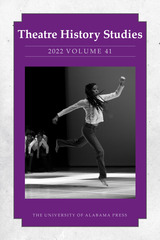 Theatre History Studies 2022, Vol 41
edited by Lisa Jackson-Schebetta
University of Alabama Press, 2023 Volume 41 of the official journal of the Mid-America Theatre Conference
Theatre History Studies is the official journal of the Mid-America Theatre Conference, Inc. (MATC). The conference is dedicated to the growth and improvement of all forms of theatre throughout a twelve-state region that includes the states of Illinois, Iowa, Nebraska, Kansas, Missouri, Minnesota, North Dakota, South Dakota, and Wisconsin. Its purposes are to unite people and organizations within this region and elsewhere who have an interest in theatre and to promote the growth and development of all forms of theatre.
Published annually since 1981, Theatre History Studies provides critical, analytical, and descriptive essays on all aspects of theatre history and is devoted to disseminating the highest quality peer-review scholarship in the field.
CONTRIBUTORS
Angela K. Ahlgren / Samer Al-Saber / Kelly I. Aliano / Gordon Alley-Young / Melissa Blanco Borelli / Trevor Boffone / Jay Buchanan / Matthieu Chapman / Joanna Dee Das / Ryan J. Douglas / Victoria Fortuna / Christiana Molldrem Harkulich / Alani Hicks-Bartlett / Jeanmarie Higgins / Lisa Jackson-Schebetta / Erin Rachel Kaplan / Heather Kelley / Patrick Maley / Karin Maresh / Lisa Milner / Courtney Elkin Mohler / Heather S. Nathans / Heidi L. Nees / Sebastian Samur / Michael Schweikardt / Teresa Simone / Dennis Sloan / Guilia Taddeo / Kyle A. Thomas / Alex Vermillion / Bethany Wood
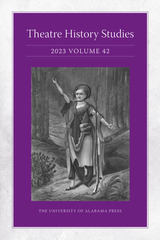 Theatre History Studies 2023, Vol. 42
edited by Lisa Jackson-Schebetta
University of Alabama Press, 2024 The official journal of the Mid-America Theatre Conference Theatre History Studies (THS) is a peer-reviewed journal of theatre history and scholarship published annually since 1981 by the Mid-America Theatre Conference (MATC), a regional body devoted to theatre scholarship and practice. The conference encompasses the states of Illinois, Iowa, Nebraska, Kansas, Missouri, Minnesota, North Dakota, South Dakota, Wisconsin, Indiana, Michigan, and Ohio. The purpose of the conference is to unite persons and organizations within the region with an interest in theatre and to promote the growth and development of all forms of theatre. THS is a member of the Council of Editors of Learned Journals and is included in the MLA Directory of Periodicals. THS is indexed in Humanities Index, Humanities Abstracts, Book Review Index, MLA International Bibliography, International Bibliography of Theatre, Arts & Humanities Citation Index, IBZ International Bibliography of Periodical Literature, and IBR International Bibliography of Book Reviews. Full texts of essays appear in the databases of both Humanities Abstracts Full Text and SIRS. Along with book reviews on the latest publications from established and emerging voices in the field, this issue of Theatre History Studies contains three sections with fourteen essays total. In the general section, three essays offer an array of insights, methods, and provocations. In the special section on care, contributors capture their experience as scholars, humans, and citizens in 2022. In Part III, the 2022 Robert A. Schanke Research Award-winning paper by Heidi L. Nees asks historians to rethink Western constructions of time. Taken together, volume 42 captures how this journal serves theatre historians as scholars and laborers as they work to attend and tend to their field. CONTRIBUTORS
Cheryl Black / Shelby Brewster / Matthieu Chapman / Meredith Conti / Zach Dailey / Michael DeWhatley / Whit Emerson / Katherine Gillen / Miles P. Grier / Patricia Herrera / Lisa Jackson-Schebetta / Nancy Jones / Joshua Kelly / Felicia Hardison Londré / Bret McCandless / Marci R. McMahon/ Tom Mitchell / Sherrice Mojgani / John Murillo III / Heidi L. Nees / Jessica N. Pabón-Colón / Kara Raphaeli / Leticia L. Ridley / Cynthia Running-Johnson / Alexandra Swanson / Catherine Peckinpaugh Vrtis / Shane Wood / Christine Woodworth / Robert O. Yates
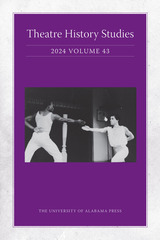 Theatre History Studies 2024, Vol 43
Edited by Jocelyn L. Buckner
University of Alabama Press, 2025 The official journal of the Mid-America Theatre Conference Where past and performance converge—scholarship that moves the stage forward. Theatre History Studies (THS) is a peer-reviewed journal of theatre history and scholarship published annually since 1981 by the Mid-America Theatre Conference (MATC), a regional body devoted to theatre scholarship and practice. The conference encompasses the states of Illinois, Iowa, Nebraska, Kansas, Missouri, Minnesota, North Dakota, South Dakota, Wisconsin, Indiana, Michigan, and Ohio. The purpose of the conference is to unite persons and organizations within the region with an interest in theatre and to promote the growth and development of all forms of theatre. THS is a member of the Council of Editors of Learned Journals and is included in the MLA Directory of Periodicals. THS is indexed in Humanities Index, Humanities Abstracts, Book Review Index, MLA International Bibliography, International Bibliography of Theatre, Arts & Humanities Citation Index, IBZ International Bibliography of Periodical Literature, and IBR International Bibliography of Book Reviews. Full texts of essays appear in the databases of both Humanities Abstracts Full Text as well as SIRS. Along with books reviews on the latest publications from established and emerging voices in the field, this issue of Theatre History Studies contains four sections with two introductions, nine essays, and eleven book reviews total. In the general section, three essays offer an array of insights, methods, and provocations. In the special section titled “Manifestos for Black Theatre, Then and Now,” contributors capture their moment, their ways of working, and their experience as scholars, humans, and citizens in 2023. In part III, Ariel Nereson’s Robert A. Schanke Research Award-winning paper from the 2023 MATC conference examines collective dance histories through the Bill T. Jones/Arnie Zane Dance Company’s Continuous Replay. Taken together, volume 43 captures how this journal serves theatre historians as scholars and laborers as they work to attend and tend to their field.
CONTRIBUTORS Daniel E. Atkinson / Ashlyn K. Barnett / David Bisaha / Jocelyn L. Buckner / Julie Burrell / Jordana Cox / Jordan Ealey / Eric M. Glover / Adam Goldstein / Chao Guo / Amy B. Huang / Ariel Nereson / Zachary F. Price / Danielle Rosvally / Letica L. Ridley / Bradford G. Sadler / Richard Sautter / Michael Schweikardt / Margo Skornia / Dennis Sloan / Josh Stenberg / Paul Michael Thomson / Scott Venters / Isaiah Matthew Wooden
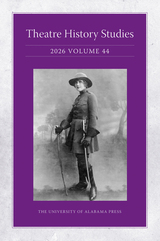 Theatre History Studies 2026, Vol 44
Edited by Jocelyn L. Buckner
University of Alabama Press, 2026 The official journal of the Mid-America Theatre Conference Theatre History Studies (THS) is a peer-reviewed journal of theatre history and scholarship published annually since 1981 by the Mid-American Theatre Conference (MATC), a regional body devoted to theatre scholarship and practice. The conference is dedicated to the growth and improvement of all forms of theatre throughout a twelve-state region encompassing Illinois, Indiana, Iowa, Kansas, Michigan, Minnesota, Missouri, Nebraska, North Dakota, Ohio, South Dakota, and Wisconsin. The purposes of the conference are to unite people and organizations within the region and elsewhere who have an interest in theatre and to promote the growth and development of all forms of theatre. THS is a member of the Council of Editors of Learned Journals and is included in the MLA Directory of Periodicals. THS is cataloged in numerous periodical indexes and databases. Along with sixteen book reviews on the latest publications from established and emerging voices in the field, this issue of Theatre History Studies contains four sections with two introductions and nine essays total. In the general section, three essays consider performance histories and reevaluations of historiographical approaches. The special section on queer historiographies responds to calls for a more expansive and inclusive understanding of trans histories and for centralizing contemporary queer performers. In part III, the Robert A. Schanke Research Award-winning paper from the 2024 MATC conference by Ali-Reza Mirsajadi addresses erasures in the theatrical archive and highlights the long legacy of queer, Southwest Asian, and North African representation in dramatic texts. Taken together, volume 44 captures how this journal serves theatre historians as scholars and laborers as they work to attend and tend to their field.
Theatre in Passing 2: Searching for New Amsterdam
(E)lena K. Siemens
Intellect Books, 2015 This book discusses spaces of performance from formal opera houses to parks and graffiti around the world and is a companion to Theatre in Passing: A Moscow Photo-Diary. Drawing once again on Michel de Certeau’s notion of a “second poetic geography,” this new volume examines prominent theatrical destinations —New York, London, and Paris—along with others that are often overlooked, including Canada, Mexico, and Turkey. In addition to indoor theaters, the book covers a variety of outdoor theatrical spaces, as well as street theater. Like its predecessor, Theatre in Passing 2 is richly illustrated with photographs by the author and provides fascinating insights on the intersection of performing arts, visual culture, and photography.
Theatre in Passing: A Moscow Photo-Diary
(E)lena K. Siemens
Intellect Books, 2011 Theatre in Passing explores spaces of performance in contemporary Moscow. Inspired by French philosopher Michel de Certeau’s model of a "second, poetic geography" in which the walker—the everyday practitioner—invents the space observed by the voyeur, this book takes the reader on a tour of spaces of performance in contemporary Moscow. Through text and photography, the city’s "theatrical geography" is uncovered, from the Bolshoi Theater in Theater Square to hidden gems like the recently restored Kuskovo estate. With additional sections on street theater and other public gatherings, Theatre in Passing is a must-read book for anyone curious about the theatrical architecture and geography of Russia’s capital.
Theatre in Prison: Theory and Practice
Edited by Michael Balfour
Intellect Books, 1995 From role-plays with street gangs in the USA to Beckett in Brixton; from opera productions with sex offenders to psychodrama with psychopaths, the book will discuss, analyse and reflect on theoretical notions and practical applications of theatre for and with the incarcerated.
Theatre in Prison is a collection of thirteen international essays exploring the rich diversity of innovative drama works in prisons. The book includes an introduction that will present a contextualisation of the prison theatre field. Thereafter, leading practitioners and academics will explore key aspects of practice &endash; problemitising, theorising and describing specific approaches to working with offenders. The book also includes extracts from prison plays, poetry and prisoners writings that offer illustrations and insights into the experience of prison life.
Theatre in Southeast Asia
James R. Brandon
Harvard University Press, 1967 An astonishing variety of theatrical performances may be seen in the eight countries of Southeast Asia—Burma, Cambodia, Indonesia, Laos, Malaysia, the Philippines, Thailand, and Vietnam. James Brandon spent more than three years observing and interviewing troupe members in these countries. He describes twenty-five of the most important theatrical forms, grouping them according to their origins as folk, court, popular, or Western theatre. He considers the theatre from four perspectives: its origins, its art, its role as a social institution, and its function as a medium of communication and propaganda. Brandon’s wide-ranging and lively discussion points out interesting similarities and differences among the countries, and many of his superb photographs are included here.
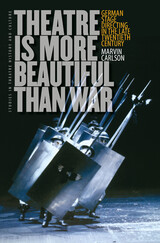 Theatre Is More Beautiful Than War: German Stage Directing in the Late Twentieth Century
Carlson, Marvin
University of Iowa Press, 2009 In almost every area of production, German theatre of the past forty years has achieved a level of distinction unique in the international community. This flourishing theatrical culture has encouraged a large number of outstanding actors, directors, and designers as well as video and film artists. The dominant figure throughout these years, however, has remained the director. In this stimulating and informative book, noted theatre historian Marvin Carlson presents an in-depth study of the artistic careers, working methods, and most important productions of ten of the leading directors of this great period of German staging. Beginning with the leaders of the new generation that emerged in the turbulent late 1960s—Peter Stein, Peter Zadek, and Claus Peymann, all still major figures today—Carlson continues with the generation that appeared in the 1980s, particularly after reunification—Frank Castorf, Anna Viebrock, Andrea Breth, and Christoph Marthaler—and concludes with the leading directors to emerge after the turn of the century, Stefan Pucher, Thomas Ostermeier, and Michael Thalheimer. He also provides information not readily available elsewhere in English on many of the leading actors and dramatists as well as the designers whose work, much of it for productions of these directors, has made this last half century a golden age of German scenic design. During the late twentieth century, no country produced so many major theatre directors or placed them so high in national cultural esteem as Germany. Drawing on his years of regular visits to the Theatertreffen in Berlin and other German productions, Carlson will captivate students of theatre and modern German history and culture with his provocative, well-illustrated study of the most productive and innovative theatre tradition in Europe.
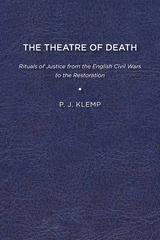 The Theatre of Death: Rituals of Justice from the English Civil Wars to the Restoration
P J Klemp
University of Delaware Press, 2017 This book discusses some rituals of justice—such as public executions, printed responses to the Archbishop of Canterbury’s execution speech, and King Charles I’s treason trial—in early modern England. Focusing on the ways in which genres shape these events’ multiple voices, I analyze the rituals’ genres and the diverse perspectives from which we must understand them. The execution ritual, like such cultural forms as plays and films, is a collaborative production that can be understood only, and only incompletely, by being alert to the presence of its many participants and their contributions. Each of these participants brings a voice to the execution ritual, whether it is the judge and jury or the victim, executioner, sheriff and other authorities, spiritual counselors, printer, or spectators and readers. And each has at least one role to play. No matter how powerful some institutions and individuals may appear, none has a monopoly over authority and how the events take shape on and beyond the scaffold. The centerpiece of the mid-seventeenth-century’s theatre of death was the condemned man’s last dying utterance. This study focuses on the words and contexts of many of those final speeches, including King Charles I’s (1649), Archbishop William Laud’s (1645), and the Earl of Strafford’s (1641), as well as those of less well known royalists and regicides. Where we situate ourselves to view, hear, and comprehend a public execution—through specific participants’ eyes, ears, and minds or accounts—shapes our interpretation of the ritual. It is impossible to achieve a singular, carefully indoctrinated meaning of an event as complex as a state-sponsored public execution. Along with the variety of voices and meanings, the nature and purpose of the rituals of justice maintain a significant amount of consistency in a number of eras and cultural contexts. Whether the focus is on the trial and execution of the Marian martyrs, English royalists in the 1640s and 1650s, or the Restoration’s regicides, the events draw on a set of cultural expectations or conventions. Because rituals of justice are shaped by diverse voices and agendas, with the participants’ scripts and counterscripts converging and colliding, they are dramatic moments conveying profound meanings.
Published by University of Delaware Press. Distributed worldwide by Rutgers University Press.
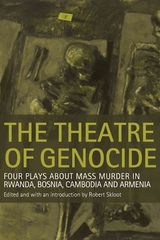 The Theatre of Genocide: Four Plays about Mass Murder in Rwanda, Bosnia, Cambodia, and Armenia
Edited and with an introduction by Robert Skloot
University of Wisconsin Press, 2008 In this pioneering volume, Robert Skloot brings together four plays—three of which are published here for the first time—that fearlessly explore the face of modern genocide. The scripts deal with the destruction of four targeted populations: Armenians in Lorne Shirinian’s Exile in the Cradle, Cambodians in Catherine Filloux’s Silence of God, Bosnian Muslims in Kitty Felde’s A Patch of Earth, and Rwandan Tutsis in Erik Ehn’s Maria Kizito. Taken together, these four plays erase the boundaries of theatrical realism to present stories that probe the actions of the perpetrators and the suffering of their victims. A major artistic contribution to the study of the history and effects of genocide, this collection carries on the important journey toward understanding the terror and trauma to which the modern world has so often been witness.
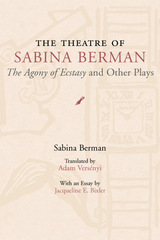 The Theatre of Sabina Berman: The Agony of Ecstasy and Other Plays
Sabina Berman. Translated by Adam Versenyi. Essay by Jacqueline E. Bixler
Southern Illinois University Press, 2003 The Theatre of Sabina Berman: The Agony of Ecstasy and Other Plays introduces and makes accessible to an English-speaking audience the work of the contemporary Mexican playwright Sabina Berman. The book contains translations of the four plays that established Berman’s career: The Agony of Ecstasy, Yankee, Puzzle, and Heresy. An introduction by Adam Versényi provides a critical assessment of each play, a discussion of the specific problems of translation involved, and placement of Berman’s work in the larger Mexican and Latin American context. It is evident that Sabina Berman’s theatrical acumen matches the depth of her dramatic design whether it is the sheer variety of techniques from song to staged tableau that appear in The Agony of Ecstasy; the physicalization of what it means to be interrogated and to interrogate in Yankee; the final enigmatic image of a soldier alone on stage, silently aiming his firearm at an undefined threat that potentially emanates from the audience in Puzzle; or the manner in which the family narrates its own “heretical” actions in Heresy. It is the combination of theatrical technique with universal themes of self-definition that cuts across cultures and ultimately makes these plays translatable.
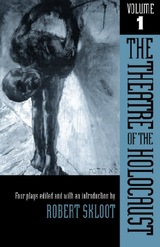 The Theatre of the Holocaust, Volume 1: Four Plays
Edited and with and introduction by Robert Skloot
University of Wisconsin Press, 1982 This volume contains these four plays:
Resort 76 by Shimon Wincelberg
Will the relentless oppression of the starving workers in a ghetto factory destroy their faith in God? Their love of life? Their ability to resist? If a cat is more valuable than a human being, have hope and goodness been eliminated from the world? A moving and terrifying melodrama.
Throne of Straw by Harold and Edith Lieberman
Through the career of Mordechai Chaim Rumkowski, head of the Lodz, Poland Judenrat, we come to understand the horror of “choiceless choice,” of how giving up some to save others was the worst nightmare for those who sought the responsibilities of ghetto leadership. An epic play with music and song.
The Cannibals by George Tabori
The children of murder victims assemble to enact ritually the destruction of their fathers in the presence of two survivors. As the sons become their fathers, the most profound ethical questions of the Holocaust are raised concerning the limits of humanity in a world of absolute evil. A daring tragicomedy.
Who Will Carry the Word? by Charlotte Delbo (translated by Cynthia Haft)
In the austere, degraded setting of a concentration camp, twenty-two French women attempt to keep their sanity and hope as, one by one, they fall victim to the Nazi terror. Will anyone believe the story of the survivors? A poetic drama of resistance and witness.
The Theatre of the Holocaust, Volume 2: Six Plays
Edited and with and introduction by Robert Skloot
University of Wisconsin Press, 1999 This second volume of The Theatre of the Holocaust, when combined with the first, represents the most significant and comprehensive international collection of plays on the Holocaust. Since the appearance of Volume 1 in 1982, theatre and Holocaust studies have undergone astonishing transformations. In Volume 2, Skloot presents six plays acknowleding the most recent theatrical forms in our post-modern age.
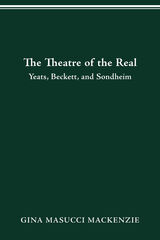 Theatre of the Real: Yeats, Beckett, and Sondheim
Gina Masucci MacKenzie
Ohio State University Press, 2008 The Theatre of the Real: Yeats, Beckett, and Sondheim traces the thread of jouissance (the simultaneous experience of radical pleasure and pain) through three major theatre figures of the twentieth century. Gina Masucci MacKenzie’s work engages theatrical text and performance in dialogue with the Lacanian Real, so as to re-envision modern theatre as the cultural site where author, actor, and audience come into direct contact with personal and collective traumas. By showing how a transgressively free subject may be formed through theatrical experience, MacKenzie concludes that modern theatre can liberate the individual from the socially constructed self. The Theatre of the Real revises views of modern theatre by demonstrating how it can lead to a collaborative effort required for innovative theatrical work. By foregrounding Yeats’s “dancer” plays, the author shows how these intimate pieces contribute to the historical development of musical as well as modern theatre. Beckett’s universal dramas then pave the way for Sondheim’s postmodern cacophonies of idea and spirit as they introduce comic abjection into modernism’s tragic mode. This exciting work from a new author will leave readers with fresh insight to theatrical performance and its necessity in our lives.
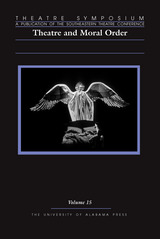 Theatre Symposium, Vol. 15: Theatre and Moral Order
M. Scott Phillips
University of Alabama Press, 2007 The essays gathered together in Volume 15 of the annual journal Theatre Symposium investigate how, historically, the theatre has been perceived both as a source of moral anxiety and as an instrument of moral and social reform. Essays consider, among other subjects, ethnographic depictions of the savage “other” in Buffalo Bill’s engagement at the Columbian Exposition of 1893; the so-called “Moral Reform Melodrama” in the nineteenth century; charity theatricals and the ways they negotiated standards of middle-class respectability; the figure of the courtesan as a barometer of late nineteenth and early twentieth-century moral and sexual discourse; Aphra Behn’s subversion of Restoration patriarchal sexual norms in The Feigned Courtesans; and the controversy surrounding one production of Tony Kushner Angels in America, during which officials at one of the nation’s more prominent liberal arts colleges attempted to censor the production, a chilling reminder that academic and artistic freedom cannot be taken for granted in today’s polarized moral and political atmosphere.
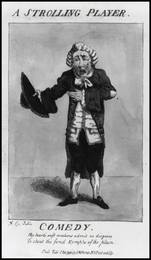 Theatre Symposium, Vol. 16: Comedy Tonight!
Jay Malarcher
University of Alabama Press, 2008 For centuries scholars, philosophers, and practitioners have attempted to explain just what constitutes comedy, and though no one has come close to a definitive explanation, each attempt highlights some distinct facet of the genre—the genre that Woody Allen has said eats at the children's table . . . even in the world of scholarship.
The essays gathered in Volume 16 of the annual journal Theatre Symposium illustrate well the range of material that falls under the heading "comedy" as it is played on stage.
Stanley Longman's essay on "The Commedia dell'Arte as the Quintessence of Comedy" introduces us to the inhabitants of "Commediatown," character types who are descendents of the Greeks and ancestors, it seems, of almost everyone who came after. Boris Senker, an eyewitness to Croatia's evolution from communism to democracy, reports on the all-too-real "Commedia" stereotypes that have found their way onto the stage in his homeland.
Other essays address the improvisational nature of "Commedia"; the roots of laughter and the expectations inherent in presenting "old schtick" to a new generation; comedic technique, verbal and physical, in Molière; the use of the macabre to create humor in the "Théâtre du Grand Guignol"; the story of Henry Fielding, the theatre practitioner most responsible for the British government's crackdown on subversive material, via the Licensing Act of 1737; Beckett's theatrical connections to the comedy theory of Henri Bergson; and do-it-yourself (DIY) comedy—happenings, situations, gatherings—as practiced in British stand-up comedy.
Volume 16 provides just a glimpse into the possibilities for comedy on the stage. If the past examples allow for extrapolation into the future, the position of comedy as a means of communicating problems and solutions for society's woes is remarkably sound.
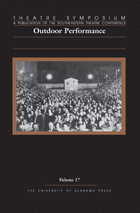 Theatre Symposium, Vol. 17: Outdoor Performance
Edited by Jay Malarcher
University of Alabama Press, 2009 Outdoor drama takes many forms: ancient Greek theatre, open-air performances of Shakespeare at summer festivals, and re-enactments of landmark historical events. The essays gathered in "Outdoor Performance," Volume 17 of the annual journal Theatre Symposium, address outdoor theatre's many manifestations, including the historical and non-traditional.
Among other subjects, these essays explore the rise of "airdomes" as performance spaces in the American Midwest in the first half of the 20th century; the civic-religious pageants staged by certain Mormon congregations; Wheels-A-Rolling, and other railroad themed pageants; first-hand accounts of the innovative Hunter Hills theatre program in Tennessee; the role of traditional outdoor historical drama, particularly the long-running performances of Paul Green's The Lost Colony; and the rise of the part dance, part sport, part performance phenomenon "parkour"-- the improvised traversal of obstacles found in both urban and rural landscapes.
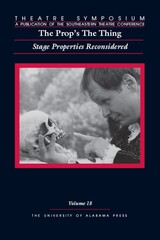 Theatre Symposium, Vol. 18: The Prop's The Thing: Stage Properties Reconsidered
Edited by J. K. Curry
University of Alabama Press, 2010 Stage properties are an often-ignored aspect of theatrical productions, in part because their usage is meant to be seamlessly integrated into the performance instead of a focal point for the audience. However, a skillfully used prop can augment the action, just as a malfunctioning prop can destroy the illusion of the scene. The essays in “Theatre Symposium: Volume 18” approach the subject of stage props from many angles, and include examinations of props in contemporary and historical productions, explorations of the cultural significance of specific props, and arguments about the nature of the prop itself. The contributors illuminate many aspects of this largely ignored yet crucial part of the theatre. Kyna Hamill looks at props as a means to mark social status. Christine Woodworth addresses the challenges presented by using blood onstage, while Andrew Sofer discusses the use of prop corpses on the Shakespearean stage. Andrew Kimbrough moves from an examination of actors’ use of props to a consideration of audience response to performance. Other essays investigate specific objects or productions, and introduce provocative and original perspectives to the growing discussion about stage properties.
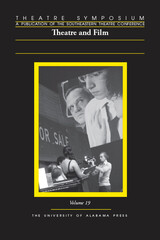 Theatre Symposium, Vol. 19: Theatre and Film
J K Curry
University of Alabama Press, 2011 Normal0falsefalsefalseMicrosoftInternetExplorer4Despite a shared history and many common present practices, the relationship between theatre and film often remains uncertain. Does a close study of film enrich an understanding of drama on the stage? What ongoing connections do theatre and film maintain, and what elements do they borrow from each other? Does the relative popularity and accessibility of film lead to an increased scholarly defensiveness about qualities exclusive to theatrical performances? Do theatre and film demand two different kinds of attention from spectators, or do audiences tend to experience both in the same ways? The essays in “Theatre Symposium: Volume 19” present this dynamic coexistence of theatre and film, and examine the nature of their mutual influence on each other.Bruce McConachie, in his contribution to the collection, “Theatre and Film in Evolutionary Perspective,” argues that the cognitive functions used to interpret either media arise from the same evolutionary foundation, and that therefore the viewing experiences of theatre and film are closely linked to each other. In “Robert Edmond Jones: Theatre and Motion Pictures, Bridging Reality and Dreams,” Anthony Hostetter and Elisabeth Hostetter consider Jones’ influential vision of a “theater of the future,” in which traditional stage performances incorporate mediated video material into stage productions. Becky Becker’s “Nollywood: Film and Home Video, of the Death of Nigerian Theatre,” by focusing on the current conversation in Nigeria, discusses the anxiety generated by a film and video industry burgeoning into and displacing theatre culture These and the six other essays in “Theatre Symposium: Volume 19” shed light on the current state of affairs—the collaborations and the tensions—between two distinctly individual yet inextricably related artistic media.
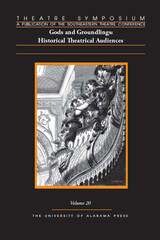 Theatre Symposium, Vol. 20: Gods and Groundlings: Historical Theatrical Audiences
Edward Bert Wallace
University of Alabama Press, 2012 The audience is an integral part of performance and is in fact what separates a rehearsal from a performance. The relationship, however, between performers and the audience has evolved over time, which is one of the subjects addressed, along with the changing disposition of the audience itself and a number of other topics, in Gods and Groundlings, volume 20 of the annual journal Theatre Symposium. The essays in this volume discuss spectatorship in historical context, the role of the audience in the digital age, the early modern English
transvestite theatre, Annie Oakley and the disruption of Victorian audiences, and historical attempts to create ideal audiences. Edited by E. Bert Wallace, this latest publication from the largest regional theatre organization in the United States collects the most current scholarship on theatre history and theory. Contributors To Volume 20
Susan Bennett / Jane Barnette / Becky Becker / Lisa Bernd / Evan
Bridenstine / Michael Jaros / Robert I. Lublin / Paulette Marty
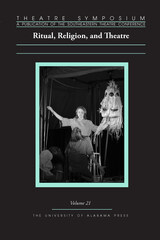 Theatre Symposium, Vol. 21: Ritual, Religion, and Theatre
Edited by E. Bert Wallace
University of Alabama Press, 2013 Volume 21 of Theatre Symposium presents essays that explore the intricate and vital relationships between theatre, religion, and ritual.
Whether or not theatre arose from ritual and/or religion, from prehistory to the present there have been clear and vital connections among the three. Ritual, Religion, and Theatre, volume 21 of the annual journal Theatre Symposium, presents a series of essays that explore the intricate and vital relationships that exist, historically and today, between these various modes of expression and performance.
The essays in this volume discuss the stage presence of the spiritual meme; ritual performance and spirituality in The Living Theatre; theatricality, themes, and theology in James Weldon Johnson’s God’s Trombones; Jordan Harrison’s Act a Lady and the ritual of queerness; Gerpla and national identity in Iceland; confession in Hamlet and Measure for Measure; Christian liturgical drama; Muslim theatre and performance; cave rituals and the Brain’s Theatre; and other, more general issues.
Edited by E. Bert Wallace, this latest publication by the largest regional theatre organization in the United States collects the most current scholarship on theatre history and theory.
CONTRIBUTORS
Cohen Ambrose / David Callaghan / Gregory S. Carr
Matt DiCintio / William Doan / Tom F. Driver / Steve Earnest
Jennifer Flaherty / Charles A. Gillespie / Thomas L. King
Justin Kosec / Mark Pizzato / Kate Stratton
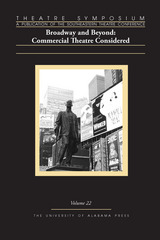 Theatre Symposium, Vol. 22: Broadway and Beyond: Commercial Theatre Considered
David S. Thompson
University of Alabama Press, 2014 That theatre is a business remains a truth often ignored by theatre insiders and consumers of the performing arts alike. The essays in Theatre Symposium, Volume 22 explore theatre as a commercial enterprise both historically and as a continuing part of the creation, production, and presentation of contemporary live performance.
The eleven contributors to this fascinating collection illuminate many aspects of commercial theatre and how best to examine it. George Pate analyzes the high-stakes implication of a melodramatic legal battle. Christine Woodworth recounts the difficulties encountered by British actresses near the turn of the twentieth century, while Boone J. Hopkins considers newly found images of Margo Jones along with the commercial appeal they represent.
The volume continues with articles that follow developments with ties to commercial theatre, such as the interplay between Broadway companies and regional theatres, musical productions in communist Poland, and the influence of Korean popular culture on theatre and the unique production arrangements that have resulted. Other essays investigate alternative concepts related to commercial themes with regard to audience interaction and the burgeoning world of geek theatre.
Edited by David S. Thompson, this latest publication by the largest regional theatre organization in the United States collects the most current scholarship on theatre history and theory.
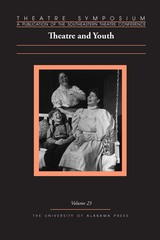 Theatre Symposium, Vol. 23: Theatre and Youth
David S. Thompson
University of Alabama Press, 2015 The curtain rises on Theatre and Youth, volume 23 of Theatre Symposium with keynote reflections by Suzan Zeder, the distinguished playwright of theatre for youth, and presents eleven original essays about theatre’s reflections of youth and the role of young people in making and performing theatre.
The first set of essays draws from robustly diverse sources: the work of Frank Wedekind in nineteenth-century Germany, Peter Pan’s several stage incarnations, Evgeny Shvarts’s antitotalitarian plays in Soviet Russia, and Christopher Marlowe’s Dido, Queen of Carthage, whose depictions of childhood comment on both the classical period as well as Marlowe’s own Elizabethan age.
The second part of the collection explores and illustrates how youth participate in theatre, the cognitive benefits youth reap from theatre practice, and the ameliorating power of theatre to help at-risk youth. These essays show fascinating and valuable case studies of, for example, theatre employed in geography curricula to strengthen spatial thinking, theatre as an antidote to youth delinquency, and theatre teaching Latinos in the south strategies for coping in a multilingual world.
Rounding out this exemplary collection are a pair of essays that survey the state of the art, the significance of theatre-for-youth programming choices, and the shifting attitudes young Americans are bringing to the discipline. Eclectic and vital, this expertly curated collection will be of interest to educators and theatre professionals alike.
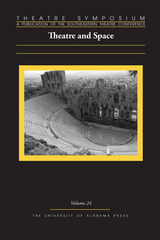 Theatre Symposium, Vol. 24: Theatre and Space
Edited by Becky K. Becker
University of Alabama Press, 2016 Exploring the dynamic intersections of performance and place. At a time when so many options exist for access to theatrical entertainments, it is no surprise that theatre practitioners and scholars are often preoccupied with the role of the audience. While space undoubtedly impacts the rehearsal and production processes, its greater significance seems to rest in the impact a specific location has on the audience.
This volume provides diverse viewpoints on theatre and space, as well as its relationship to the audience. Sebastian Trainor and Samuel T. Shanks offer contemporary perspectives on two ancient theatre spaces, while Lisa Marie Bowler describes the Globe Theatre, a replica of the original, as embodying a kind of absence despite its rich link to the past. Focusing on distinctly different periods and settings, both Andrew Gibb and Christine Woodworth describe a politics of space in which specific players gain prestige and power. Chase Bringardner identifies the audience as playing an important role in creating a space for parody in a historic Nashville venue, while Arnab Banerji describes an exhausting process for members of the Bengali group theatre who must continually move from space to space. Finally, Alicia Corts discusses virtual performance spaces and the degree to which participants are able to control their online identities within virtual performances. Bookending these eight essays are Marvin Carlson’s keynote presentation “Whose Space Is It Anyway?” and his closing remarks for the symposium, both of which allude to, and richly explicate, the ultimate arbiters of theatrical space: the audience.
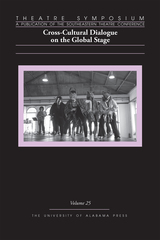 Theatre Symposium, Vol. 25: Cross-Cultural Dialogue on the Global Stage
Edited by Becky K. Becker
University of Alabama Press, 2017 Addresses the ways that theatre both shapes cross-cultural dialogue and is itself, in turn, shaped by those forces. Globalization may strike many as a phenomenon of our own historical moment, but it is truly as old as civilization: we need only look to the ancient Silk Road linking the Far East to the Mediterranean in order to find some of the earliest recorded impacts of people and goods crossing borders. Yet, in the current cultural moment, tensions are high due to increased migration, economic unpredictability, complicated acts of local and global terror, and heightened political divisions all over the world. Thus globalization seems new and a threat to our ways of life, to our nations, and to our cultures. In what ways have theatre practitioners, educators, and scholars worked to support cross-cultural dialogue historically? And in what ways might theatre embrace the complexities and contradictions inherent in any meaningful exchange? The essays in Theatre Symposium, Volume 25 reflect on these questions. Featured in Theatre Symposium, Volume 25 - “Theatre as Cultural Exchange: Stages and Studios of Learning” by Anita Gonzalez
- “Certain Kinds of Dances Used among Them: An Initial Inquiry into Colonial Spanish Encounters with the Areytos of the Taíno in Puerto Rico” by E. Bert Wallace
- “Gertrude Hoffmann’s Lawful Piracy: ‘A Vision of Salome’ and the Russian Season as Transatlantic Production Impersonations” by Sunny Stalter-Pace
- “Greasing the Global: Princess Lotus Blossom and the Fabrication of the ‘Orient’ to Pitch Products in the American Medicine Show” by Chase Bringardner
- “Dismembering Tennessee Williams: The Global Context of Lee Breuer’s A Streetcar Named Desire” by Daniel Ciba
- “Transformative Cross-Cultural Dialogue in Prague: Americans Creating Czech History Plays” by Karen Berman
- “Finding Common Ground: Lessac Training across Cultures” by Erica Tobolski and Deborah A. Kinghorn
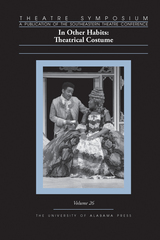 Theatre Symposium, Vol. 26: In Other Habits: Theatrical Costume
Sarah McCarroll
University of Alabama Press, 2018 A substantive exploration of theatrical costume
Stage costumes reveal character. They tell audiences who the character is or how a character functions within the world of the play, among other things. Theatrical costuming, however, along with other forms of theatre design, has often been considered merely a craft, rather than part of the deeply systemic creation of meaning onstage. In what ways do our clothes shape and reveal our habits of behavior? How do stage costumes work to reveal one kind of habit via the manipulation of another? How might theatre practitioners learn to most effectively exploit this dynamic? Theatre Symposium, Volume 26 analyzes the ways in which meaning is conveyed through costuming for the stage and explores the underlying assumptions embedded in theatrical practice and costume production.
THEATRE SYMPOSIUM, VOLUME 26
MICHELE MAJER
Plus que Reine: The Napoleonic Revival in Belle Epoque Theatre and Fashion
CAITLIN QUINN
Creating a Realistic Rendering Pedagogy: The Fashion Illustration Problem
ALY RENEE AMIDEI
Where'd I Put My Character?: The Costume Character Body and Essential Costuming for the Ensemble Actor
KYLA KAZUSCHYK
Embracing the Chaos: Creating Costumes for Devised Work
DAVID S. THOMPSON
Dressing the Image: Costumes in Printed Theatrical Advertising
LEAH LOWE
Costuming the Audience: Gentility, Consumption, and the Lady’s Theatre Hat in Gilded Age America
JORGE SANDOVAL
The RuPaul Effect: The Exploration of the Costuming Rituals of Drag Culture in Social Media and the Theatrical Performativity of the Male Body in the Ambit of the Everyday
GREGORY S. CARR
A Brand New Day on Broadway: The Genius of Geoffrey Holder’s Artistry and His Intentional Evocation of the African Diaspora
ANDREW GIBB
On the [Historical] Sublime: J. R. Planché’s King John and the Romantic Ideal of the Past
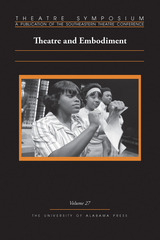 Theatre Symposium, Vol. 27: Theatre and Embodiment
Edited by Sarah McCarroll
University of Alabama Press, 2019 A substantive exploration of bodies and embodiment in theatre
Theatre is inescapably about bodies. By definition, theatre requires the live bodies of performers in the same space and at the same time as the live bodies of an audience. And, yet, it’s hard to talk about bodies. We talk about characters; we talk about actors; we talk about costume and movement. But we often approach these as identities or processes layered onto bodies, rather than as inescapably entwined with them. Bodies on the theatrical stage hold the power of transformation. Theatre practitioners, scholars, and educators must think about what bodies go where onstage and what stories which bodies to tell.
The essays in Theatre Symposium, Volume 27 explore a broad range of issues related to embodiment. The volume begins with Rhonda Blair’s keynote essay, in which she provides an overview of the current cognitive science underpinning our understanding of what it means to be “embodied” and to talk about “embodiment.” She also provides a set of goals and cautions for theatre artists engaging with the available science on embodiment, while issuing a call for the absolute necessity for that engagement, given the primacy of the body to the theatrical act.
The following three essays provide examinations of historical bodies in performance. Timothy Pyles works to shift the common textual focus of Racinian scholarship to a more embodied understanding through his examination of the performances of the young female students of the Saint-Cyr academy in two of Racine’s Biblical plays. Shifting forward in time by three centuries, Travis Stern’s exploration of the auratic celebrity of baseball player Mike Kelly uncovers the ways in which bodies may retain the ghosts of their former selves long after physical ability and wealth are gone. Laurence D. Smith’s investigation of actress Manda Björling’s performances in Miss Julie provides a model for how cognitive science, in this case theories of cognitive blending, can be integrated with archival theatrical research and scholarship.
From scholarship grounded in analysis of historical bodies and embodiment, the volume shifts to pedagogical concerns. Kaja Amado Dunn’s essay on the ways in which careless selection of working texts can inflict embodied harm on students of color issues an imperative call for careful and intentional classroom practice in theatre training programs. Cohen Ambrose’s theorization of pedagogical cognitive ecologies, in which subjects usually taught disparately (acting, theatre history, costume design, for example) could be approached collaboratively and through embodiment, speaks to ways in which this call might be answered.
Tessa Carr’s essay on "The Integration of Tuskegee High School" brings together ideas of historical bodies and embodiment in the academic theatrical context through an examination of the process of creating a documentary theatre production. The final piece in the volume, Bridget Sundin’s exchange with the ghost of Marlene Dietrich, is an imaginative exploration of how it is possible to open the archive, to create new spaces for performance scholarship, via an interaction with the body.
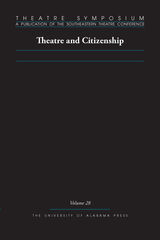 Theatre Symposium, Vol. 28: Theatre and Citizenship
Edited by Andrew Gibb
University of Alabama Press, 2020 A collection of essays whose authors reach beyond simple definitions of citizenship as determined by documents and legal rights
The scholarly conference from which this publication emerged was circulated in the waning months of 2018, following a summer of urgent and emotional debate surrounding new US immigration policies regarding immigrant family separations, arguments fueled on one side by fears about the loss of social cohesion, and on the other by photographs of incarcerated children. Given the then-prevailing political atmosphere, editor Andrew Gibb anticipated that a good number of submissions might draw connections between the patterns, policies, and histories of immigration on the one hand, and theatrical or otherwise performance-centered expressions of citizenship, whether inclusive or exclusionary, on the other. In retrospect, what could have been foreseen is that theatre scholars, educators, and professionals would interpret recent events against a wider and more complex backdrop. The ultimate result of that initial call is this volume, a collection of essays whose authors reach beyond simple definitions of citizenship as determined by documents and legal rights, and who engage in larger conversations about what citizenship can mean, and how such meanings are expressed through theatre and performance.
Interestingly, while none of the authors published herein take up immigration as a central issue, they all make use of some combination of three particular analytical frameworks, all of which happen to be pertinent to the current immigrant experience and attempts to regulate it: bodies, institutions, and technologies.
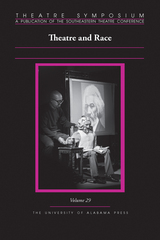 Theatre Symposium, Vol. 29: Theatre and Race
Edited by Andrew Gibb
University of Alabama Press, 2022 Essays whose composition and editing were undertaken almost entirely within the transformed cultural and professional landscape of 2020 A few weeks prior to the submission deadline for this volume of Theatre Symposium, the murder of George Floyd by officers of the Minneapolis Police Department sparked a movement for racial justice that reverberated at every level of US society. At predominantly and historically white academic institutions (including Theatre Symposium and its parent organization, the Southeastern Theatre Conference) leaders were compelled, as perhaps never before, to account for the role of systematic racism in the foundation and perpetuation of their organizations. While the present volume’s theme of “Theatre and Race” was announced in the waning days of 2019, the composition and editing of the issue’s essays were undertaken almost entirely within the transformed cultural and professional landscape of 2020. Throughout its twenty-nine years of publication, Theatre Symposium’s pages have included many excellent essays whose authors have deployed theories of race as an analytical framework, and (less often) treated BIPOC-centered art and artists as subject. The intent of the current editors in conceiving this issue was to center such subjects and theorizations, a goal that has since taken on a more widely recognized urgency. Taken together, these twelve essays represent a wide range of scholarly responses to the theme of “theatre and race.” The fact that there is so much to say on the topic, from so many different perspectives, is a sign of how profoundly theatre practices have been—and continue to be—shaped by racial discourses and their material manifestations.
Theatre Symposium, Vol. 3: Voice of the Dramaturg
Paul Castagno
University of Alabama Press, 1995 As both a verb and a noun, the word voice has many meanings and functions on multiple levels, a phenomenon that is remarkably analogous to the practice of dramaturgy. Thus, the topic title Voice of the Dramaturg allows for the requisite flexibility and provides a unifying theme for the third volume of Theatre Symposium. This volume of the proceedings from the June 1994 joint meeting of the Southeastern Theatre Conference and the Literary Managers and Dramaturgs in Atlanta, Georgia, addresses the question, What is Dramaturgy? Part I includes the contributions of the six symposium participants and concludes with the roundtable discussion by panelists. Part II is composed of refereed papers. These papers range from the highly theoretical to the practical and pedagogical. They reflect the diversity of what dramaturgy means in contemporary theatre.
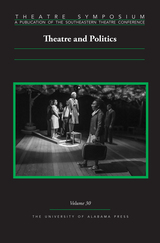 Theatre Symposium, Vol. 30: Theatre and Politics
edited by Chase Bringardner
University of Alabama Press, 2023 For the thirtieth volume of Theatre Symposium, the editors return to a topic first proposed over twenty years ago in volume 9 (theatre and politics in the twentieth century), reimaged for a broader, more comprehensive time frame. In this volume on theater and politics, scholars explore what constitutes the political, how the political is performed, and how theatre engages with politics over time, drawing on the following framing questions: What is the historical and ongoing role of theatre in framing our ideas and conversations about politics? How do politics and theatre engage one another in an increasingly mediated landscape? From theatrical analysis of the political arena to political analysis of the theatrical stage, discussions of theatre and politics can challenge ethical, theoretical, and artistic considerations of our world.
The current moment presents a compelling opportunity to revisit, revise, and reengage. Certainly, in the twenty-one volumes since volume 9, the political landscape both nationally and internationally has shifted dramatically. The past two years specifically have seen an increase in the already prevalent presence of the political in our daily discourse. The COVID-19 global pandemic and ongoing racial reckonings have further unmoored many systems and structures, requiring action and change. Rather than a moment of pause or passivity, pandemic times have seen an increase in political activity and political discourse on the local, national, and global levels. Within the theatre and performance communities, these calls to action have resulted in movements like #weseeyouWAT and other calls to break down old systems and create new ones, to privilege access for those of the global majority, and to explicitly demand advocacy and activism. Organizations like the Southeastern Theatre Conference (SETC) itself crafted new ethos statements and engaged in the necessary work of boldly foregrounding equity, diversity, inclusion, and accessibility at the center of all its efforts.
The editors and contributors to this volume respond to the immediacy of this moment and the clarion call for change. From Shakespeare to new productions like Alabama Love Stories, presented at Auburn University, contributors grapple with a range of examples, contemporary and historical, and argue with renewed urgency for the importance of intentionally interrogating the interplay of performance and politics. The essays in this volume demonstrate that theatre and performance cannot rise to this moment or even begin to address it without doing that substantial work to clean its own house and create accessible new spaces.
Contributors
Chase Bringardner / Tessa Carr / Lily Climenhaga / Abena Foreman-Trice / Emma Givens / TK Manwill / Boomie Pederson / Royal Shirée / Teresa Simone / Tony Tambasco / Jonathon W. Taylor / Justice von Maur / Patricia Ybarra
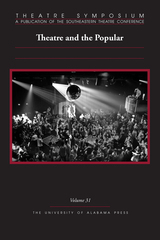 Theatre Symposium, Vol. 31: Theatre and the Popular
Edited by Chase Bringardner
University of Alabama Press, 2024 A new issue of the longstanding theatre journal, documenting conversations that traverse disciplinary boundaries
The essays in the thirty-first volume of Theatre Symposium traverse disciplinary boundaries to explore what constitutes the “popular” in theater and performance in an increasingly frenetic and mediated landscape. Amid the current resurgence of populist discourse and the enduring impact of popular culture, this volume explores what is considered popular, how that determination gets made, and who makes it. The answers to these questions shape the structures and systems of performance in an interaction that is reciprocal, intricate, and multifaceted. Productions often succeed or fail based on their ability to align with what is popular—sometimes productively, sometimes clumsily, sometimes brazenly, and sometimes tragically.
In our current moment, what constitutes the popular profoundly affects the real world politically, economically, and socially. Controversies about the electoral college system hinge on the primacy of the “popular” vote. Streaming services daily update lists of their most popular content and base future decisions on opaque measures of popularity. Social media platforms broadcast popular content across the globe, triggering new products, social activism, and political revolutions.
The contributors to this volume engage with a range of contemporary and historical examples and argue with clarity and acuity the interplay of performance and the popular. Theatre and performance deeply engage with the popular at every level—from audience response to box office revenue. The variety of methodologies and sites of inquiry showcased in this volume demonstrates the breadth and depth of the popular and the importance of such work to understanding our present moment onstage and off.
CONTRIBUTORS
Mysia Anderson / Chase Bringardner / Elizabeth M. Cizmar / Chelsea Curto / Janet M. Davis / Tom Fish / Kyla Kazuschyk / Sarah McCarroll / Eleanor Owicki / Sunny Stalter-Pace / Chelsea Taylor / Chris Woodworth
|
|
